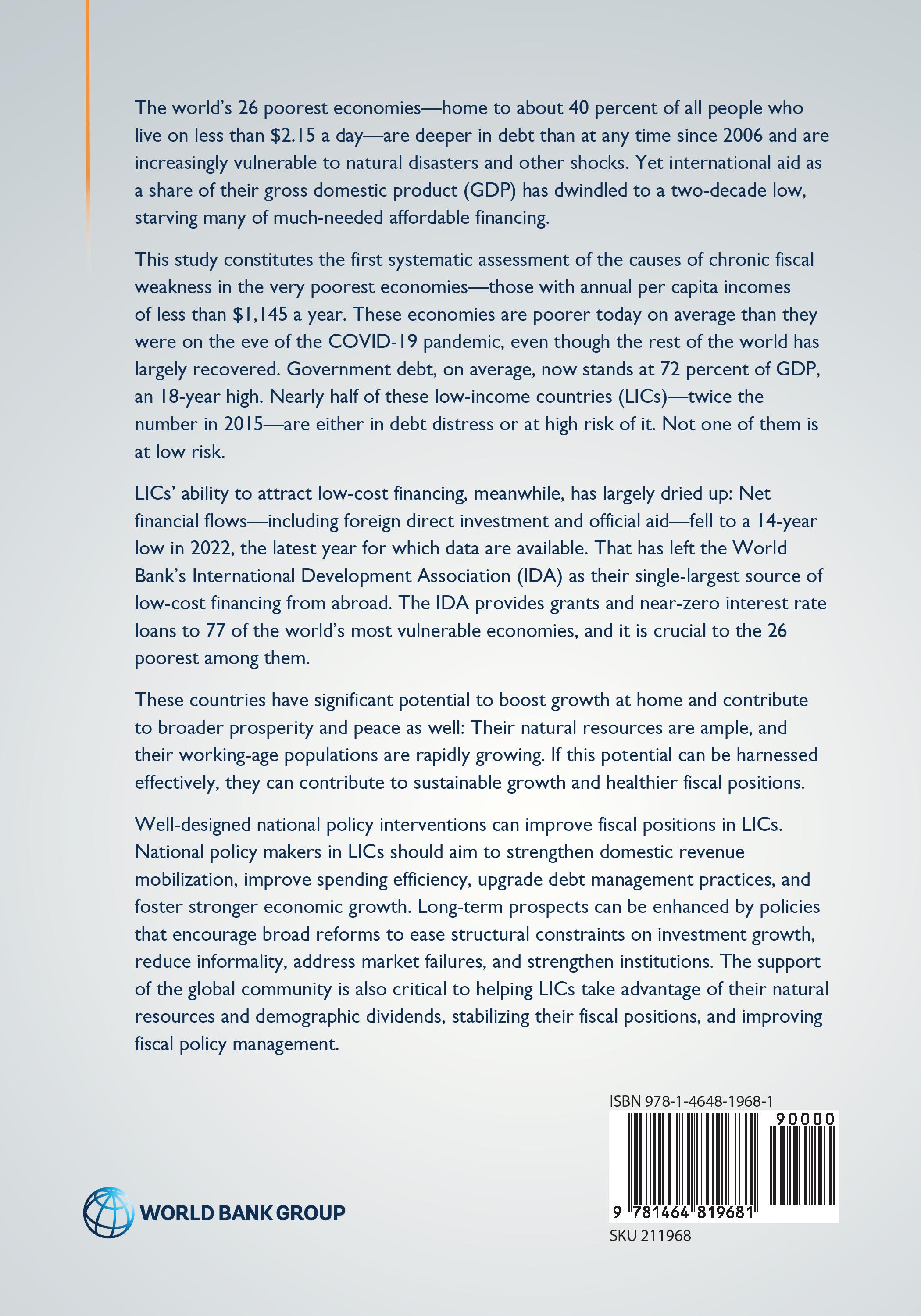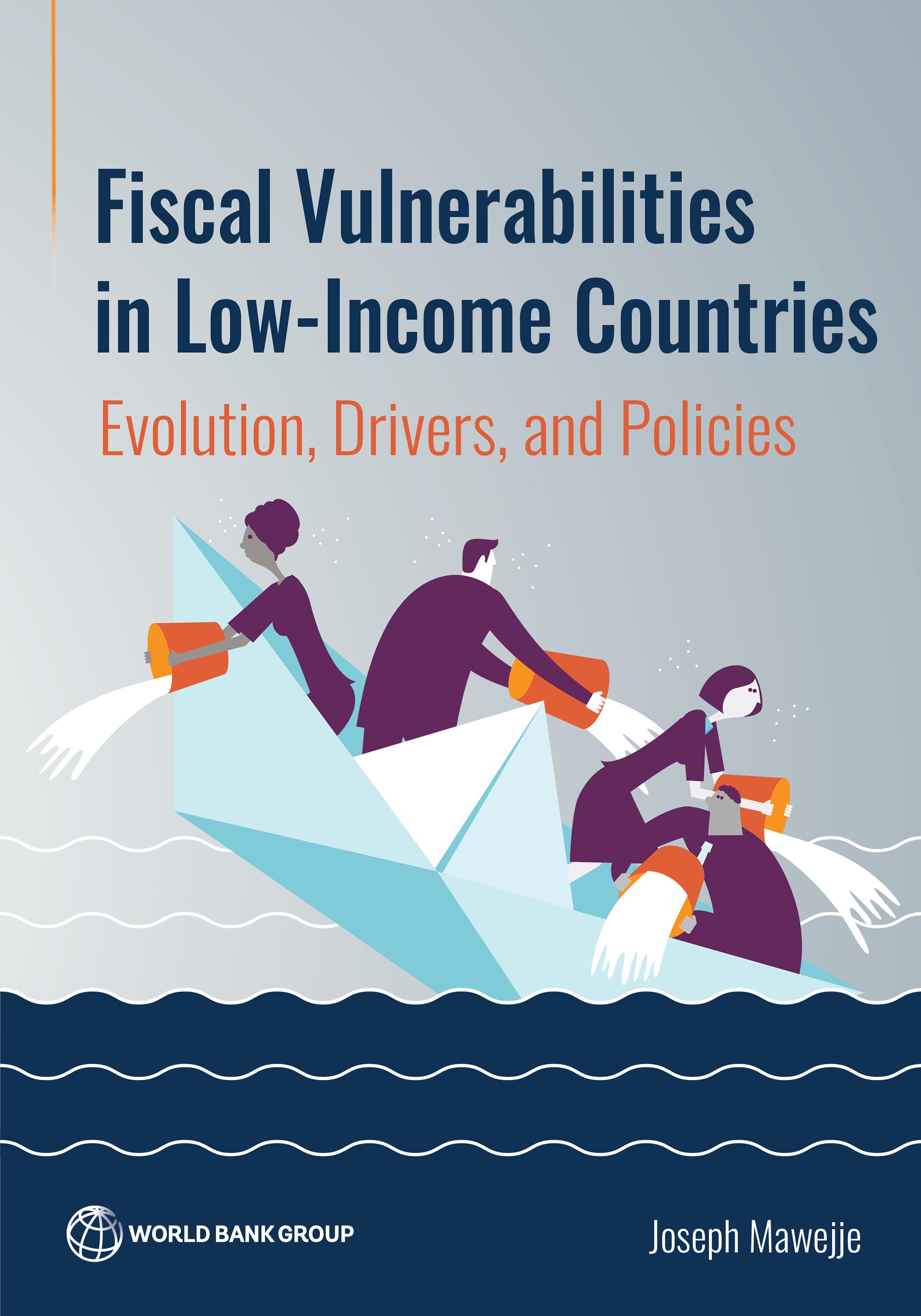

Fiscal Vulnerabilities in Low-Income Countries
This book, along with any associated content or subsequent updates, can be accessed at https://hdl.handle.net/10986/42239.

www.worldbank.org/prospects
Fiscal Vulnerabilities in Low-Income Countries
Evolution, Drivers, and Policies

Joseph Mawejje
WORLD BANK GROUP
© 2025 International Bank for Reconstruction and Development/ The World Bank 1818 H Street NW, Washington, DC 20433
Telephone: 202-473-1000; Internet: www.worldbank.org
Some rights reserved
1 2 3 4 28 27 26 25
This work is a product of the staff of The World Bank with external contributions. The findings, interpretations, and conclusions expressed in this work do not necessarily reflect the views of The World Bank, its Board of Executive Directors, or the governments they represent.
The World Bank does not guarantee the accuracy, completeness, or currency of the data included in this work and does not assume responsibility for any errors, omissions, or discrepancies in the information, or liability with respect to the use of or failure to use the information, methods, processes, or conclusions set forth. The boundaries, colors, denominations, links/footnotes, and other information shown in this work do not imply any judgment on the part of The World Bank concerning the legal status of any territory or the endorsement or acceptance of such boundaries. The citation of works authored by others does not mean The World Bank endorses the views expressed by those authors or the content of their works.
Nothing herein shall constitute or be construed or considered to be a limitation upon or waiver of the privileges and immunities of The World Bank, all of which are specifically reserved.
Rights and Permissions
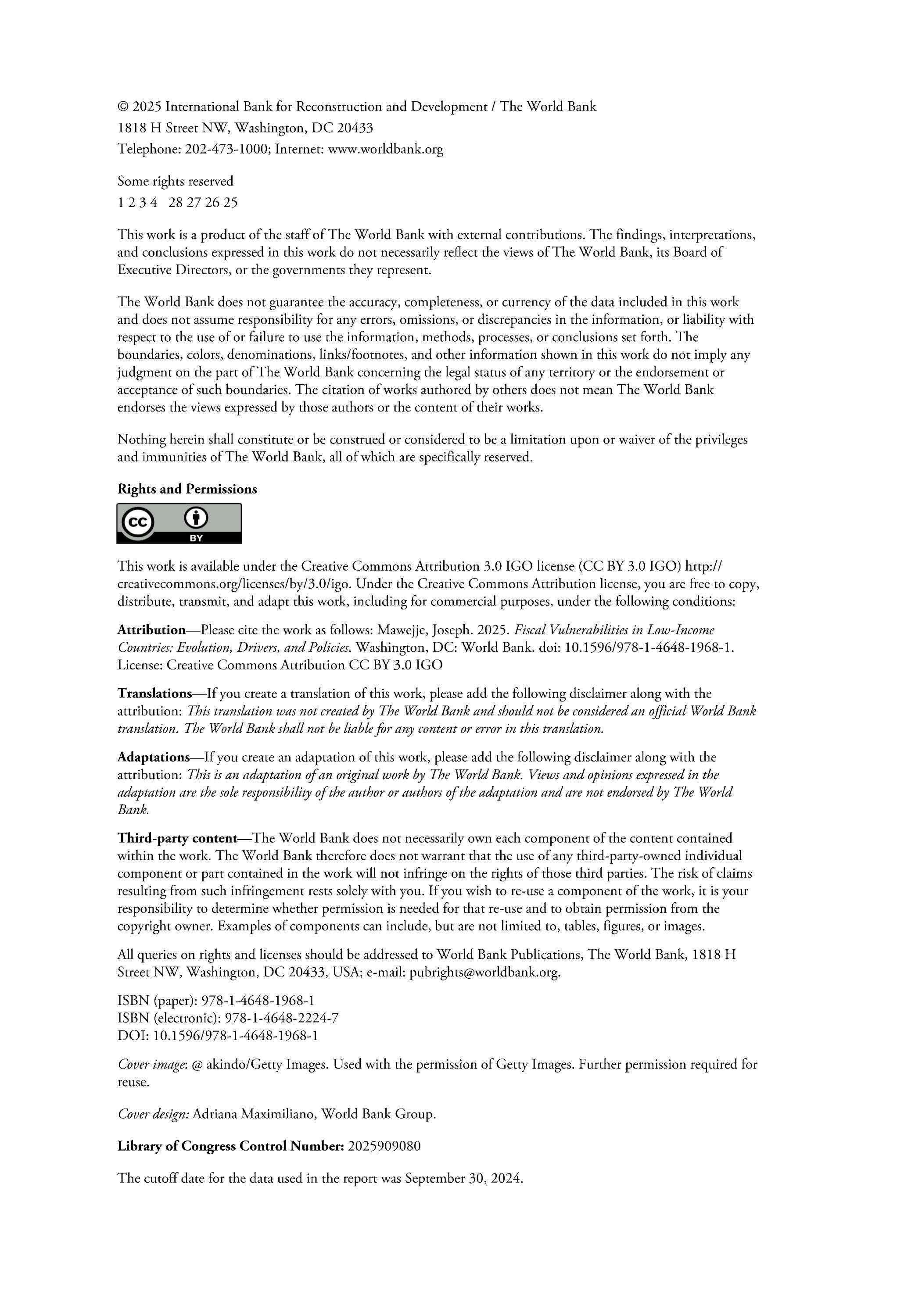
This work is available under the Creative Commons Attribution 3.0 IGO license (CC BY 3.0 IGO) http:// creativecommons.org/licenses/by/3.0/igo. Under the Creative Commons Attribution license, you are free to copy, distribute, transmit, and adapt this work, including for commercial purposes, under the following conditions:
Attribution-Please cite the work as follows: Mawejje, Joseph. 2025. Fiscal Vulnerabilities in Low-Income Countries: Evolution, Drivers, and Policies. Washington, DC: World Bank. doi: 10.1596/978-1-4648-1968-1.
License: Creative Commons Attribution CC BY 3.0 IGO
Translations-If you create a translation of this work, please add the following disclaimer along with the attribution: This translation was not created by The World Bank and should not be considered an official World Bank translation. The World Bank shall not be liable for any content or error in this translation.
Adaptations-If you create an adaptation of this work, please add the following disclaimer along with the attribution: This is an adaptation ofan original work by The World Bank. Views and opinions expressed in the adaptation are the sole responsibility of the author or authors of the adaptation and are not endorsed by The World Bank.
Third-party content-The World Bank does not necessarily own each component of the content contained within the work. The World Bank therefore does not warrant that the use of any third-party-owned individual component or part contained in the work will not infringe on the rights of those third parties. The risk of claims resulting from such infringement rests solely with you. If you wish to re-use a component of the work, it is your responsibility to determine whether permission is needed for that re-use and to obtain permission from the copyright owner. Examples of components can include, but are not limited to, tables, figures, or images.
All queries on rights and licenses should be addressed to World Bank Publications, The World Bank, 1818 H Street NW, Washington, DC 20433, USA; e-mail: pubrights@worldbank.org.
ISBN (paper): 978-1-4648-1968-1
ISBN (electronic): 978-1-4648-2224-7
DOI: 10.1596/978-1-4648-1968-1
Cover image: @ akindo/Getty Images. Used with the permission of Getty Images. Further permission required for reuse.
Cover design: Adriana Maximiliano, World Bank Group.
Library of Congress Control Number: 2025909080
The cutoff date for the data used in the report was September 30, 2024.
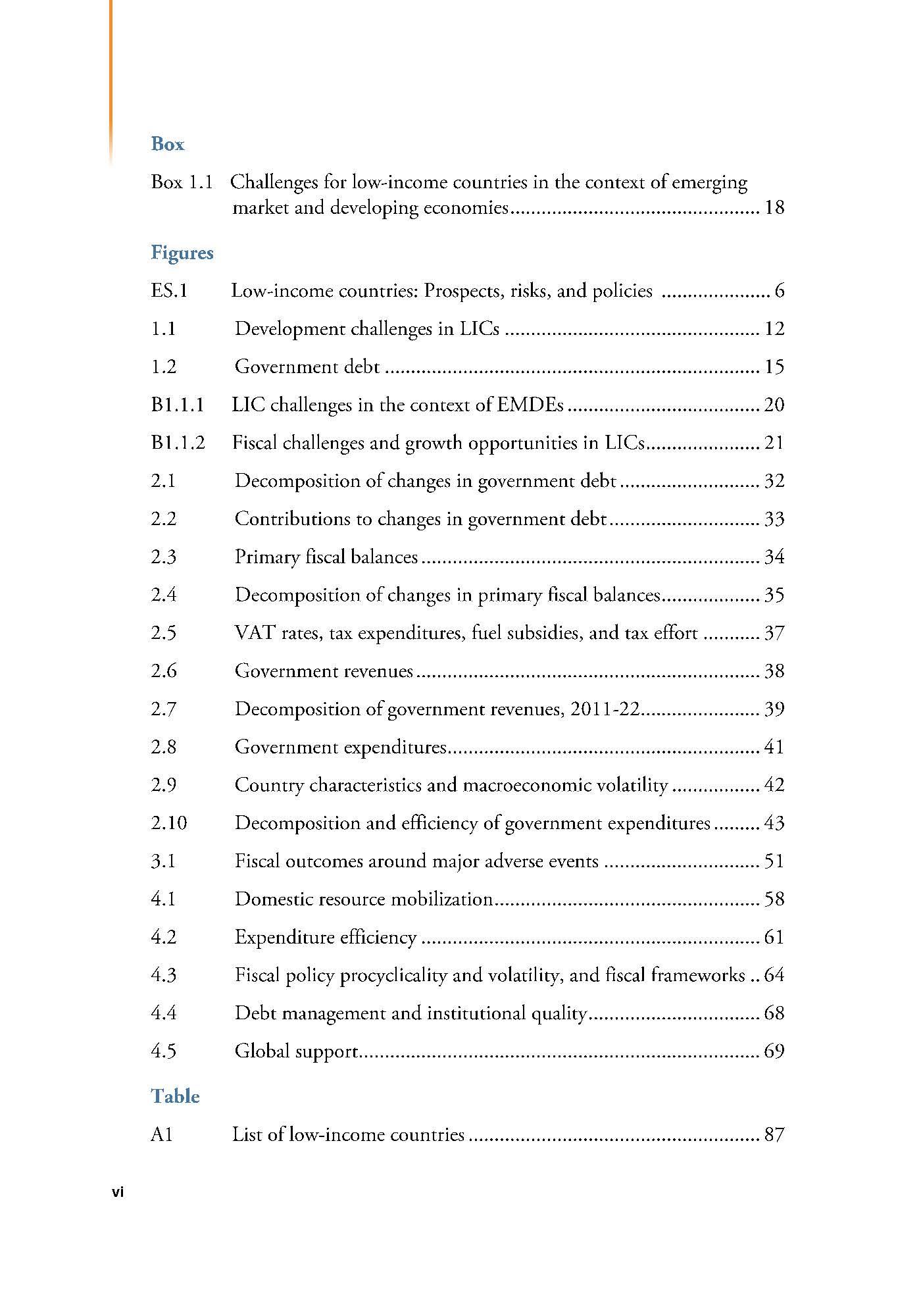
Acknowledgments
This study is a product of the Prospects Group and was produced under the overall guidance of M. Ayhan Kose. Ayhan's constant support, insights, and dedication immeasurably raised the quality of the study. The study also benefited from the outstanding support and advice of Carlos Arteta.
The study benefited from insightful reviews and thoughtful suggestions by Tommy Chrimes, Graham Hacche, Samuel Hill, Jeetendra Khadan, and Joseph Rebello. Franziska Ohnsorge and Shu Yu provided excellent inputs to an earlier version of the study. I am grateful for the superb research assistance provided by Jiayue Fan and Maria Hazel Macadangdang.
I am thankful to my colleagues in the World Bank's Prospects Group who provided early feedback at internal seminars. ln addition, staff members from World Bank country teams, the Development Finance Vice Presidency, and other World Bank Vice Presidencies provided extensive comments at different stages of the study, including during the institution-wide review of a chapter on fiscal challenges confronting low-income countries featured in the June 2023 Global Economic Prospects report.
I am indebted to many colleagues who worked on the production process, publishing, media relations, and dissemination of the study. I am grateful to Joseph Rebello for his considered suggestions throughout the process, and with him, Nandita Roy, Kristen Milhollin, and Mariana Lozzi Teixeira for managing media relations and social media outreach. I thank Graeme Littler for editorial and web support. I owe a particular debt of gratitude to Adriana Maximiliano for her outstanding contributions in designing and coordinating the print publication.
About the Author
Joseph Mawejje is an economist in the World Bank Group's Prospects Group. Previously, he worked in the World Bank Group's Macroeconomics, Trade, and Investment Global Practice for the Eas t ern and Southern Africa region. Before that, he worked in different capacities at the Economic Policy Research Centre and the Private Sector Foundation in Kampala, Uganda.
Abbreviations
AE
DeMPA
EMDE
J:<CSs
FDT
GDP
GNI
IDA
IDS
IMF
UC
MIC
ODA
PIMI
SDFP
SDGs
SWF
UCDP
VAT
WDI
WEO
advanced economy
debt management performance assessments
emerging market and developing economy
fragile and conflict-affected situations
foreign direct investment
gross domestic product
gross national income
International Development Association
International Debt Statistics
International Monetary Fund
low-income country
middle-income country
official development assistance
Public Investment Managemenr Index
Sustainable Development Finance Policy
Sustainable Development Goals
sovereign wealth fund
Uppsala Conflict Data Program
value added tax
World Development Indicators
World Economic O u tlook
All dollar amounts are US dollars unless otherwise indicated.

Executive Summary
Low-income countries (LICs) need significant resources to meet enormous development challenges.
The 26 countries currently classified as LICs by the World Bank (hereafter, "the 26 current LICs")-the world's poorest countries-account for just a little more than 0 . 5 percent of global output and income, but they are home to almost 10 percent of the world's population and nearly 40 percent of the world's poor. Two-thirds of current LICs (17 out of the 26) are classified as fragile and conflict-affected situations (FCSs). The COVID-19 pandemic and subsequent overlapping crises have put LICs' progress toward convergence with both advanced economy and other EMDE income levels into reverse. In the poorest LI Cs-those with more than half of their populations below the extreme poverty line-average per capita income between 2020 and 2024 took a particular hit, falling by up to 14 percent relative to its pre-pandemic trend. To meet critical development goals, LICs will need additional annual investment, relative to that currently projected, equivalent to 8 percent of their gross domestic product (GDP) through 2030. In other words, these countries will need to double the average annual investment they have made in development over the past decade.
Fiscal positions in LICs have weakened significantly in recent years.
The average government-debt-to-GDP ratio in LICs increased by 9 percentage points in 2023 alone-the largest annual rise in more than two decades-to 72 percent. Debt (relative to GDP) among LICs has built up in a widespread way since 2020, climbing in 80 percent of these countries. Rising debt and global interest rates have sharply increased LICs' debt-service payments. In 2023, interest payments for the average LIC exceeded 10 percent of revenue: the highest level in two decades. Government gross financing needs in the average LI C rose by 3 percentage points of GDP between 2019 and 2022 to reach about 11.5 percent of GDP. As of the end of April 2024, the International Monetary Fund assessed none of the 26 current LI Cs as being at low risk of debt distress, and many of chem were judged to be already in or at high risk of it. Even among LICs at only moderate risk of debt distress, however, safety margins have eroded. Large and widening fiscal deficits, in main, have driven the increase in LIC
government debt relative to GDP Average fiscal deficits in LICs expanded markedly between 2019 (1.2 percent) and 2023 (2.4 percent).
L/Cs face long-standing challenges in mobilizing domestic revenues.
LICs generally have lower levels of tax effort (the extent to which actual tax collections reach total tax potential) than other emerging market and developing economies (EMDEs). Over 2011-23, LICs are estimated to have collected, on average, less than two-thirds of their potential tax revenues, mobilizing total revenues equivalent to about 18 percent of GDP: 11 percentage points lower than the figure for other EMDEs. Several structural factors impede LICs from raising tax revenues: underdeveloped financial sectors, limited use of information te chnology, and high levels of informality. Over the past decade, informal sector activity in LI Cs has accounted for an estimated 37 percent of GDP, compared with 24 percent in other EMDEs. At the same time, tax expenditures (such as exemptions, special deductions, and tax credits) absorb a sizable amount of tax revenues in LI Cs, averaging more than 2 percent of GDP .
Government spending in L/Cs has lower efficiency than that in other EMDEs.
In part, the lower efficiency of government spending in LICs reflects weaker institutions and a greater incidence of corruption. In addition, subsidies, particularly those for food and energy , are pervasive and tend to be poorly targeted and costly. Fuel subsidies in LICs in 2022 cost an average of about 2 percent of GDP-more than these countries' average domestic expenditure on health Many LICs also are prone to large-scale , often unproductive spending, including spending on the military, as well as excessive civil service employment , and these often crowd out growth-enhancing public spending on human capital and other development needs. Government spending on education and health (as a share of GDP) is 2 percentage points lower in LICs than that in other EMDEs, even as human capital needs in LICs tend to be greater .
L/Cfiscal positions are vulnerable to both global and domestic shocks.
Among myriad shocks that can hit LICs, two are particularly pernicious: global recessions and domestic armed conflicts .
Global recessions are associated with deteriorations in LICs ' fiscal balances averaging 1.7 percentage points of GDP in the initial recession year, with the impact lasting for two years. Gove rnment debt increases, on average, by 2 percentage points of GDP in the initial recession year. For commodityexporting LICs , reduced demand for commodities during global recessions generally lowers levels of fiscal revenues. Declines in remittances generally lower tax revenues in recipient LICs through their effects on private
consumption and investment. Another common feature of global recessions, reductions in official development assistance (ODA), affects government revenues directly in many LICs
Around intense conflicts, relative to conflict-free years, fiscal balances in LI Cs, on average, deteriorate by 1- 1.5 percentage points of GDP. Domestic armed conflicts have the potential to affect fiscal positions through various channels. First, conflict directly disrupts economic activity Second, it destroys physical and human capital , which in turn reduces productive potential (and therefore hits potential revenues). Third, conflict generally increases military spending, which erodes fiscal positions. Fourth, conflict weakens revenue administration capacity and generally diminishes institutional quality
In addition, the increasing incidence and magnitude of weather-related natural disasters also poses an additional fiscal challenge for LICs. Natural disasters cost more as a share of GDP in LI Cs than elsewhere; it also costs LI Cs more to adapt to climate change than other EMDEs, and their fiscal buffers are lower.
Because L/Cs constitute the poorest group among EMDEs, much greater development andfiscal challenges confront them.
Given their scarce fiscal resources and great development needs, LICs require substantial international support. They are in a precarious situation: other developing economies have recovered at least somewhat from the pandemicrelated recession of the early 2020s, but the gap in incomes between LICs and other developing economies has only widened (see figure ES. I and box 1. 1).
Rising debt and interest rates have increased interest payments in LICs even more sharply than in other country groups, reducing the resources currently available to LICs for investment in growth-enhancing sectors, including health, education, infrastructure, and climate change adaptation
L/Cs have substantial potential, however, to improve their growth and development prospects.
To confront these challenges, LICs have a range of opportunities to accelerate growth and development and thus expand their fiscal space, if they pursue appropriate reform efforts and the global community provides the necessary support. A number of LICs have abundant oil and gas resources and mineral deposits and significant potential for solar energy and tourism. With the right governance , these could generate significant growth and revenues. LICs can also reap large dividends as their working-age populations grow significantly over the next half century, provided they can equip these workers with the right
FIGURE ES.1 Low-income countries: Prospects, risks, and policies
Since 2000, the income gap between L/Cs and other EMDEs has widened-particularly following the 2020 pandemic recession-underscoring L/Cs ' particularly precarious situation. About 40 percent of the world 's extreme poor live in L/Cs. Debt has built up faster and in a more widespread manner in L/Cs than in other EMDEs, with L/C governments ' net interest payments increasing significantly between 2019 and 2023. Relative to that in other EMDEs, a larger share of L/Cs are in or at high risk of debt distress Although /DA financing has increased, the total amount of grants received by L/Cs has declined.
A Real GDP per capita in LICs relative to that in other EMDEs
Grants received by LICs
Sources: International Debt Statistics (database); International Monetary Fund ; World Bank
Note : EMDEs = emerging market and developing economies; GDP= gross domestic product; GNI = gross national income; IDA= International Development Association ; LICs = low-income countries ; Other EMDEs = emerging market and developing economies excluding LICs; RHS = right-hand scale.
A. Bars show the average real GDP per capita in LICs relative to that in other EMDEs. Based on data for up to 24 LICs and 127 other EMDEs.
B. Number of poor in the 26 countries currently classified as LICs by the World Bank and in the rest of the world.
C. Bars show unweighted averages. Orange whiskers show the interquartile ranges. Based on data for up to 23 LICs and 128 other EMDEs.
D. Net interest payments are defined as the difference between the primary balance and the overall balance. Unweighted average. Orange w hiskers show interquartile ranges.
E Percent of EMDEs in or at risk of debt distress Based on data for 70 EMDEs , of which 24 are LICs
F. "Grants" are defined as legally binding commitments allocating specific funds for disbursement without any requirement for repayment. Data are on a disbursement basis. Data exclude debt forgiveness grants. " IDA grants" are net disbursements of grants from the IDA.
C. Government debt
Share of LICs in or at high risk of debt distress
Number of extreme poor
Net interest payments
capabilities and opportunmes If effectively harnessed, these natural resource endowments and demographic dividends could drive economic growth and transformation.
Well-designed national policy interventions can improve fiscal positions in L/Cs.
To strengthen fiscal posmons in LICs, national policy makers should aim to strengthen domestic revenue mobilization, increase spending efficiency, enhance debt management practices, and foster stronger economic growth
Stronger institutions for tax policy and administration can support domestic revenue mobilization. Improved use of information technology can ease constraints in tax administration and help widen tax bases, by simplifying taxpayer registration, filing, and payment; audit; collection enforcement; and appeals, among other things.
Increased transparency and accountability can improve the efficiency of public spending by reducing waste and improving the returns on public investment, as well as through other beneficial effects. Fiscal transparency and accountability can also boost taxpayer morale and compliance
Credible and well-designed frameworks-including such instruments as fiscal rules, stabilization funds, and medium-term expenditure frameworkscan enhance fiscal sustainability and debt management practices. They can also help LICs improve budget management, including the management of revenue windfalls In addition, they can reduce the procyclicality of fiscal policy, build fiscal space, and strengthen policy outcomes
Policies that encourage broad reforms to ease structural constraints on investment growth, reduce informality, address market failures, and strengthen institutions can enhance LICs' long-term growth prospects.
The support of the global community is critical to helping L/Cs take advantage of their natural resources and demographic dividends, thereby stabilizing their fiscal positions and improving their fiscal policy management.
Even though their fiscal challenges have become acute, net ODA to LICsincluding disbursements of loans made on concessional terms-has declined to its lowest level as a share of recipients' gross national income in two decades. Between 2020 and 2022, total net ODA to LICs declined by 5 percentage points of GDP to an average of? percent
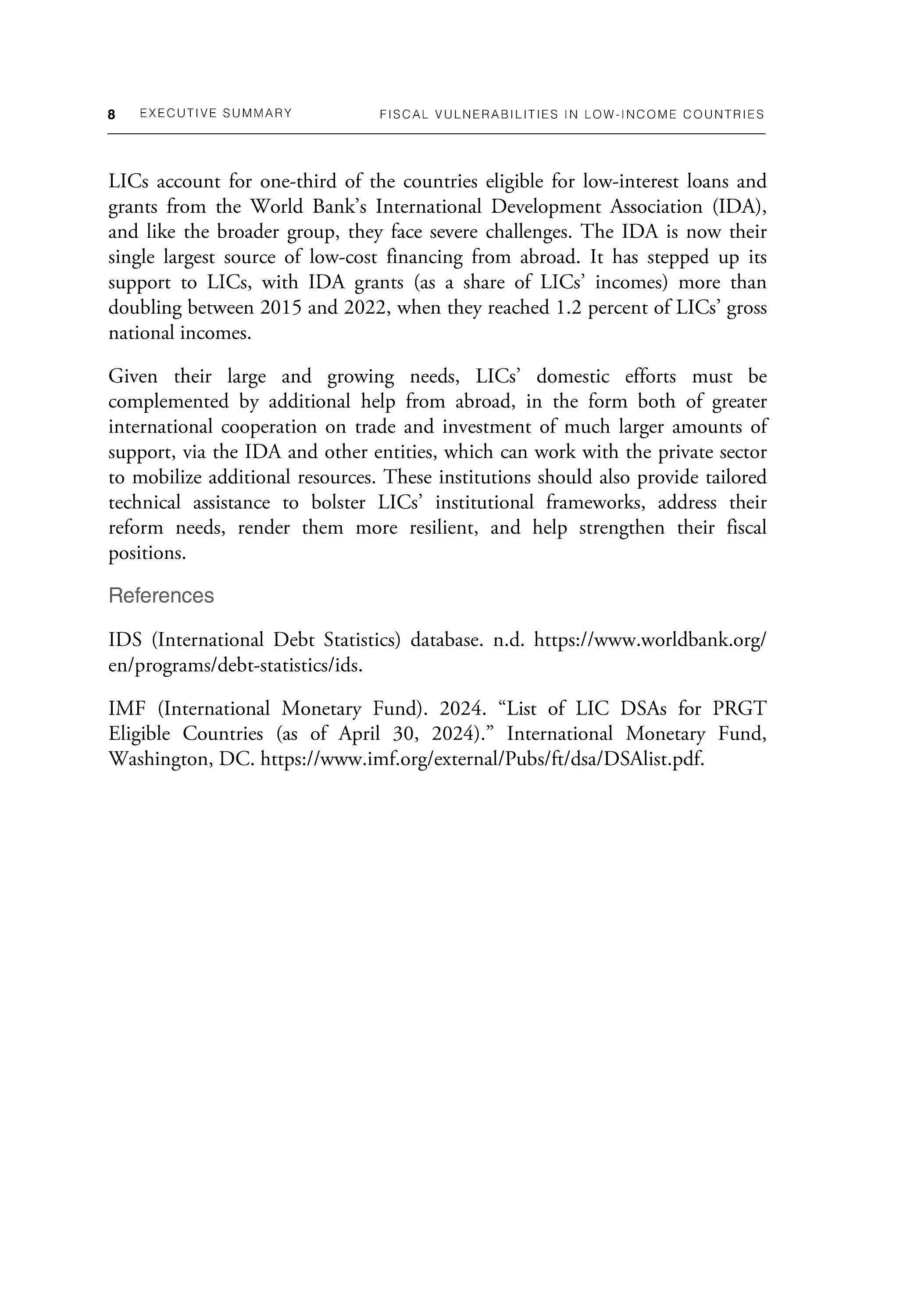
LICs account for one-third of the countries eligible for low-interest loans and grants from the World Bank's International Development Association (IDA), and like the broader group, they face severe challenges The IDA is now their single largest source of low-cost financing from abroad. It has stepped up its support to LICs, with IDA grants (as a share of LICs' incomes) more than doubling between 2015 and 2022, when they reached 1.2 percent of LICs' gross national incomes.
Given their large and growing needs, LICs' domestic efforts must be complemented by additional help from abroad, in the form both of greater international cooperation on trade and investment of much larger amounts of support, via the IDA and other entities, which can work with the private sector to mobilize additional resources. These institutions should also provide tailored technical assistance to bolster LICs' institutional frameworks, address their reform needs, render them more resilient, and help strengthen their fiscal positions.
References
IDS (International Debt Statistics) database. n.d. https:/ /www.worldbank.org/ en/ programs/ debt-statistics/ ids.
IMF (International Monetary Fund). 2024. "List of LIC DSAs for PRGT Eligible Countries (as of April 30, 2024)." International Monetary Fund, Washington, DC. https:/ /www.imf.org/ external/Pubs/ft/ dsa/DSAlist .pdf.

1. Introduction
The COVID-19 pandemic and the overlapping global shocks that followed exacerbated low-income countries' (LICs') development challenges and delayed their progress toward the Sustainable Development Goals (SDGs). 1 In 2024, about 40 percent of people in low-income countries were in extreme poverty, up from 36 percent in 2019 . In 2019-20, the 26 current LICs had substantially worse scores on indicators of human development and access to infrastructure than did those LICs that have subsequently graduated to the group of middleincome countries since 2000 (figure 1. 1). In the poorest LI Cs-those with more than half of their populations below the extreme poverty line-average per capita income fell between 2020 and 2024 by up to 14 percent compared with its prepandemic trend. Food insecurity in LICs has also intensified .
The global shocks of the past five years have also contributed to a significant worsening of LICs' fiscal positions. Despite the recovery of 2021-23, government debt in the average LIC is estimated to have risen to 72 percent of gross domestic product (GDP) by the end of that period, a 16-year high. At the end of 2023, government debt exceeded 50 percent of GDP in 81 percent of LICs, compared with less than one-half of other emerging market and developing economies (EMDEs) . LICs' average fiscal deficit in 2023 is estimated to have been 2.4 percent of GDP, about 1.2 percentage points wider than it was in 2019. Government gross financing needs in the average LIC rose by 3 percentage points of GDP between 2019 and 2022 to reach 11.4 percent of GDP (World Bank 2023a).
As a result of rising debt levels and interest rates, government interest payments increased in about one-fifth of LICs between 2019 and 2023, sharply in some cases. Interest payments have absorbed an expanding share of government revenues, exceeding 10 percent on average in 2023, the highest in two decades. The rise in interest payments has increasingly threatened to crowd out critical development spending (UNCTAD 2024; World Bank 20236). Some LICs have already had to commit more resources to interest payments than to domestically financed health spending. Amid high debt and debt-service costs, debt
1
FIGURE 1.1 Development challenges in LICs
About 40 percent of the world's extreme poor live in L/Cs Real GDP per capita in L/Cs has remained below its pre-pandemic trend Today's L!Cs have lower measures of human capital development and access to infrastructure than did countries that were L/Cs in 2000 but have since become MIGs Food insecurity has increased, particularly in conflict-affected countries
B Real GDP per capita
F. Food insecurity in countries experiencing conflict and conflict-free countries
Sources : GRFC (database); WDI (database) ; WEO (database)
Note: EMDEs = emerging market and developing economies ; GDP= gross domestic product ; LICs = low-income countries ; MIGs = middle-income countries; Other EMDEs = emerging market and developing economies excluding LICs ; RHS = right-hand scale.
A. Number of poor in the 26 countries currently classified as LICs by the World Bank and in the rest of the world.
B. Extreme poverty rate is measured as the share of people living on less than $2.15 per day (2017 dollars at purchasing power parity).
Dashed lines show per capita GDP projections in the International Monetary Fund 's October 2019 World Economic Outlook. Based on data for 10 LI Cs w ith extreme poverty rates above 50 percent and 13 LI Cs with extreme poverty rates below 50 percent in 2019. The sample excludes the Democratic Republic of Congo and Niger-both with over half of their populations experiencing extreme poverty C -E. Simple averages. "Latest'' refers to 2020 or the latest year for which data are available. There are 26"Today 's LICs" and 39 "LICs turned MIGs" (countries that were classified as LICs in 2000 but are now classified as MIGs)
F Bars show the number of people in food crisis , that is , those classified as being in Phase 3 in the Integrated Food Security Phase Classification, which describes those in acute food insecurity crisis or worse.
C. Health indicators E Electricity access
D. Education indicators
vulnerabilities are elevated: the International Monetary Fund (2024a) assessed 12 of the 26 current LI Cs as being in or at high risk of debt distress as of the end of April 2024.
In addition to fiscal positions, several other macroeconomic indicators for LICs have deteriorated in recent years. Although inflation began to moderate in these countries in 2024, many commodity and consumer prices have remained elevated (World Bank 2024a, 2024b). LICs' current account balances and terms of trade have deteriorated, and their external positions more broadly are weaker than those in other EMDEs. Although the tepid recovery of economic growth is expected to continue, risks to the near-term outlook in LICs are tilted to the downside, further threatening their fiscal positions. Prospects are particularly feeble for the two-thirds of LI Cs that are in fragile or conflict-affected situations or susceptible to adverse weather events (World Bank 2024a).
Fiscal resources to address LICs' development challenges were already severely constrained before the pandemic. Government revenues averaged 18 percent of GDP during 2011-19, less than half the advanced economy average and 11 percentage points below the average of other EMDEs. 2 Revenues fell short of primary government expenditures, which averaged about 20 percent of GDP, resulting in persistent fiscal deficits and growth of government debt levels. Thus, government debt levels in LI Cs, on average, rose to 67 percent of GDP in 2019 from 36 percent of GDP in 2011.
Against this challenging backdrop, this study examines the following questions
How have fiscal positions evolved in LI Cs?
What have been the main sources of the recent deterioration in LIC fiscal positions?
How do adverse shocks affect fiscal positions in these economies?
Which policies can help improve LICs' fiscal positions?
Contributions
The study contributes to the literature in several ways.
Analysis of LIC fiscal vulnerabilities. The study analyzes comprehensively fiscal vulnerabilities in LICs and the fiscal policy challenges these countries
2 To ensure broad-based representation ofLIC fiscal developments , averages in this study are unweighted unless otherwise sp ec ifi ed
face in the wake of the pandemic and subsequent global shocks, as well as the challenges they faced in the decade before the pandemic. 3 Previous studies have examined the fiscal positions of different groups of EMDEs, including the larger group of lower-middle-income and low-income countries (Chrimes et al. 2024; IMF 2020) . This study focuses exclusively on LI Cs because of their particular characteristics: they rely heavily on grant financing; lack access to international capital markets; have a large share of recipients of debt relief, including assistance through the Heavily Indebted Poor Countries initiative and the Multilateral Debt Relief Initiative; and rely more on commodity revenues than do other EMDEs. Despite external assistance, they have built up debt faster and in a more widespread manner than have other EMDEs (figure 1.2).
Drivers of the key fiscal variables. The study assesses for the first time, in a detailed manner, the main drivers of government debt, revenues, and expenditures in LICs. Whereas previous studies have examined the evolution of LI Cs' debt and its composition, analysis of other fiscal outcomes, such as the composition and efficiency of government spending, has been more limited. 4
Implications of adverse shocks for fiscal positions. The study examines the evolution of government debt and the primary balance around three types of adverse events: global recessions, intense conflicts, and natural disasters. By doing so, it expands the literature on the impact of adverse shocks on LICs' fiscal positions.
Policy priorities. The study discusses key policy interventions for strengthening fiscal positions in LICs. Domestic revenue mobilization is one important element of such strengthening, for which progress on policy work has already taken place (see Junquera-Varela et al. 2017 for an overview). Measures to improve expenditure efficiency are another well-trodden policy area: many countries have undertaken detailed public expenditure reviews, and several sets of guidelines for best practices are available (see Manghee and van den Berg 2012 for water and sanitation and World Bank 2017 a for education) Policy options for improving debt management have received much attention (Kose et al. 20206). Growth in LICs has been a subject of continuous debate (see, for example, IMF 20246). This study analyzes fiscal policy outcomes in LICs comprehensively and provides a rich menu of
3 Throughout thi s study, th e period und er consideration starts in 2011 to exclud e both the global recess ion of 2009 and the robust eco nomic rebound of 20 I 0. Thi s period corresponds to the fourth global wave of d ebt, which Ko se et al. (2020a) identify as starting at the end of 2010.
4 See, for in stance, Ko se et al. (2020a) on the evo lution ofLIC debt and its composition.
FIGURE 1.2 Government debt
Government debt levels rose, relative to GDP, in more than 90 percent of L/Cs and about 80 percent of other EMDEs between 2011 and 2019 , on average by 30 and 15 percentage points of GDP, respectively Between 2019 and 2023, government debt levels increased further in 15 out of 21 L/Cs analyzed, on average by 6 percentage points of GDP. The foreign currency and nonresident-held shares of L/C debt have increased since 2011, and the concessional share has fallen, adding to L/Cs ' debt vulnerabilities.
A. Government debt in LICs
C Compos ition of government debt
Government debt
E Share of EMDEs with high government debt levels
Source s: Int ernational Mon etary Fund ; World Bank B. Shares of EMDEs with increasing and decreasing debt-to-GDP ratios
Share of EMDEs in or at risk of debt distress
Note: EMDEs = emerg ing market and developing economie s; CEX = commodity export ing count ri es ; FC V = fragilit y, confl ict, and v iolence ; LICs = low- income c ountries ; Other EMDEs = emerging ma rket and developing eco nomies ex cluding LICs
A. Un we ighted ave rages.
B. Bars s how th e sha re of c ountrie s w ith inc reas es (in red) or dec reas es (in blue) in gove rnment debt as a share of GDP in the time period s s how n.
C Gray line indicat es 50 perc ent. Th e lat est avail a bl e data are for 2020
D Ba rs show the unw eighted ave ra ges. Orange w hi s kers show th e inte rqu a rtile ranges. Bas ed on dat a for up to 23 LIC s and 128 other EMDE s
E. Perce nt of c ountries with governm e nt debt exceedin g 50 perce nt of GDP (for LI Cs) or 60 pe rcent of GDP (for other EMDEs)
F Pe rc e nt of EMDE s in or at ri sk of debt distress. Based on data for 70 EMDEs , of w hich 24 are LICs.
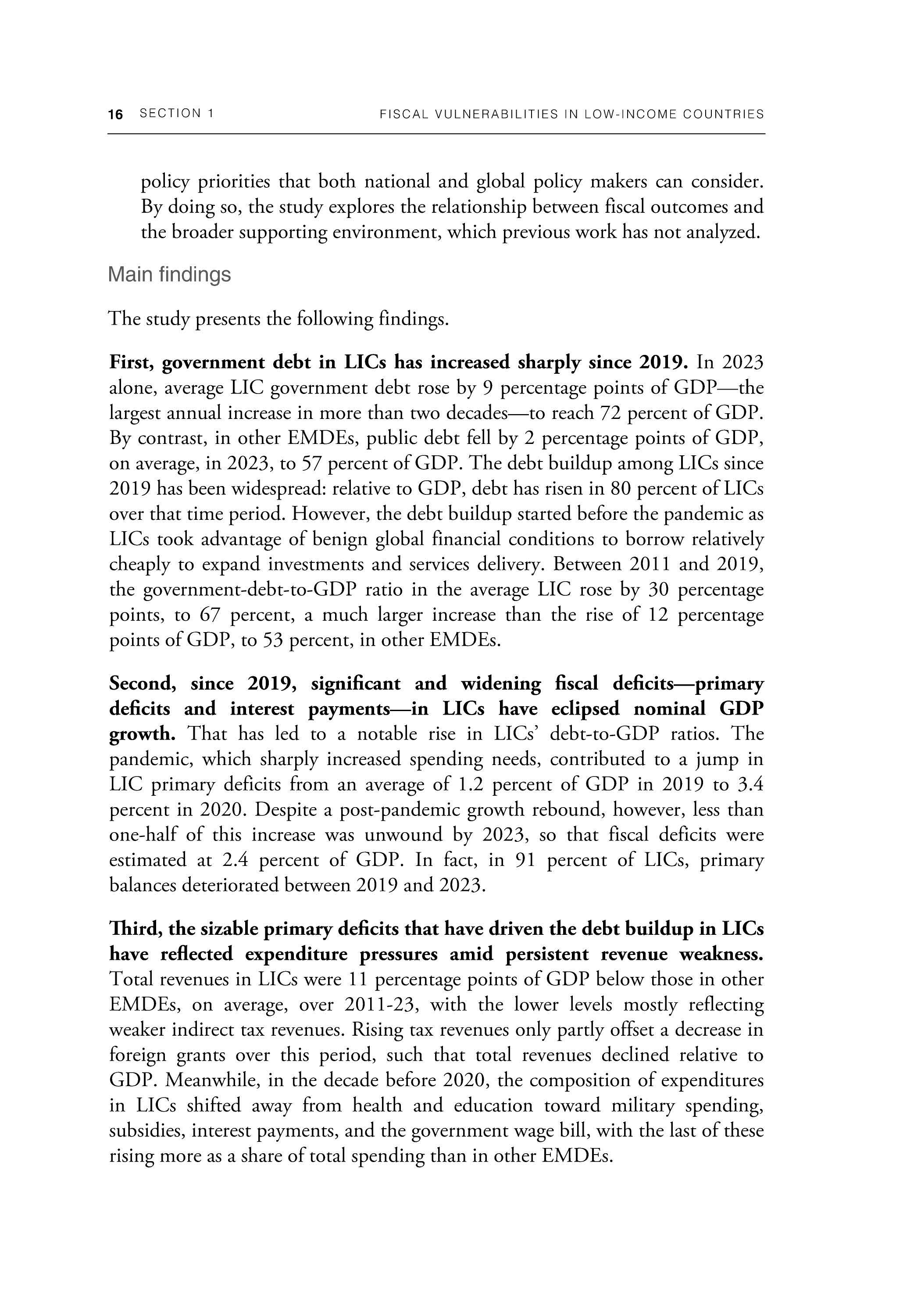
policy priorities that both national and global policy makers can consider. By doing so, the study explores the relationship between fiscal outcomes and the broader supporting environment, which previous work has not analyzed .
Main findings
The study presents the following findings.
First, government debt in LICs has increased sharply since 2019. In 2023 alone, average UC government debt rose by 9 percentage points of GDP-the largest annual increase in more than two decades-to reach 72 percent of GDP . By contrast, in other EMDEs, public debt fell by 2 percentage points of GDP, on average, in 2023, to 57 percent of GDP. The debt buildup among UCs since 2019 has been widespread : relative to GDP, debt has risen in 80 percent ofUCs over that time period. However, the debt buildup started before the pandemic as UCs took advantage of benign global financial conditions to borrow relatively cheaply to expand investments and services delivery. Between 2011 and 2019, the government-debt-to-GDP ratio in the average UC rose by 30 percentage points, to 67 percent, a much larger increase than the rise of 12 percentage points of GDP, to 53 percent, in other EMDEs.
Second, since 2019, significant and widening fiscal deficits-primary deficits and interest payments-in LICs have eclipsed nominal GDP growth. That has led to a notable rise in UCs' debt-to-GDP ratios. The pandemic, which sharply increased spending needs, contributed to a jump in UC primary deficits from an average of 1.2 percent of GDP in 2019 to 3.4 percent in 2020 . Despite a post-pandemic growth rebound, however, less than one-half of this increase was unwound by 2023, so that fiscal deficits were estimated at 2.4 percent of GDP. In fact , in 91 percent of UCs, primary balances deteriorated between 2019 and 2023.
Third, the sizable primary deficits that have driven the debt buildup in LI Cs have reflected expenditure pressures amid persistent revenue weakness. Total revenues in UCs were 11 percentage points of GDP below those in other EMDEs, on average, over 2011-23, with the lower levels mostly reflecting weaker indire ct tax revenu es. Rising tax revenues only partly offset a decrease in foreign grants over this period, such that total revenues declined relative to GDP. Meanwhile, in the decade before 2020, the composition of expenditures in UCs shifted away from health and education toward military spending, subsidies, interest payments, and the government wage bill, with the last of these rising more as a share of total spending than in other EMDEs.
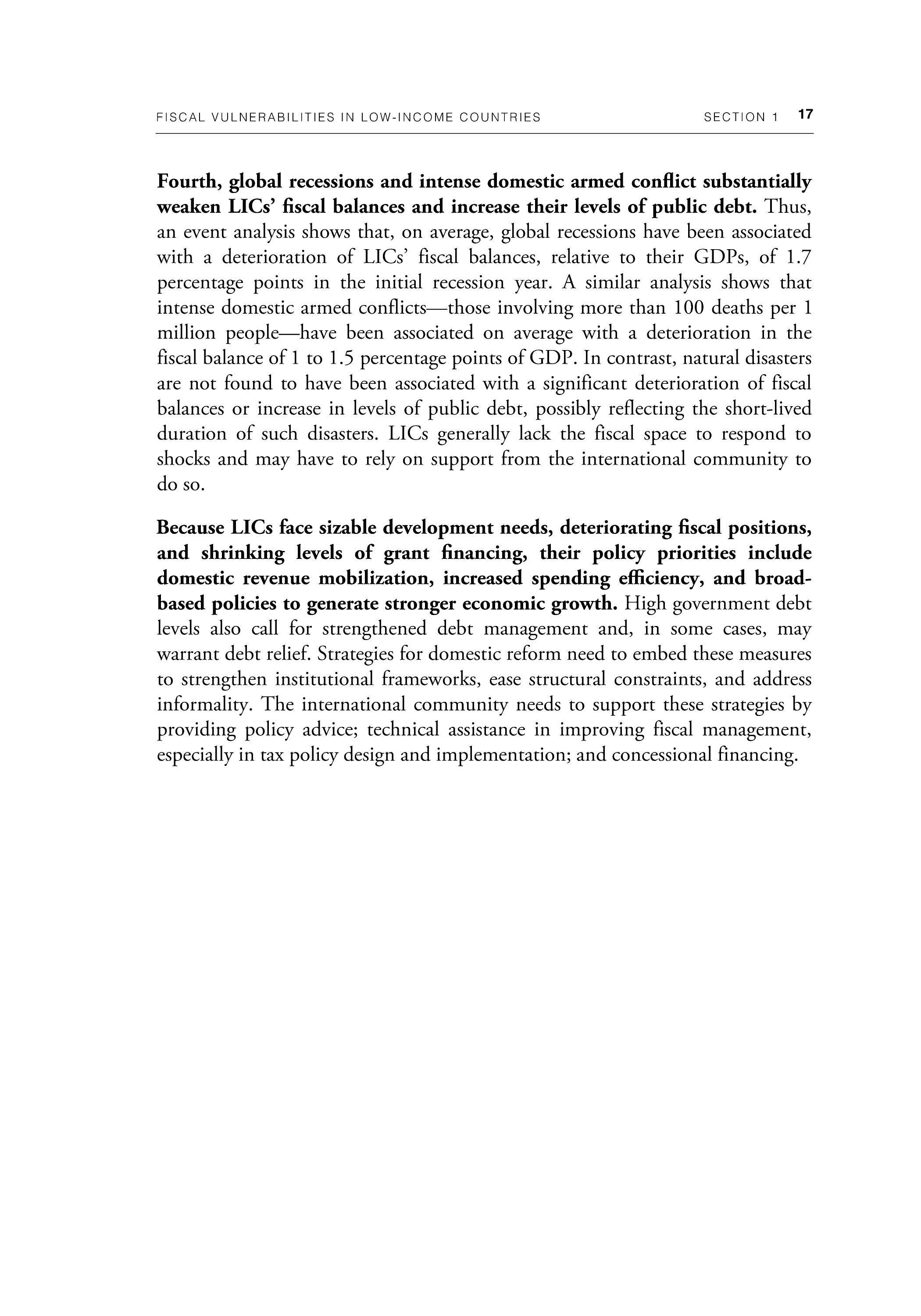
Fourth, global recessions and intense domestic armed conflict substantially weaken LICs' fiscal balances and increase their levels of public debt. Thus, an event analysis shows that , on average, global recessions have been associated with a deterioration of LICs' fiscal balances, relative to their GDPs, of 1.7 percentage points in the initial recession year. A similar analysis shows that intense domestic armed conflicts-those involving more than 100 deaths per 1 million people-have been associated on average with a deterioration in the fiscal balance of 1 to 1.5 percentage points of GDP. In contrast, natural disasters are not found to have been associated with a significant deterioration of fiscal balances or increase in levels of public debt, possibly reflecting the short-lived duration of such disasters. LICs generally lack the fiscal space to respond to shocks and may have to rely on support from the international community to do so.
Because LICs face sizable development needs, deteriorating fiscal positions, and shrinking levels of grant financing, their policy priorities include domestic revenue mobilization, increased spending efficiency, and broadbased policies to generate stronger economic growth. High government debt levels also call for strengthened debt management and, in some cases, may warrant debt relief. Strategies for domestic reform need to embed these measures to strengthen institutional frameworks, ease structural constraints, and address informality. The international community needs to support these strategies by providing policy advice; technical assistance in improving fiscal management, especially in tax policy design and implementation; and concessional financing.
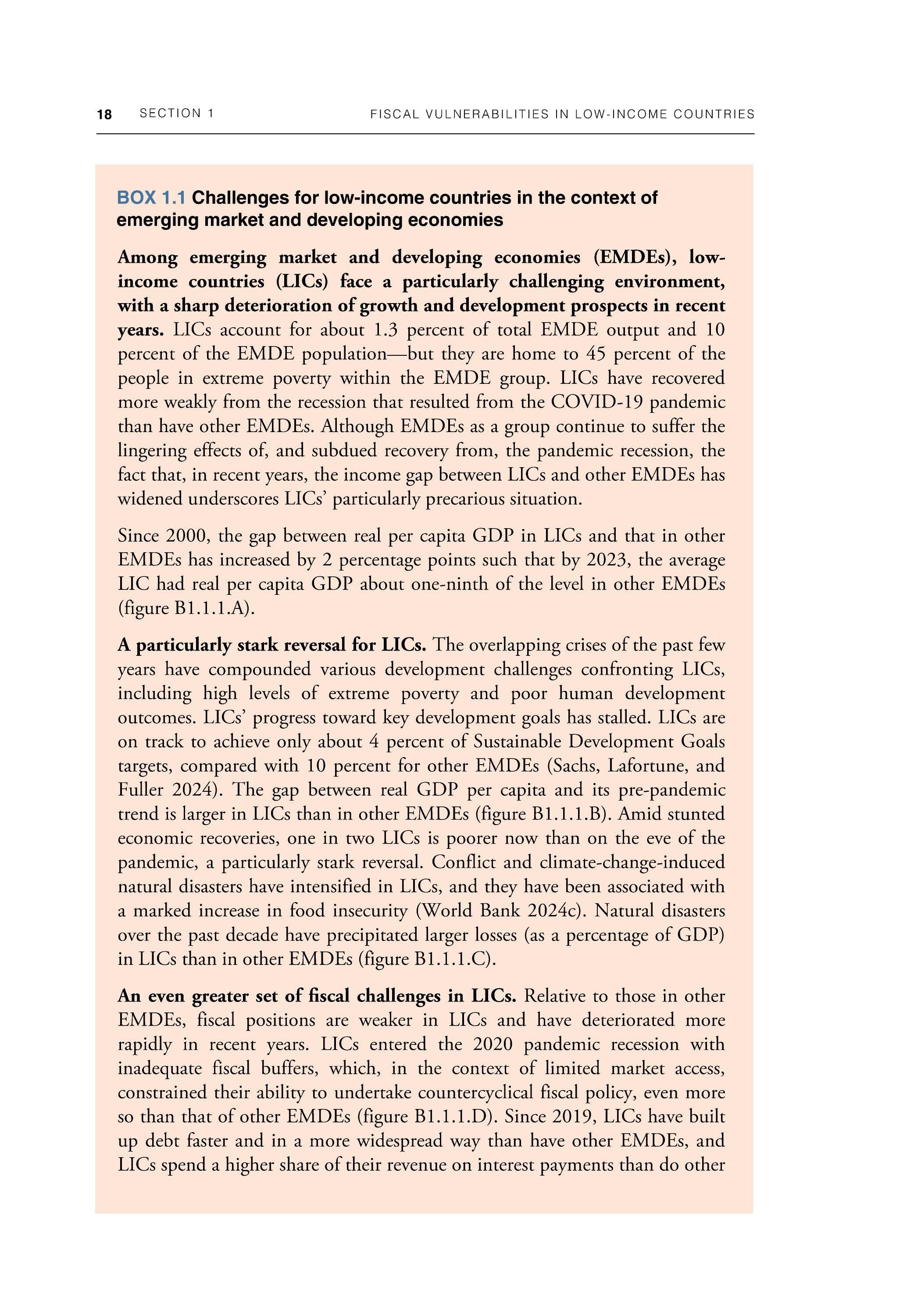
BOX 1 1 Challenges for low-income countries in the context of emerging market and developing economies
Among emerging market and developing economies (EMDEs), lowincome countries (LICs) face a particularly challenging environment, with a sharp deterioration of growth and development prospects in recent years. LICs account for about 1.3 percent of total EMDE output and 10 percent of the EMDE population-but they are home to 45 percent of the people in extreme poverty within the EMDE group LICs have recovered more weakly from the recession that resulted from the COVID-19 pandemic than have other EMDEs. Although EMDEs as a group continue to suffer the lingering effects of, and subdued recovery from, the pandemic recession , the fact that, in recent years, the income gap between LICs and other EMDEs has widened underscores LICs' particularly precarious situation
Since 2000, the gap between real per capita GDP in LICs and that in other EMDEs has increased by 2 percentage points such that by 2023, the average LIC had real per capita GDP about one-ninth of the level in other EMDEs (figure Bl.LI.A).
A particularly stark reversal for LI Cs. The overlapping crises of the past few years have compounded various development challenges confronting LICs, including high levels of extreme poverty and poor human development outcomes. LICs' progress toward key development goals has stalled. LICs are on track to achieve only about 4 percent of Sustainable Development Goals targets, compared with 10 percent for other EMDEs (Sachs, Lafortune, and Fuller 2024). The gap between real GDP per capita and its pre-pandemic trend is larger in LICs than in other EMDEs (figure Bl.LLB). Amid stunted economic recoveries, one in two LICs is poorer now than on the eve of the pandemic, a particularly stark reversal. Conflict and climate-change-induced natural disasters have intensified in LICs, a nd they have been associated with a marked increase in food insecurity (World Bank 2024c) . Natural disasters over the past decad e have precipitated larger losses (as a percentage of GDP) in LICs than in other EMDEs (figure Bl.I.LC).
An even greater set of fiscal challenges in LI Cs. Relative to those in other EMDEs, fiscal positions are weaker in LICs and have deteriorat ed more rapidly in recent years. LICs entered the 2020 pandemic recession with inadequate fiscal buffers, which , in the context of limited market access, constrained their ability to undertake countercyclical fiscal policy, even more so than that of other EMDEs (figure Bl.LLD). Since 2019, LICs have built up debt faster and in a more widespread way than have other EMDEs, and LI Cs spend a higher share of th eir revenue on interest payments than do oth er
BOX 1 .1 Challenges for low-income countries in the context of emerging market and developing economies (continued)
FIGURE B1.1.1 LIC challenges in the context of EMDEs
The income gap between L/Cs and other EMDEs has widened over the past two decades. L/Cs have recovered from the pandemic much more slowly and much less completely. Climate-change-induced natural disasters precipitate larger economic costs (relative to GDP) in L/Cs than in other EMDEs
A Real GDP per capita in LICs relative to other EMDEs
ILICs OtherEMDEs Index,2019=100 Prepandemictrends
GDP per capita relative to 2019 C Cost of natural disasters
COVID-19 fiscal policy support
Sources: EM-DAT (database) ; International Monetary Fund ; WEO (database) ; World Bank
Note: EMDEs = emerging market and developing economies ; GDP= gross domestic product; LICs = low-income countries ; Other EMDEs =emerging market and developing economies excluding LICs
A Bars show avera ge real GDP per capita in LICs relative to that in other EMDEs Based on data for up to 24 LICs and 127 other EMDE s.
B Dashed lines show per capita GDP projec tions in the International Monetary Fund 's October 2019 World Eco nomic Outlook (WEO). Solid lines show per ca pit a GDP estimates in the April 2024 WEO Based on data for 23 LICs and 127 other EMDE s.
C. Bars and diamonds show the weighted average of economic damages from natural disa sters as a percentage of GDP Based on data for up to 17 LICs and 105 other EMDEs
D. Fisc al measures in response to the COVID - 19 pandemic as of September 27 , 2021 Based on data for 7 LICs and 69 other EMDEs
EMDEs. Amid high debt and debt-service costs, LICs have elevated debt vulnerabilities, and the share of LICs in or at high risk of debt distress is greater than that in other EMDEs (figure B1.1.2.A).
Growth opportunities. To confront these challenges, LICs have a range of opportunities to accelerate their growth and development and thus expand their fiscal space, if they pursue appropriate reform efforts and the global communiry provides necessary support. If effectively harnessed, natural resource endowments and demographic dividends could drive economic growth and transformation in LICs.
BOX 1 1 Challenges for low-income countries in the context of emerging market and developing economies (continued)
Natural resources. Several of today's LICs have abundant oil and gas resources and mineral deposits and substantial potential in the areas of solar energy and tourism. LICs have greater fiscal revenues (as a percentage of GDP) than other EMDEs (figure Bl.1.2.B). Natural resource endowments present both opportunities and challenges, however. Commodity revenues, and the associated increase in fiscal space, can be transformative if used efficiently for public investment. However, commodity dependence can precipitate macroeconomic management challenges related to Dutch disease and fiscal policy volatility, potentially undercutting sustained growth and poverty reduction.
Demographic dividends. LICs can reap substantial dividends as the share of their working-age populations grows significantly over the next half century (figure Bl.1.2.C), even more than it does in other EMDEs, and with a later peak. By contrast, the working-age share of the population has been declining in advanced economies for more than a decade . The expected growth in LIC working-age populations could have sizable economic impacts (Ahmed and Cruz 2016). As cohorts of children reach working age, dependency ratios will decline, and labor forces will swell. By illustration, demographic trends, if combined with effective labor market reforms, could add an estimated 1.2 percentage points a year to potential growth between 2022 and 2030 in Sub-Saharan Africa, the region in which the vast majority of LI Cs are concentrated (Kasyanenko et al. 2023)
Support &om the global community. LICs require substantial international support to make meaningful progress toward development and climate goals. Multilateral creditors provided a record $115 billion in new financing for developing countries in 2022, nearly half of which came from the World Bank (20236). Grants provided by the World Bank's International Development Association (IDA) to LICs have grown significantly over the past decade and more than doubled (relative to income), to 1.2 percent of gross national income, between 2015 and 2022. The IDA is the largest source of official development assistance for LICs and contributed nearly half (47 percent) of new disbursements of such assistance from multilateral organizations to LICs in 2022 (OECD 2024). IDA net disbursements to LICs amounted to more than $5 billion in 2022, significantly higher than the amount of disbursements to other EMDEs (figure B 1.1.2.D).a
a Data are from the World Bank's International Debt Statistics database (https ://www.worldbank.org/ en/programs/debt-statistics/ids) , accessed September 5, 2024
BOX 1 .1 Challenges for low-income countries in the context of emerging market and developing economies (continued)
FIGURE B1 .1.2 Fiscal challenges and growth opportunities in LICs
L/Cs have weaker fiscal positions than do other EMDEs, and a larger share of L/Cs are in or at high risk of debt distress. L/Cs can take advantage of their natural and demographic resources , however, to support growth. Support from the International Development Association (/DA) is critical for addressing LIC development challenges. A. Risk of debt distress
Resource revenues
Sources: IDS (database) ; International Monetary Fund ; UN World Population Prospects (database) ; UNU WIDER Government Revenue Dataset (database); World Bank.
Note : AEs = advanced economies ; EMDEs = emerging market and developing economies ; GDP= gross domestic product ; LICs = low-income countries ; Other EMDEs = emerging market and developing economies excluding LICs.
A. Percent of EMDEs in or at high risk of debt distress. Based on data for 70 EMDEs , of which 24 are LICs.
B. Bars show the 2020-22 GDP-weighted average fiscal revenue (as a percentage of GDP) from natural resources. Based on data for up to 12 LICs and 92 other EMDEs.
C. Population-weighted averages. Working-age population is defined as people ages 15-64 Population projections come from the UN World Population Prospects database. Based on data for 36 AEs , 25 LICs , and 117 other EMDEs.
D. " IDA grants" are net disbursements of grants from IDA in billions of U.S dollars Basec on data for 24 LICs and 46 other EMDEs
With its successful track record of delivery, affordable financing options, and deep knowledge of development, the IDA is a vital partner for LICs. It supports these countries in a wide range of areas, including private sector development, human capital development, and infrastructure and climate change adaptation. 6 The IDA, working through the International Finance
b. For detailed information on che IDA's work in developing economies, see IDA (2023). For examples ofIDA-funded projects in LICs , see IDA, " Road to IDA21 " (hccps://ida.worldbank.org/en/replenishmencs/ road-co-ID A2 l).
C. Working-age population
D. IDA grants
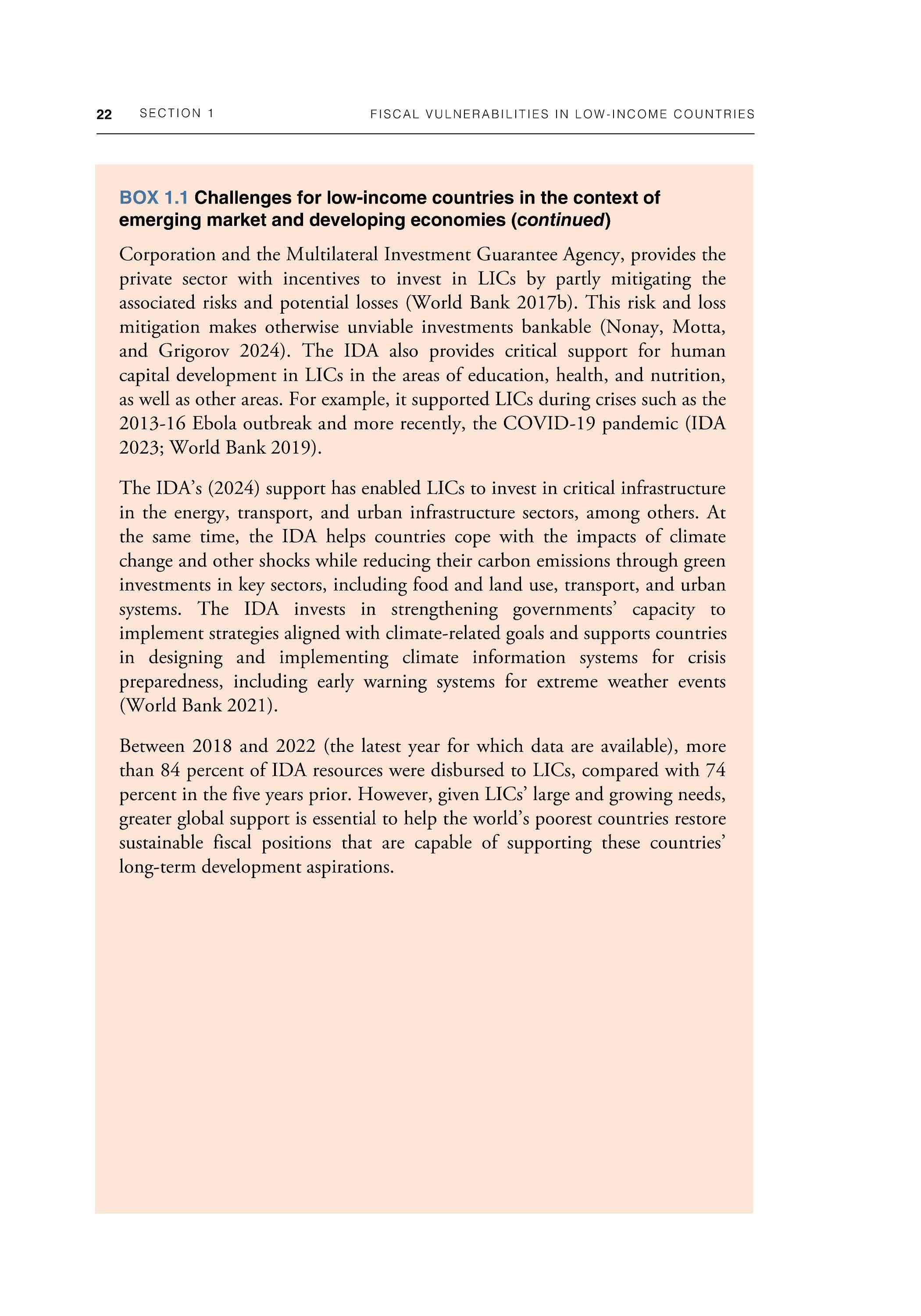
BOX 1 1 Challenges for low-income countries in the context of emerging market and developing economies (continued)
Corporation and the Multilateral Investment Guarantee Agency, provides the private sector with incentives to invest in LICs by partly mitigating the associated risks and potential losses (World Bank 20176) This risk and loss mitigation makes otherwise unviable investments bankable (Nonay, Motta, and Grigorov 2024). The IDA also provides critical support for human capital development in LICs in the areas of education, health, and nutrition, as well as other areas. For example, it supported LICs during crises such as the 2013-16 Ebola outbreak and more recently, the COVID-19 pandemic (IDA 2023; World Bank 2019)
The IDA's (2024) support has enabled LICs to invest in critical infrastructure in the energy, transport, and urban infrastructure sectors, among others. At the same time, the IDA helps countries cope with the impacts of climate change and other shocks while reducing their carbon emissions through green investments in key sectors, including food and land use, transport, and urban systems. The IDA invests in strengthening governments' capacity to implement strategies aligned with climate-related goals and supports countries in designing and implementing climate information systems for crisis preparedness, including early warning systems for extreme weather events (World Bank 2021).
Between 2018 and 2022 (the latest year for which data are available), more than 84 percent ofIDA resources were disbursed to LICs, compared with 74 percent in the five years prior. However , given LICs' large and growing needs, greater global support is essential to help the world's poorest countries restore sustainable fisc a l positions that are capable of supporting these countries' long-term development aspirations
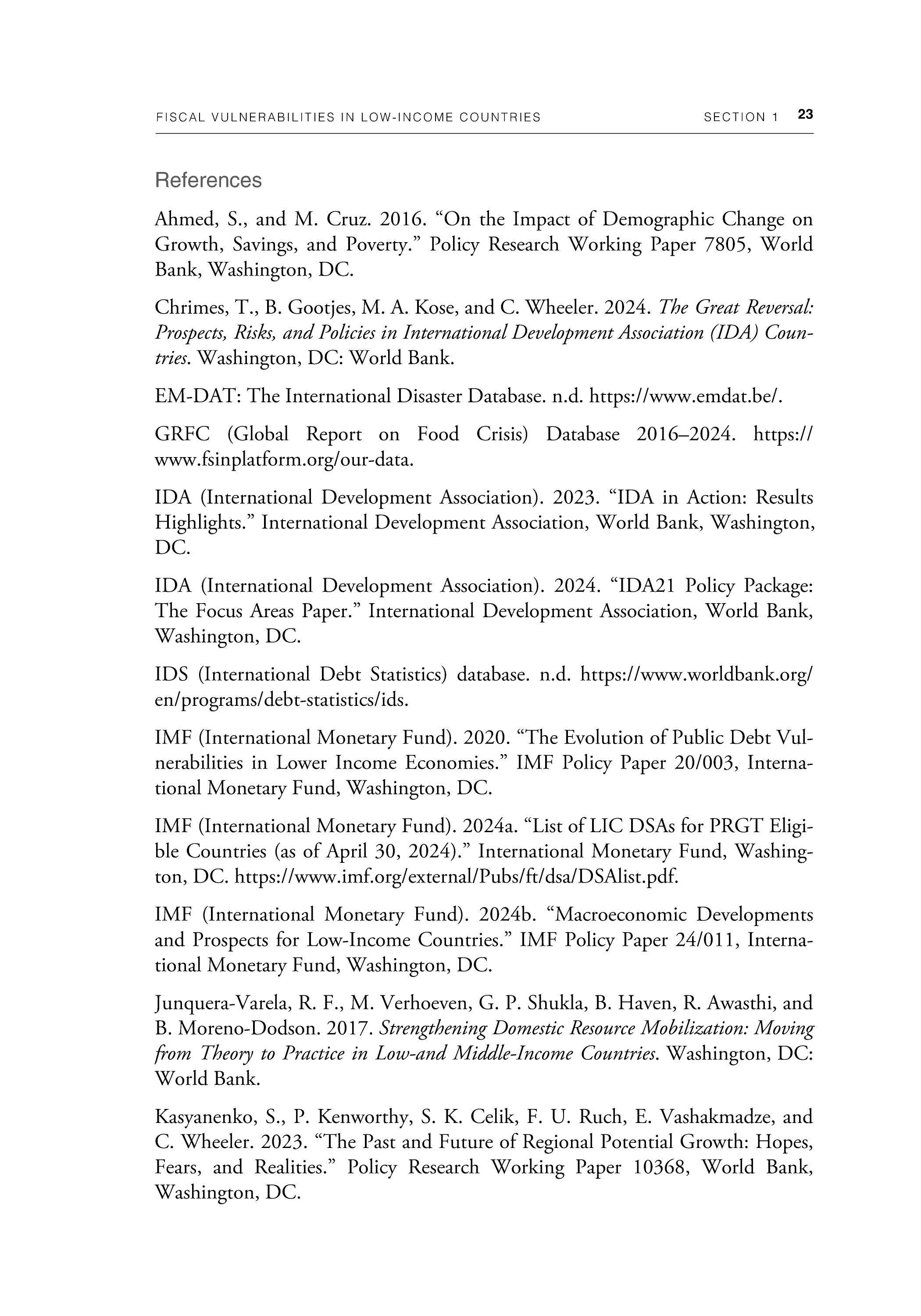
References
Ahmed, S., and M. Cruz. 2016. "On the Impact of Demographic Change on Growth, Savings, and Poverty. " Policy Research Working Paper 7805, World Bank, Washington, DC.
Chrimes, T., B. Gootjes, M. A. Kose, and C. Wheeler. 2024. The Great Reversal: Prospects, Risks, and Policies in International Development Association (IDA) Countries. Washington, DC: World Bank.
EM-DAT: The International Disaster Database. n.d. https://www.emdat.be/.
GRFC (Global Report on Food Crisis) Database 2016-2024. https:// www .fsinplatform .org/ our-data.
IDA (International Development Association). 2023. "IDA in Action: Results Highlights." International Development Association, World Bank, Washington, DC.
IDA (International Development Association) 2024. "IDA21 Policy Package: The Focus Areas Paper." International Development Association, World Bank, Washington, DC.
IDS (International Debt Statistics) database. n .d . https:/ / www .worldbank.org/ en / programs/ debt-statistics/ids.
IMF (International Monetary Fund). 2020. "The Evolution of Public Debt Vulnerabilities in Lower Income Economies." IMF Policy Paper 20/003, International Monetary Fund, Washington, DC.
IMF (International Monetary Fund). 2024a. "List of LIC DSAs for PRGT Eligible Countries (as of April 30, 2024)." International Monetary Fund, Washington, DC. https:/ /www.imf.org/ external/Pubs/ft/ dsa/DSAlist .pdf.
IMF (International Monetary Fund) 2024b. "Macroeconomic Developments and Prospects for Low-Income Countries." IMF Policy Paper 24/011, International Monetary Fund, Washington, DC.
Junquera-Varela, R. F., M. Verhoeven, G. P. Shukla, B. Haven, R. Awasthi, and B. Moreno-Dodson. 2017 . Strengthening Domestic Resource Mobilization: Moving from Theory to Practice in Low-and Middle-Income Countries. Washington, DC: World Bank.
Kasyanenko, S., P. Kenworthy, S. K. Celik, F. U. Ruch, E. Vashakmadze, and C. Wheeler . 2023. 'The Past and Future of Regional Potential Growth : Hopes, Fears, and Realities." Policy Research Working Paper 10368, World Bank, Washington, DC.
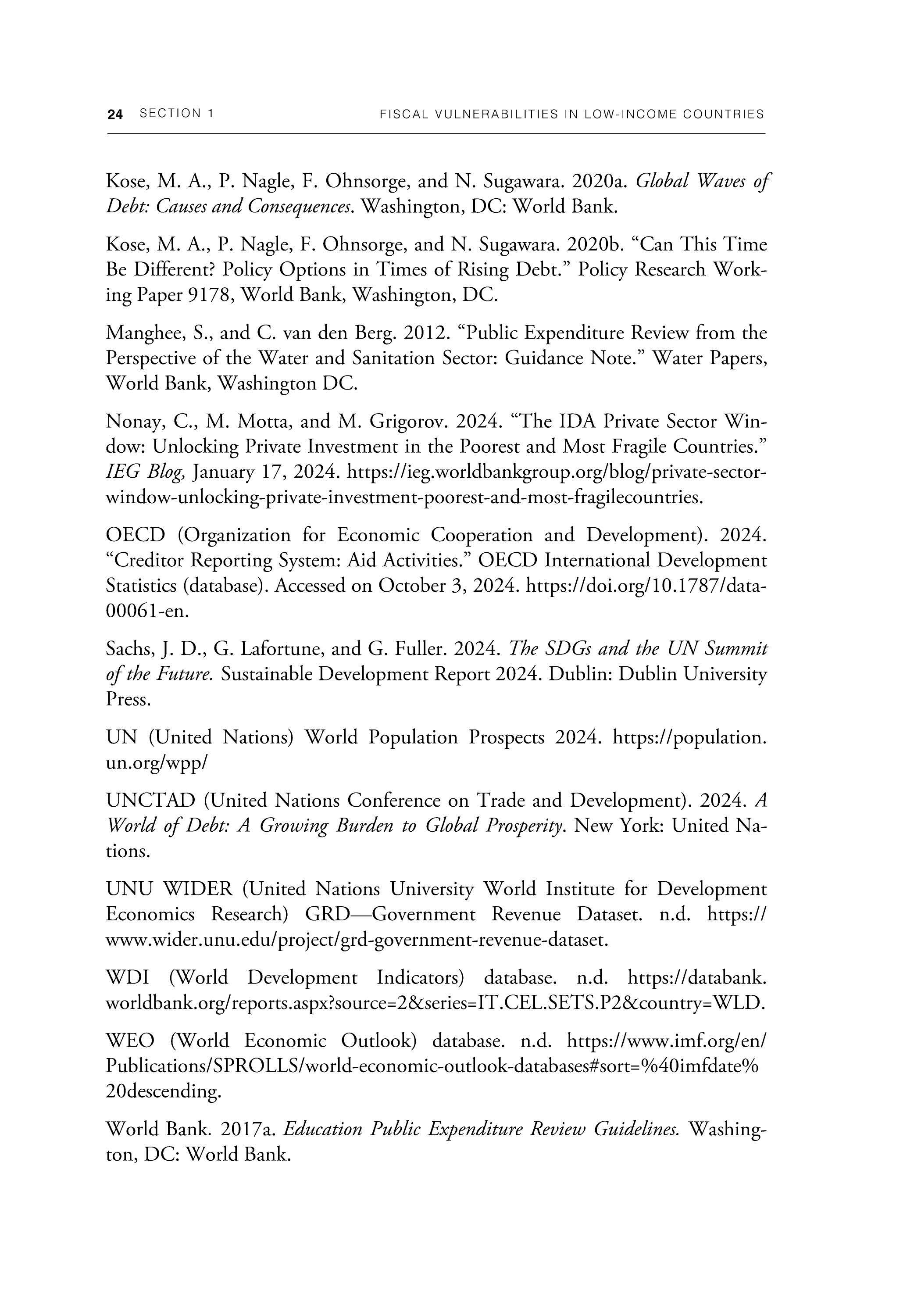
Kose, M.A., P. Nagle, F . Ohnsorge, and N. Sugawara . 2020a. Global Waves of Debt: Causes and Consequences. Washington, DC: World Bank.
Kose, M . A., P. Nagle, F. Ohnsorge, and N. Sugawara. 2020b. " Can This Time Be Different? Policy Options in Times of Rising Debt " Policy Research Working Paper 9178, World Bank, Washington, DC.
Manghee, S., and C. van den Berg. 2012. "Public Expenditure Review from the Perspective of the Water and Sanitation Sector: Guidance Note. " Water Papers, World Bank, Washington DC.
Nonay, C., M. Motta, and M Grigorov. 2024. "The IDA Private Sector Window: Unlocking Private Investment in the Poorest and Most Fragile Countries."
IEG Blog, January 17, 2024 . https :/ /ieg.worldbankgroup.org/blog/private-sectorwindow-unlocking-private-investment-poorest-and-most-fragilecountries.
OECD (Organization for Economic Cooperation and Development). 2024. "Creditor Reporting System : Aid Activities." OECD International Development Statistics (database) Accessed on October 3, 2024. https :/ /doi.org/ 10.1787 /data00061-en.
Sachs, J. D., G. Lafortune, and G. Fuller. 2024. The SDGs and the UN Summit of the Future. Sustainable Development Report 2024. Dublin: Dublin University Press.
UN (United Nations) World Population Prospects 2024. https:/ /population. un.org/wpp/
UNCTAD (United Nations Conference on Trade and Development). 2024 . A World of Debt: A Growing Burden to Global Prosperity . New York : United Nations.
UNU WIDER (United Nations University World Institute for Development Economics Research) GRD-Government Revenue Dataset. n.d. https :/ / www.wider.unu.edu/ project/ grd-government-revenue-dataset.
WDI (World Development Indicators) database. n.d. https ://databank. worldbank.org/ reports.aspx?source=2&series=IT. CEL.SETS. P2&country= WLD.
WEO (World Economic Outlook) database. n.d. https://www.imf.org/en/ Publications/SPROLLS/world-economic-oudook-databases#sort=%40imfdate% 20descending.
World Bank. 2017 a Education Public Expenditure Review Guidelines. Washington, DC: World Bank.
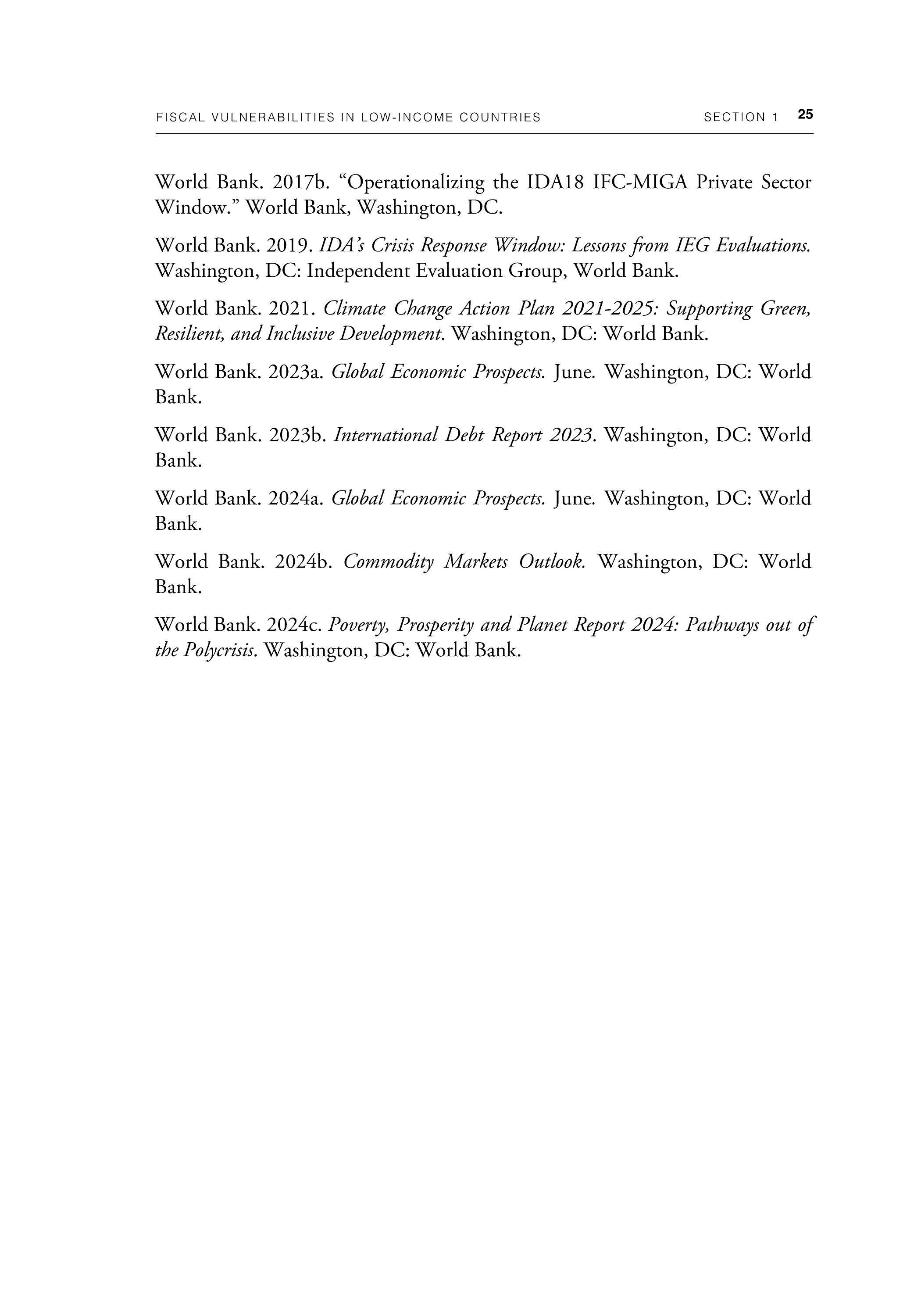
World Bank. 20176 . "Operationalizing the IDAl 8 IFC-MIGA Private Sector Window." World Bank, Washington, DC.
World Bank . 2019. IDA s C risis Response Window: Lessons from IEG Evaluations . Washington, DC: Independent Evaluation Group, World Bank.
World Bank. 2021. Climate Change Action Plan 2021-2025: Supporting Green, Resilient, and Inclusive Development. Washington, DC: World Bank.
World Bank. 2023a. Global Economic Prospects. June. Washington, DC: World Bank.
World Bank. 20236 . International Debt Report 2023. Washington, DC: World Bank.
World Bank. 2024a Global Economic Prospects. June. Washington, DC: World Bank.
World Bank. 20246 Commodity Ma rkets Outlook Washington, DC: World Bank
World Bank. 2024c. Poverty, Prosperity and Planet Report 2024: Pathways out of the Polycrisis Washington, DC : World Bank.

2. Evolution of Fiscal Positions in Low-Income Countries
Even before the onset of the COVID-19 pandemic and ensuing global recession of 2020, average ratios of debt to gross domestic product (GDP) in low-income countries (LICs) had risen sharply during 2011-19, with persistent fiscal deficits outweighing the effects of nominal GDP growth. Before, during, and since the pandemic, the larger fiscal deficits in LICs relative to those in other emerging market and developing economies (EMDEs) have mainly reflected weakness in revenues, especially income tax revenues. Spending pressures before and during the pandemic, as well as the effects of subsequent shocks on spending, have further widened LICs' fiscal deficits. Domestic armed conflicts and fragility have added to these fiscal challenges by, among other things, tilting revenue collection from income taxes to trade taxes and increasing military spending .
Conceptual framework
An accounting decomposition offers a framework for identifying the sources of changes in a country's debt burden, or the ratio of its government debt to its GDP (World Bank 2024). With some complications to be considered later in the chapter set aside for simplicity, the change in a country's debt-to-GDP ratio between one period and the next depends on its primary fiscal balance (the difference between its revenues and noninterest expenditures), the interest rate on and initial level of its government debt, and the growth rate of its nominal GDP, which is the sum of the growth rate of its real GDP and that of its rate of inflation. One complication is the fact that a country may owe some government debt to foreign creditors that is denominated in foreign rather than domestic currency, so that the average interest rate on its government debt depends on foreign as well as domestic interest rates, and changes in the value of its debt in terms of the domestic currency will depend partly on exchange rate movements. Other complications include privatization proceeds, the materialization of contingent liabilities, and other ad hoc changes to debt stocks such as the emergence of hidden debt (appendix 1) .
The decomposition performed here is applied to the whole period 2011-23, to the sub period 2011-19 to capture changes in the decade leading up to the
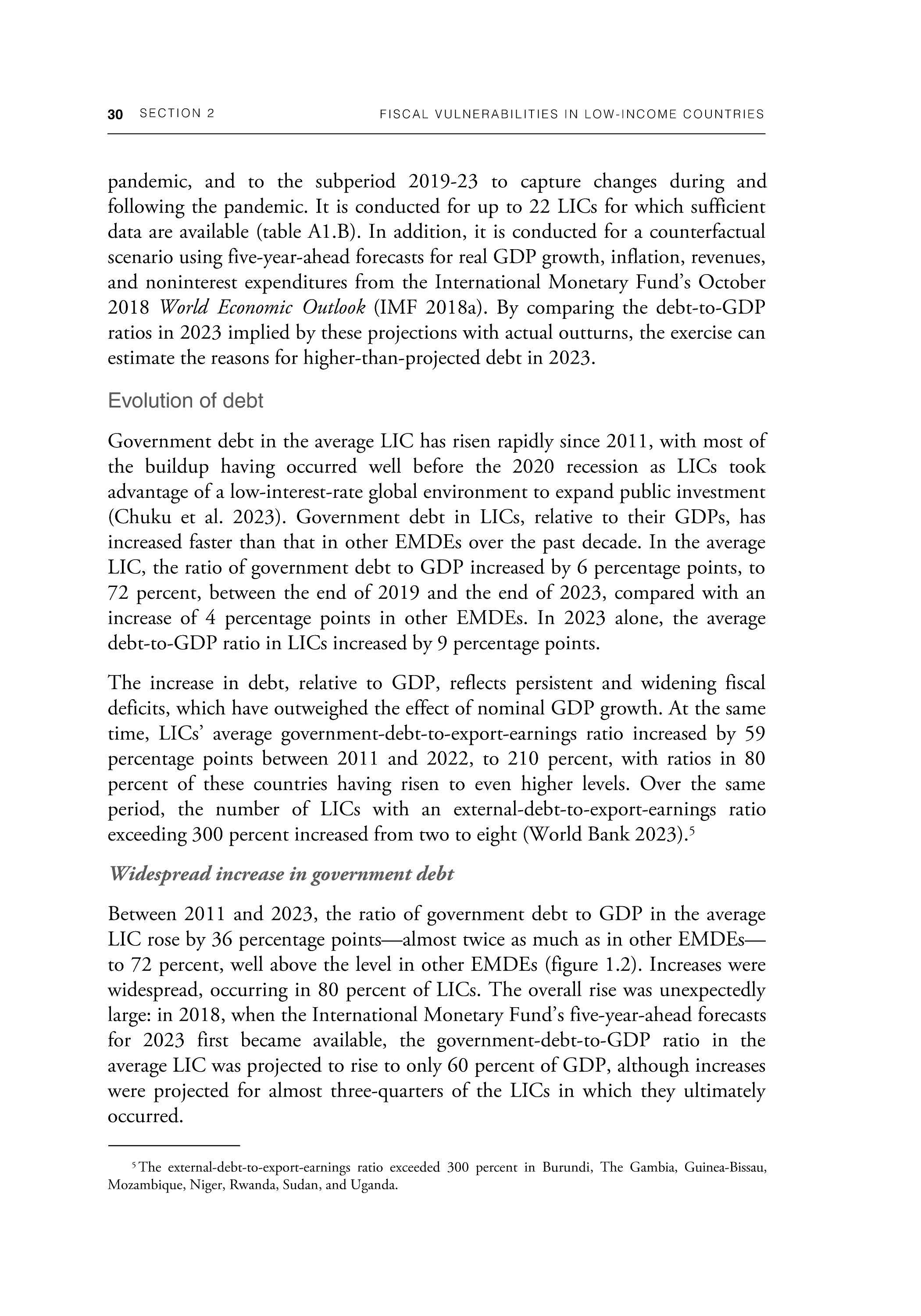
pandemic, and to the subperiod 2019-23 to capture changes during and following the pandemic. It is conducted for up to 22 LICs for which sufficient data are available (table ALB). In addition, it is conducted for a counterfactual scenario using five-year-ahead forecasts for real GDP growth, inflation, revenues, and noninterest expenditures from the International Monetary Fund's October 2018 World Economic Outlook (IMF 2018a). By comparing the debt-to-GDP ratios in 2023 implied by these projections with actual outturns, the exercise can estimate the reasons for higher-than-projected debt in 2023.
Evolution of debt
Government debt in the average LIC has risen rapidly since 2011, with most of the buildup having occurred well before the 2020 recession as LICs took advantage of a low-interest-rate global environment to expand public investment (Chuku et al. 2023). Government debt in LICs, relative to their GDPs, has increased faster than that in other EMDEs over the past decade. In the average LIC, the ratio of government debt to GDP increased by 6 percentage points, to 72 percent, between the end of 2019 and the end of 2023, compared with an increase of 4 percentage points in other EMDEs. In 2023 alone, the average debt-to-GDP ratio in LICs increased by 9 percentage points.
The increase in debt, relative to GDP, reflects persistent and widening fiscal deficits, which have outweighed the effect of nominal GDP growth. At the same time, LICs' average government-debt-to-export-earnings ratio increased by 59 percentage points between 2011 and 2022, to 210 percent, with ratios in 80 percent of these countries having risen to even higher levels. Over the same period, the number of LICs with an external-debt-to-export-earnings ratio exceeding 300 percent increased from two to eight (World Bank 2023). 5
Widespread increase in government debt
Between 2011 and 2023, the ratio of government debt to GDP in the average LIC rose by 36 percentage points-almost twice as much as in other EMDEsto 72 percent, well above the level in other EMDEs (figure 1.2). Increases were widespread, occurring in 80 percent of LI Cs. The overall rise was unexpectedly large: in 2018, when the International Monetary Fund's five-year-ahead forecasts for 2023 first became available, the government-debt-to-GDP ratio in the average LIC was projected to rise to only 60 percent of GDP, although increases were projected for almost three-quarters of the LICs in which they ultimately occurred
5 The excernal-debc-co-exporr-earnings ratio exceeded 300 percent in Burundi , The Gambia, Guinea-Bissau, Mo za mbique , Niger , Rwanda , Sudan , and Uganda
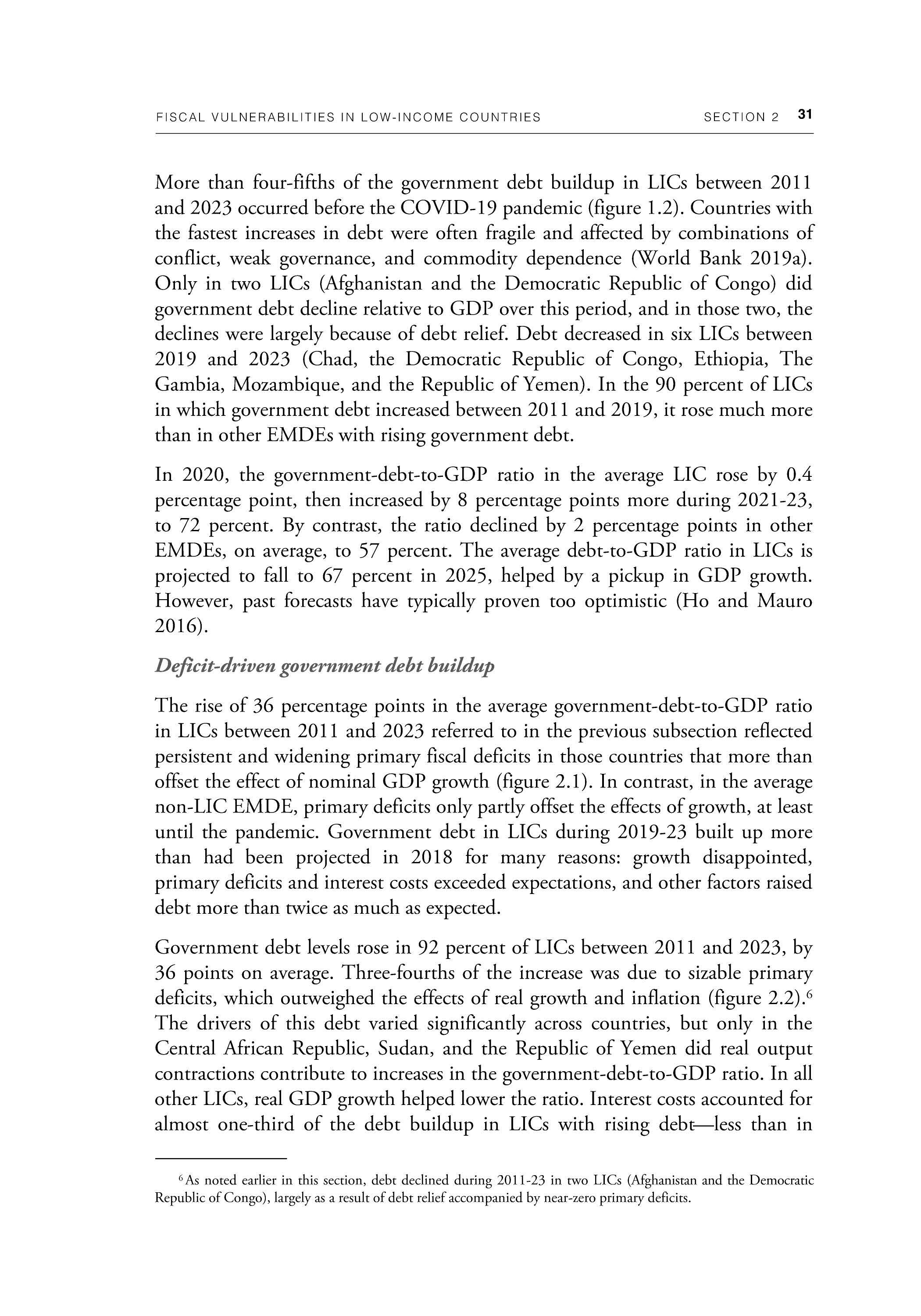
More than four-fifths of the government debt buildup in LICs between 2011 and 2023 occurred before the COVID-19 pandemic (figure 1.2). Countries with the fastest increases in debt were often fragile and affected by combinations of conflict, weak governance, and commodity dependence (World Bank 2019a). Only in two LICs (Afghanistan and the Democratic Republic of Congo) did government debt decline relative to GDP over this period, and in those two, the declines were largely because of debt relief. Debt decreased in six LICs between 2019 and 2023 (Chad , the Democratic Republic of Congo , Ethiopia, The Gambia, Mozambique, and the Republic of Yemen). In the 90 percent of LI Cs in which government debt increased between 2011 and 2019, it rose much more than in other EMDEs with rising government debt.
In 2020, the government-debt-to-GDP ratio in the average LIC rose by 0.4 percentage point, then increased by 8 percentage points more during 2021-23, to 72 percent . By contrast, the ratio declined by 2 percentage points in other EMDEs, on average, to 57 perce nt. The ave rage debt-to-GDP ratio in LICs is projected to fall to 67 percent in 2025, helped by a pickup in GDP growth . However, past forecasts have typically proven too optimistic (Ho and Mauro 2016) .
Deficit-driven government debt buildup
The rise of 36 percentage points in the average government-debt-to-GDP ratio in LICs between 2011 and 2023 referred to in the previous subsection reflected persistent and widening primary fiscal deficits in those countries that more than offset the effect of nominal GDP growth (figure 2.1). In contrast, in the average non-LIC EMDE, primary deficits only partly offset the effects of growth, at least until the pandemic. Government debt in LICs during 2019-23 built up more than had been projected in 2018 for many reasons: growth disappointed, primary deficits and interest costs exceeded expectations, and other factors raised debt more than twice as much as expected .
Government debt levels rose in 92 percent of LICs between 2011 and 2023, by 36 points on average. Three-fourths of the increase was due to sizable primary deficits, which outweighed the effects of real growth and inflation (figure 2.2). 6 The drivers of this debt varied significantly across countries, but only in the Central African Republic, Sudan, and the Republic of Yemen did real output contractions contribute to increases in the government-debt-to-GDP ratio. In all other LICs, real GDP growth helped lower the ratio. Interest costs accounted for almost one-third of the debt buildup in LICs with rising debt-less than in
6 As noted ea rli er in thi s sect ion , d eb t d eclin ed durin g 2011-23 in two LI Cs (Afghanistan and the D emocratic Rep ublic of Congo), largely as a res ult of d ebt reli ef accompanied by near-zero primary d eficits
FIGURE 2.1 Decomposition of changes in government debt
The rise in L/Cs ' government-debt-to-GDP ratios between 2011 and 2023 resulted from fiscal deficits that outweighed the effects of nominal GDP growth, even before the pandemic The debt buildup over 2011-23 was larger than that projected in 2018, mainly because of disappointing growth outcomes and higher-than-expected interest costs; primary deficits were broadly as expected.
A. Contributions to average increase in LICs ' government debt, 2011-19
B Contributions to average increase in LICs' government debt, 2019-23
C Contributions to average increase in LICs ' government debt , 2011-23 -
D 2018 projections of contributions to average increase in government debt, 2011-23
Source s : International Monetary Fund (IMF); World Bank
Note : Debt in 2011 (2019 in panel B) is in percent of GDP Red bars indicate debt-increasing contribution and orange bars indicate debt-decreasing co ntribution Note th at the group of LICs with rising government debt differs by sample periods (that is, 2011-19 in panel A ; 2019-23 in panel B; and 2011-23 in panels C-D) "Other'' factors inc lude exchange rate depreciation , privatization proceeds, the materialization of contingent liabilities , or other ad hoc changes to debt stocks GDP = gross domestic product ; LICs = low- income countries.
D The decomposition is based on the forec asts for 2023 from IMF (2018a).
other EMDEs, reflecting the fact that almost one-third of LIC external debt was on concessional terms.
In some countries, other factors played a sizable role: the recognmon or realization of contingent liabilities net of privatization proceeds, debt restructuring , and measurement error (figure 2.2; World Bank 2024) In Mozambique and Sudan , where state-owned enterprises created large contingent (or explicit) government liabilities , other factors accounted for 4 and 18 percentage points, respectively, of the average a nnual change in the governmentdebt-to-GDP ratio (IMF 20186). In The Gambia, government bailouts of stateowned enterprises and widespread mismanagement of debt accounted for more than 1 percentage point of GDP per year (World Bank 2018a).
FIGURE 2.2 Contributions to changes in government debt
In L/Cs with rising debt-to-GDP ratios during 2011-23 , primary deficits outweighed the benefits of nominal GDP growth , whereas in L/Cs with falling debt-to-GDP ratios , the reverse was true However, there was wide variation across countries.
A Contributions to average increase in government debt in LICs with rising debt , 2011-23
B Contributions to average decline in government debt in LICs with falling debt, 2011 -23
C Range of contributions to changes in government debt in LICs with rising debt , 2011-23
D Range of contributions to changes in government debt in LICs with falling debt, 2011-23
Source s: International Monetary Fund ; World Bank
Note: LIC s = low-income countrie s "Othe r' factor s include exc hange rate depreci ation , pri vatizati on proceed s, the materializ ation of contingent li abilities, or other ad hoc ch ange s to debt st ocks The sample cover s LIC s w ith ri sing (A , C) or falling (B, D) government debt-to-GDP ratios between 2011 and 2022 GDP = gross domestic produ ct.
A.B Red bars indicate de bt -increasing contribution and orang e bars indicate debt- re ducing contribution
C D. Blue bars indicat e median c ontribution s to the av erage change s in government-de bt-to-GDP ratios during 2011-2 3, and orange whi skers indi cate interqu a rtile ra nges.
Riskier sources ofgovernment financing
In addition to the buildup of government debt , the composition of that debt in LI Cs has shifted toward riskier sources of financing. At the end of 2022, external government debt in the average LIC was equivalent to 55 percent of GDP, nearly three-quarters of tot al government debt. Almost all of chis external debt was denominated in foreign currencies . Also, between 2011 and 2022, the concessional share of government debt in the average LIC declined by 8 percentage points, to 52 percent (figure 1.2).
In th e decade b efor e the pandemic, non-Pari s Club official creditors, notably China, became a more important source of financing for LI Cs , especially those in Sub-Saharan Africa (Essl et al. 2019). In 2022, the most recent year for which
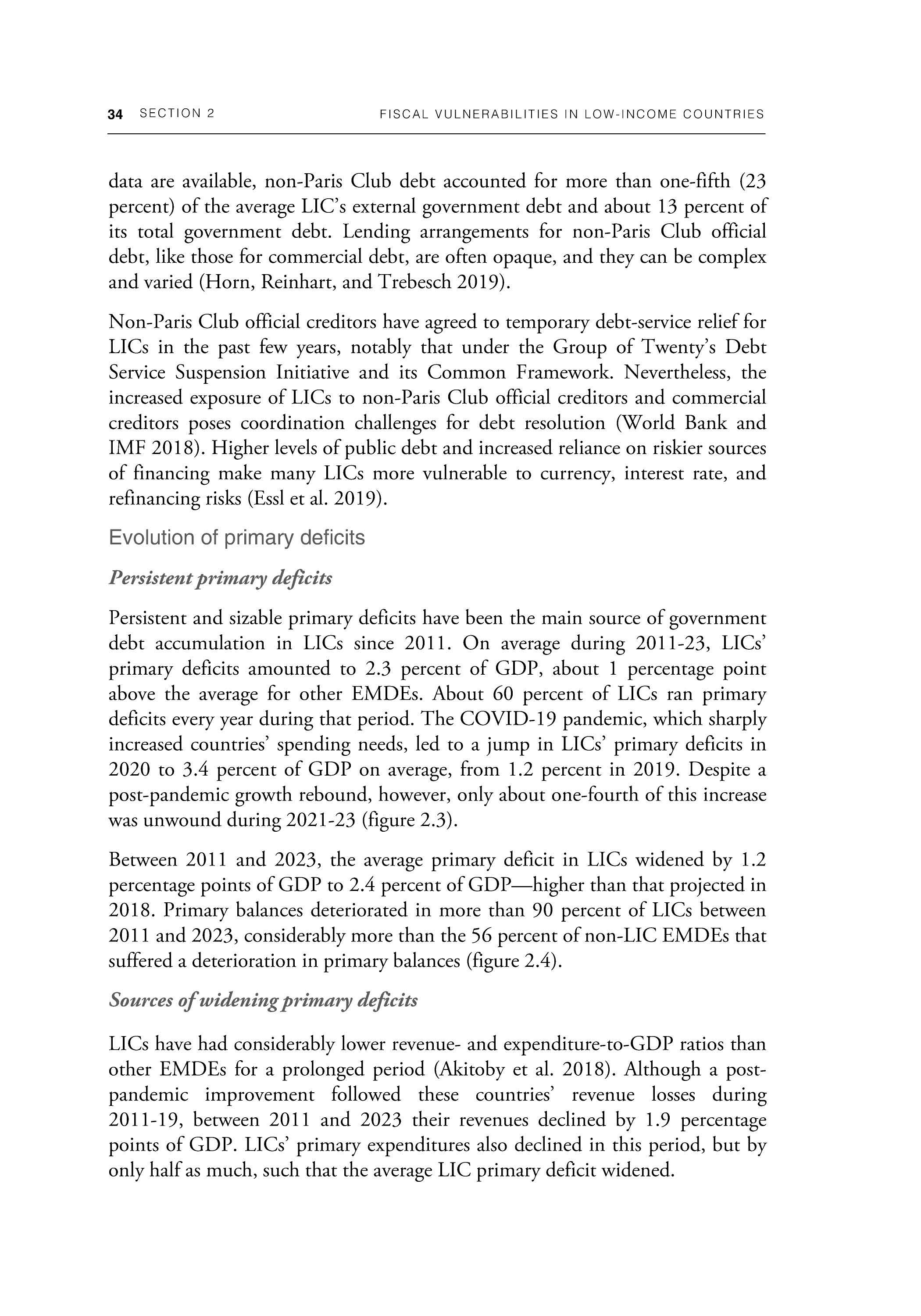
data are available, non-Paris Club debt accounted for more than one-fifth (23 percent) of the average LIC's external government debt and about 13 percent of its total government debt. Lending arrangements for non-Paris Club official debt, like those for commercial debt, are often opaque, and they can be complex and varied (Horn, Reinhart, and Trebesch 2019).
Non-Paris Club official creditors have agreed to temporary debt-service relief for LICs in the past few years, notably that under the Group of Twenty's Debt Service Suspension Initiative and its Common Framework. Nevertheless, the increased exposure of LICs to non-Paris Club official creditors and commercial creditors poses coordination challenges for debt resolution (World Bank and IMF 2018). Higher levels of public debt and increased reliance on riskier sources of financing make many LICs more vulnerable to currency, interest rate, and refinancing risks (Essl et al. 2019).
Evolution of primary deficits
Persistent primary deficits
Persistent and sizable primary deficits have been the main source of government debt accumulation in LICs since 2011. On average during 2011-23, LICs ' primary deficits amounted to 2.3 percent of GDP, about 1 percentage point above the average for other EMDEs. About 60 percent of LICs ran primary deficits every year during that period. The COVID-19 pandemic, which sharply increased countries' spending needs, led to a jump in LICs' primary deficits in 2020 to 3.4 percent of GDP on average, from 1.2 percent in 2019. Despite a post- pandemic growth rebound, however, only about one-fourth of this increase was unwound during 2021-23 (figure 2 .3) .
Between 2011 and 2023, the average primary deficit in LICs widened by 1.2 percentage points of GDP to 2.4 percent of GDP-higher than that projected in 2018. Primary balances deteriorated in more than 90 percent of LICs between 2011 and 2023, considerably more than the 56 percent of non-UC EMDEs that suffered a deterioration in primary balances (figure 2.4) .
Sources ofwidening primary deficits
LICs have had considerably lower revenue- and expenditure-to-GDP ratios than other EMDEs for a prolonged period (Akitoby et al. 2018). Although a postpandemic improvement followed these countries' revenue losses during 2011-19, between 2011 and 2023 their revenues declined by 1.9 percentage points of GDP. LI Cs' primary expenditures also declined in this period, but by only half as much, such that the average LIC primary deficit widened.
FIGURE 2.3 Primary fiscal balances
Primary fiscal deficits , relative to GDP, have been consistently wider, on average, in L/Cs than in other EMDEs In the average LIC, the deterioration in primary balances in 2020-22, owing mainly to the pandemic, resulted from both increased primary expenditures and reduced revenues
A Primary fiscal balance
B LIC government revenues and primary expenditures, 2010-24
PercentofGDP
Primarybalance(RHS) Revenue Expenditure
Sources: International Monetary Fund ; World Bank.
Note : GDP= gro ss domestic product ; LICs = low-income countries ; Other EMDEs = emerging market and de ve loping economies excluding LICs ; RHS = right-hand scale.
A. Bars show un weighted averages, w ith w hi skers s howing interquartile ranges. Data for 2023 are estimated.
B Proj ections (marked f) are s ho wn for 2024-25
Revenues evolved in a widely heterogeneous manner in LICs between 2011 and 2023. None of the LI Cs with improving primary balances suffered revenue losses of the magnitude of those in the one-fourth of LI Cs with deteriorating primary balances over this period . In addition, spending increased much less in LICs with improving primary balances than in the majority of LI Cs with worsening primary balances .
Evolution of revenues
Revenue weakness
LICs' weak revenue collection mainly reflects challenges in collecting tax revenues. It may also, however, partly reflect tax expenditures-such as tax credits and exemptions-in these countries (Mullins, Gupta, and Liu 2020) In the average LIC, tax expenditures reduced revenues by 2.3 percent of GDP in 2022 or the latest year for which data are available (figure 2 . 5). Although LICs have broadly maintained stable average ratios of tax revenues to GDP over the past decade, there has been some variation across countries, with somewhat greater volatility in LI Cs in fragile and conflict-affected situations.
Revenue composition
The average LIC had government revenues equivalent to 18 percent of GDP during 2011-23, 11 percentage points lower than those in non-UC EMDEs
FIGURE 2.4 Decomposition of changes in primary fiscal balances
Increases in government spending outpaced revenue growth in L/Cs between 2011 and 2023, resulting in widening primary deficits-though with significant variation across countries. Primary balances deteriorated in a larger share of L/Cs than of other EMDEs. In L/Cs with improvements in their fiscal balances, revenues increased by more and expenditures rose by less than in L/Cs with deteriorating balances
A Contributions to changes in primary balances, 2011-23
B. Share of economies with deterioration in primary balances, 2011-23
C Range of changes in primary balances, revenues, and expenditures, 2011-23
D. Range of contributions to changes in LICs' primary balances, 2011-23
Sources: International Monetary Fund; World Bank.
Note: EMDEs = emerging market and developing economies; GDP= gross domestic product; LICs = low-income countries ; Other EMDEs = emerging market and developing economies excluding LICs.
A Bars show unweighted average changes between 2011 and 2023 in the primary-fiscal-balance-to-GDP and revenue-to-GDP ratios and the negative of the primary-expenditure-to-GDP ratio
B. Gray line denotes 50 percent.
C. Bars indicate median contributions to change in primary balance (in blue) , revenues (in red) , and primary expenditures (in orange; all in percent of GDP) during 2011-22 , with whiskers indicating the interquartile range
D. "Worsening" ("improving") primary balance refers to the 19 (6) LICs and 69 (59) other EMDEs in which the primary balance in 2023 was below (above) the primary balance in 2011. Bars indicate median contributions to change in revenues (in blue) and primary expenditures (in red ; all in percent of GDP) during 2011-23 , with whiskers indicating the interquartile range.
(figure 2.6). Tax revenues accounted for 6 percentage points of this gap. LICs had weaker tax revenues, both direct and indirect, than other EMDEs, by up to 3 percentage points of GDP, the largest differences being in taxes on goods and services (3 percentage points of GDP), personal income taxes (2 percentage points), and corporate income taxes (I percentage point) . Trade tax revenues, relative to GDP, were broadly similar in LICs and other EMDEs. On average, value added tax rates were higher in LICs than in other EMDEs in 2022, but revenues from value added taxes were 2 percentage points of GDP (and with statistical significance) lower in LICs (figure 2.5).
FIGURE 2.5 VAT rates, tax expenditures, fuel subsidies, and tax effort
On average, VAT rates are higher in L/Cs than in other EMDEs. Tax expenditures absorb sizable amounts of revenue in L/Cs and other EMDEs, averaging more than 2 and 3 percent of GDP, respectively. For example, fuel subsidies cost an estimated 2 percent of GDP in L/Cs in 2022. In addition, tax effort is lower in L/Cs than in other EMDEs: on average, L/Cs have been able to collect less than two-thirds of their potential tax revenue over the past decade. A Value-added tax rates
Tax expenditures
Sources: International Monetary Fund ; Global Tax Expenditures (database); McNabb, Danquah , and Tagem (2021 ); World Bank.
Note: EMDEs = emerging market and developing economies; GDP= gross domestic product; LICs = low-income countries; Other EMDEs =emerging market and developing economies excluding LICs
A. Bars show simple averages. Whiskers show interquartile range. Based on data for 133 EMDEs, of which 21 are LICs.
B. Bars show simple averages. Whiskers show interquartile range. Based on data for 71 EMDEs, of which 12 are LICs.
C. Weighted averages. Fuel subsidy data are from Black et al. (2023). Based on data for a sample of 133 EMDEs , of which 21 are LICs.
D. Tax effort measures the extent to which tax collections reach potential , expressed as a percentage. Tax potential estimates presented here are the latest available data points for each country , based on the pooled estimates reported in McNabb, Danquah, and Tagem (2021). Based on data for 126 EMDEs, of w hich 19 are LICs.
Aid has always played an important role in LICs. During 2011-15, grants amounted to an average of 7 percent of GDP in LICs, nearly three times the average of 2.4 percent of GDP in other EMDEs. They also constituted more than one-third of total LIC government revenues Since then, however, grants to LICs have declined steeply, to 2.5 percent of GDP and less than one-fifth of revenue by 2022 (figure 2.6). The decline may reflect rising financing costs and other funding constraints in donor countries, but it also reflects limited absorptive capacity in LICs, which may have constrained the effectiveness of aid (Feeny and McGillivray 2009). At the same time, increased donor fragmentation has hindered aid coordination (World Bank 2022) . There is a well-established
C Explicit fuel subsidies D Tax effort
Government revenues in L/Cs have consistently lagged behind those in other EMDEs, primarily because of gaps in tax revenues, particularly those from goods and services taxes, as well as income taxes. Commodity-exporting L/Cs have somewhat higher goods and services tax collections than other L/Cs Over the past decade, the composition of tax revenues has shifted somewhat toward goods and services. Additionally, grants have declined steeply among L/Cs.
Sources: International Monetary Fund ; World Bank
Note: EMDEs = emerging market and developing
; FCS = fragile and conflict-affected
product; LICs = low-income countries; Other EMDEs = emerging market and developing
A. Bars show unweighted averages, with whiskers showing interquartile ranges.
B. Lines show unweighted averages.
C. Unweighted averages.
D. Unweighted averages. Based on data for up to 134 EMDEs , of which 20 are LICs.
association between higher grant funding and lower tax revenues, although it has also been found that stronger institutions and a more equal income distribution may mitigate the association (Thornton 2014).
Since 2011, the composition of tax revenues in LI Cs has been broadly stable, at least for the nine LICs for which a revenue breakdown is available. In these LI Cs, both indirect and direct tax revenues rose by almost 2 percentage points of GDP between 2011 and 2019, before declining by 2 percentage points between 2019 and 2020 (figure 2 7). The increase in indirect tax revenues between 2011 and 2019, to just over 8 percent of GDP, was largely on account of an increase
FIGURE 2.7 Decomposition of government revenues, 2011-22
During 2011-22, overall revenues in L/Cs were below those in other EMDEs, mainly because of differences in collection of tax revenues, especially those from goods and services taxes, but also those from income taxes. In addition, the composition of tax revenues in L/Cs has shifted somewhat toward indirect taxes as well.
in FCS and other LICs D. Tax revenues and overall revenues
Sources: International Monetary Fund ; World Bank.
Note: EMDEs = emerging market and developing economies; FCS = fragile and conflict·affected situations; GDP= gross domestic product; LICs = low-income countries; Other EMDEs = emerging market and developing economies excluding LICs.
A B. Unweighted average revenues (in percent of GDP) during 2011-22 in LICs and other EMDEs
C. Unweighted average revenues (in percent of GDP) during 2011-22 in FCS and other LICs
D. Unweighted averages for 9 LICs and 85 other EMDEs
• indicates significance at the 1o percent level.
in goods and services taxes. Within the increase in direct tax revenues, personal income tax revenues increased by 0.7 percentage point of GDP, only about onethird as much as indirect tax revenues.
More than four-fifths of LI Cs are commodity exporters. Stronger dependence on commodities can make fiscal capacity in LICs highly cyclical and weaken their fiscal capacity in the longer term (Benitez et al. 2023; Mawejje 2019), worsen governance (Sinnott, Nash, and de la Torre 2010), or both (Cassidy 2019). Three-fifths of commodity-exporting LICs export predominantly agricultural commodities. The remainder rely on exports of energy or industrial metals.
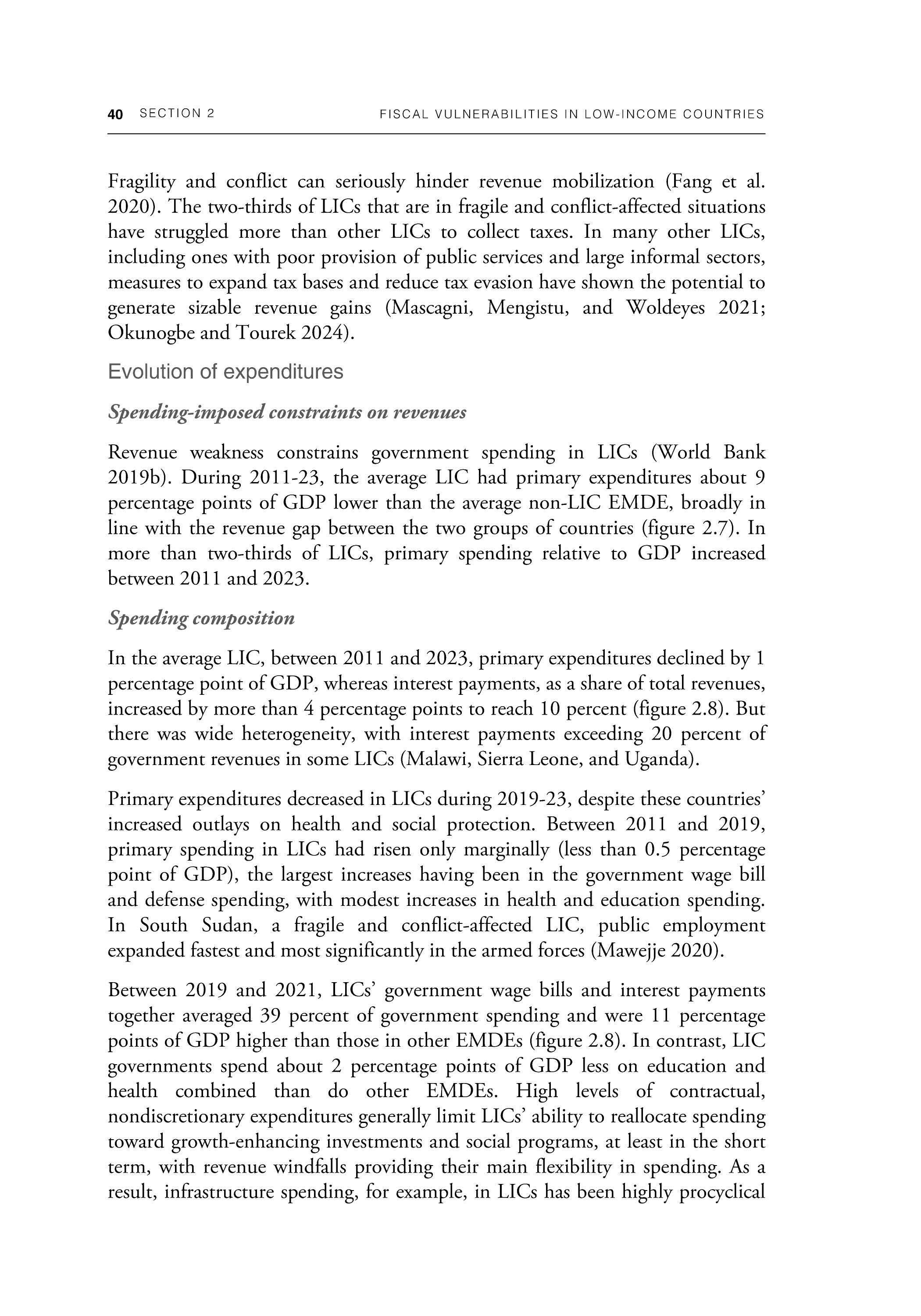
Fragility and conflict can seriously hinder revenue mobilization (Fang et al. 2020). The two-thirds of LI Cs that are in fragile and conflict-affected situations have struggled more than other LICs to collect taxes In many other LICs, including ones with poor provision of public services and large informal sectors, measures to expand tax bases and reduce tax evasion have shown the potential to generate sizable revenue gains (Mascagni, Mengistu, and Woldeyes 2021; Okunogbe and Tourek 2024).
Evolution of expenditures
Spending-imposed constraints on revenues
Revenue weakness constrains government spending in LICs (World Bank 2019b) . During 2011-23, the average LIC had primary expenditures about 9 percentage points of GDP lower than the average non-LIC EMDE, broadly in line with the revenue gap between the two groups of countries (figure 2 .7) . In more than two-thirds of LICs, primary spending relative to GDP increased between 2011 and 2023.
Spending composition
In the average LIC, between 2011 and 2023 , primary expenditures declined by 1 percentage point of GDP, whereas interest payments, as a share of total revenues, increased by more than 4 percentage points to reach 10 percent (figure 2 .8) . But there was wide heterogeneity, with interest payments exceeding 20 percent of government revenues in some LI Cs (Malawi, Sierra Leone, and Uganda).
Primary expenditures decreased in LICs during 2019-23, despite these countries' increased outlays on health and social protection. Between 2011 and 2019, primary spending in LICs had risen only marginally (less than 0 . 5 percentage point of GDP), the largest increases having been in the government wage bill and defense spending, with modest increases in health and education spending. In South Sudan, a fragile and conflict-affected LIC, public employment expanded fastest and most significantly in the armed forces (Mawejje 2020).
Between 2019 and 2021, LICs' government wage bills and interest payments together averaged 39 percent of government spending and were 11 percentage points of GDP higher than those in other EMDEs (figure 2 .8). In contrast, LIC governments spend about 2 percentage points of GDP less on education and health combined than do other EMDEs High levels of contractual, nondiscretionary expenditures generally limit LICs' ability to reallocate spending toward growth-enhancing investments and social programs, at least in the short term, with revenue windfalls providing their main flexibility in spending. As a result, infrastructure spending, for example, in LICs has been highly procyclical
FIGURE 2.8 Government expenditures
Primary spending, relative to GDP, has been consistently lower in L/Cs than in other EMDEs. In L/Cs, on average, governments ' net interest payments increased substantially between 2019 and 2023. With the outbreak of the pandemic, primary spending in L/Cs rose steeply in 2020 A Primary expenditures C Net interest payments
B Primary expenditures in LICs, by country groups
D Composition of government spending
Sources: International Monetary Fund ; World Bank.
Note : EMDEs = emerging market and developing economies ; FCS = fragile and conflict-affected situations ; GDP = gross domestic product; LICs = low-income countries; Other EMDEs = emerging market and developing economies excluding LICs.
A. Bars show unweighted averages , and whiskers show interquartile ranges
B. Lines show unweighted averages.
C. Net interest payments are defined as the difference between the primary balance and the overall balance. Unweighted averages. The orange whiskers show interquartile ranges. Countries with negative net interest payments and those for which data are incomplete are not included in the sample.
D. "Expense" excludes net investment in government nonfinancial assets.
(Foster, Rana, and Gorgulu 2022) . At the same time, the high prevalence of conflict and natural disasters among LI Cs and the fact that 80 percent of LI Cs rely heavily on commodities result in macroeconomic volatility, because countries with greater variability in their tax bases generally exhibit more procydical fiscal policy (figure 2 .9; Talvi and Vegh 2005). In addition, the prevalence of conflict and violence increases pressures for defense spending at the expense of more productive spending, including spending on education, health, and infrastructure.
Spending efficiency
This study finds that, with statistical significance, the efficiency of government spending is weaker in LICs than in other EMDEs in almost all major spending
FIGURE 2.9 Country characteristics and macroeconomic volatility
Recently L!Cs have had a higher incidence of conflict and violence than have other EMDEs. Relative to other EMDEs, L!Cs have a higher average cost of natural disasters, and it has increased more rapidly in recent years. L!Cs are more commonly dependent on commodity exports than other EMDEs. These factors make GDP growth more volatile in L!Cs than in other EMDEs.
C Share of countries that are commodity exporters
Volatility of real GDP growth
Sources: Armed Conflict Location and Event Data (database); EM-DAT (database); International Monetary Fund ; World Bank.
Note : EMDEs = emerging market and developing economies; GDP = gross domestic product ; LICs = low-income countries ; Other EMDEs = emerging market and developing economies excluding LICs.
A. Bars show the number of reported events involving conflict and violence between 2011 and 2022 , for both LICs and non-LIC EMDEs.
B. Bars and diamonds show the weighted average of economic damages from natural disasters as a percentage of GDP. Based on data for up to 17 LI Cs and 105 non-LIC EMDEs
C. Share of commodity exporters among LICs and EMDEs.
D. Bars show the standard deviation of real GDP growth. Based on data for a sample of 146 EMDEs, of which 22 are LICs. The sample period is 2011-23.
categories (figure 2.10). 7 One explanation is less rigorous processes for project appraisal and evaluation as a result of lack of capacity or corruption. The inefficiency of LICs' spending on health and education, combined with their limited reallocation of spending to these categories over the past decade, may intensify the challenges facing LI Cs in these areas.
In part, weak spending efficiency in LICs reflects broader underdevelopment, weak institutions, and associated capacity constraints. As an example, in 2014,
7 Appendix 2 provid es technical d erails on measuring sp ending effici ency.
A. Number of events involving conflict and violence
B. Cost of natural disasters
FIGURE 2.10 Decomposition and efficiency of government expenditures
Government spending on education and the wage bill, as a share of GDP, has been significantly lower in L/Cs compared to EMDEs , but spending on health care has been higher Spending efficiency is weaker in L/Cs, including in infrastructure and health.
A Government expenditure: Major spending categories, 2011-22
B. Government expenditure: Major spending categories, 2011 and 2020
C. Spending efficiency, 2008-18
D Difference in efficiency of infrastructure spending in top and bottom quartiles of EMDEs , 2006-16
Sources: Dabla-Norris et al. (2012) ; International Monetary Fund; World Bank; World Economic Forum.
Note : EMDEs = emerging market and developing economies ; LICs = low-income countries; Other EMDEs = emerging market and developing economies excluding LICs ; PIMI = Public Investment Management Index. Unweighted averages for LICs and other EMDEs for each spending category in percent of GDP.
A. Data for up to 26 LICs.
B Data for up to 20 LICs.
C. Data for up to 120 EMDEs , including up to 21 LICs. PIMI refers to the IMF's Public Investment Management Index.
D Data for up to 95 EMDEs
··• shows statistical significance at the 1 percent level,• • at the 5 percent level , and• at the 10 percent le ve l.
the Guinean government planned to build a $20 billion infrastructure project, consisting of heavy-duty railways and a new port, to help export some of the world's highest-grade iron ore from Simandou. But the project stalled in 2017 amid corruption allegations and ownership changes (World Bank 2018b).
References
Akitoby, B. , A. Baum, C. Hackney, 0 . Harrison, K. Primus, and V . Salins. 2018. "Tax Revenue Mobilization Episodes in Emerging Markets and LowIncome Countries: Lessons from a New Dataset." IMF Working Paper 18/234, International Monetary Fund, Washington, DC.
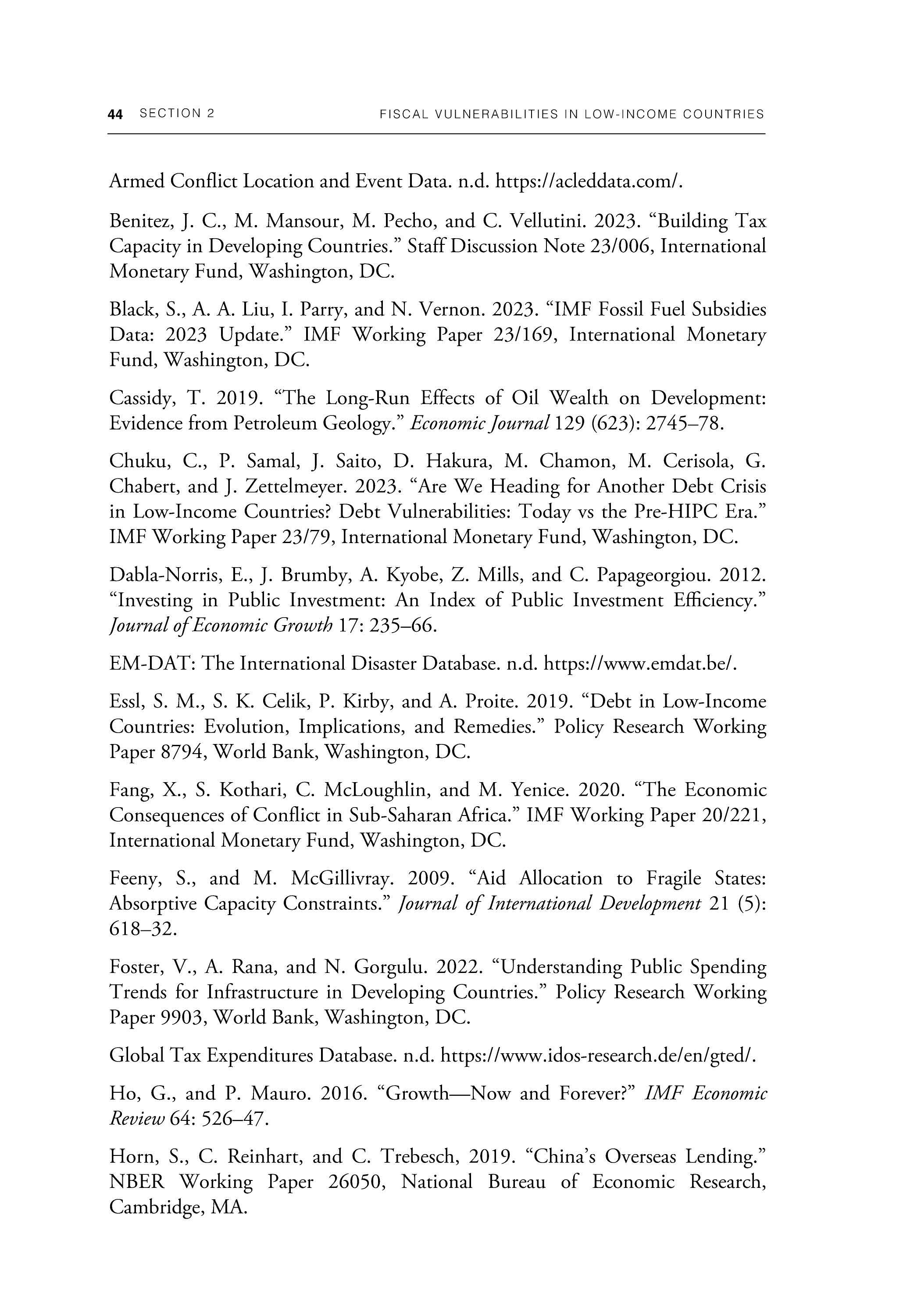
Armed Conflict Location and Event Data. n.d. https:/ /acleddata.com/.
Benitez, J. C., M. Mansour, M. Pecho, and C. Vellutini. 2023. "Building Tax Capacity in Developing Countries " Staff Discussion Note 23/006, International Monetary Fund, Washington , DC.
Black, S , A. A. Liu, I. Parry, and N Vernon 2023 "IMF Fossil Fuel Subsidies Data: 2023 Update." IMF Working Paper 23/169, International Monetary Fund, Washington, DC.
Cassidy, T . 2019. "The Long-Run Effec t s of Oil Wealth on Development: Evidence from Petroleum Geology." Economic journal 129 (623) : 2745-78.
Chuku , C., P . Samal, J. Saito, D. Hakura, M . Chamon, M. Cerisola, G . Chabert, and J. Zettelmeyer. 2023. "Are We Heading for Another Debt Crisis in Low-Income Countries? Debt Vulnerabilities: Today vs the Pre-HIPC Era." IMF Working Paper 23/79, International Monetary Fund, Washington, DC.
Dabla-Norris, E , J. Brumby, A. Kyobe, Z. Mills, and C. Papageorgiou. 2012. "Investing in Public Investment : An Index of Public Investment Efficiency." Journal ofEconomic Growth 17: 235-66.
EM-DAT: The International Disaster Database. n.d. https:/ /www.emdat.be/.
Essl, S. M., S. K. Celik, P. Kirby, and A. Proite. 2019. "Debt in Low-Income Countries : Evolution, Implications, and Remedies." Policy Research Working Paper 8794, World Bank, Washington , DC.
Fang, X., S. Kothari, C. Mcloughlin, and M. Yenice. 2020. "The Economic Consequences of Conflict in Sub-Saharan Africa. " IMF Working Paper 20/221 , International Monetary Fund, Washington, DC.
Feeny, S., and M. McGillivray. 2009 . "Aid Allocation to Fragile States: Absorptive Capacity Constraints." Journal of International Development 21 (5): 618-32.
Foster, V ., A . Rana, and N . Gorgulu. 2022. "Understanding Public Spending Trends for Infrastructure in Developing Countries." Policy Research Working Paper 9903, World Bank, Washington , DC.
Global Tax Expenditures Database n.d. https:/ /www.ido s-research.de / en/ gted/.
Ho, G., and P. Mauro. 2016. "Growth-Now and Forever?" IMF Economic Review 64 : 526-47.
Horn, S., C. Reinhart, and C. Trebesch, 2019 . "China's Overseas Lending." NBER Working Paper 26050, National Bureau of Economic Research, Cambridge, MA.
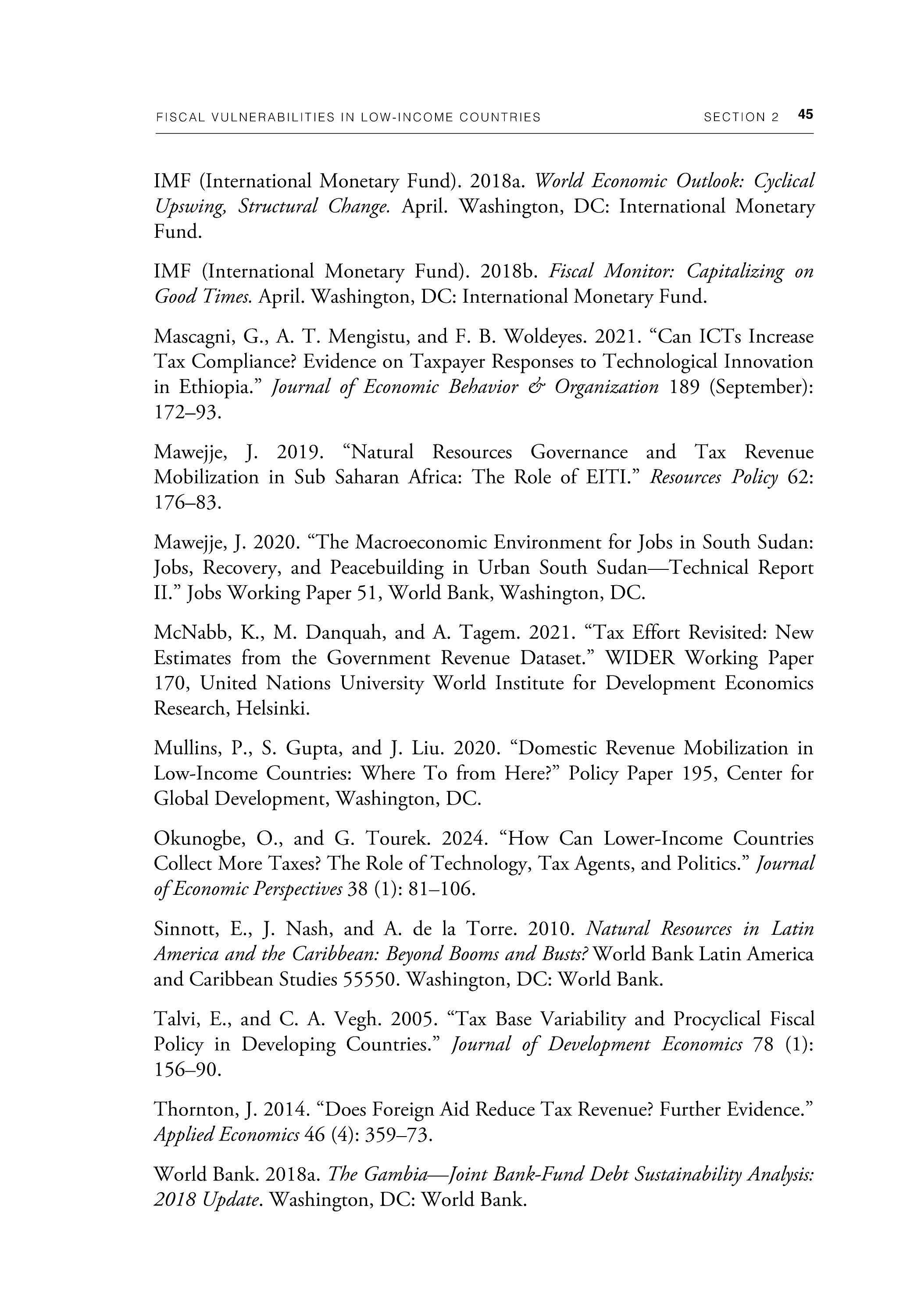
IMF (International Monetary Fund) . 2018a. World Economic Outlook: Cyclical Upswing, Structural Change April. Washington, DC: International Monetary Fund
IMF (International Monetary Fund). 2018b. Fiscal Monitor: Capitalizing on Good Times. April. Washington, DC : International Monetary Fund .
Mascagni , G . , A. T . Mengistu, and F . B. Woldeyes . 2021. "Can ICTs Increase Tax Compliance? Evidence on Taxpayer Responses to Technological Innovation in Ethiopia " Journal of Economic Behavior & Organization 189 (September): 172-93.
Mawejje, J. 2019. "Natural Resources Governance and Tax Revenue Mobilization in Sub Saharan Africa: The Role of EITI." Resources Policy 62: 176-83.
Mawejje , J. 2020. "The Macroeconomic Environment for Jobs in South Sudan: Jobs, Recovery, and Peacebuilding in Urban South Sudan-Technical Report II." Jobs Working Paper 51, World Bank, Washington, DC.
McNabb, K., M. Danquah, and A. Tagem. 2021. "Tax Effort Revisited: New Estimates from the Government Revenue Dataset." WIDER Working Paper 170, United Nations University World Institute for Development Economics Research, Helsinki .
Mullins, P ., S. Gupta, and J. Liu. 2020. "Domestic Revenue Mobilization in Low-Income Countries: Where To from Here?" Policy Paper 195, Center for Global Development, Washington, DC.
Okunogbe, 0., and G. Tourek. 2024. "How Can Lower-Income Countries Collect More Taxes? The Role of Technology, Tax Agents, and Politics." Journal ofEconomic Perspectives 38 (1): 81-106 .
Sinnott, E., J. Nash, and A . de la Torre. 2010. Natural Resources in Latin America and the Caribbean: Beyond Booms and Busts? World Bank Latin America and Caribbean Studies 55550. Washington, DC: World Bank.
Talvi, E. , and C. A . Vegh . 2005. "Tax Base Variability and Procyclical Fiscal Policy in Developing Countries." Journal of Development Economics 78 (1): 156-90.
Thornton , J . 2014. "Does Foreign Aid Reduce Tax Revenue? Further Evidence . " Applied Economics 46 (4): 359-73 .
World Bank. 2018a. The Gambia-Joint Bank-Fund Debt Sustainability Analysis: 2018 Update. Washington, DC : World Bank.
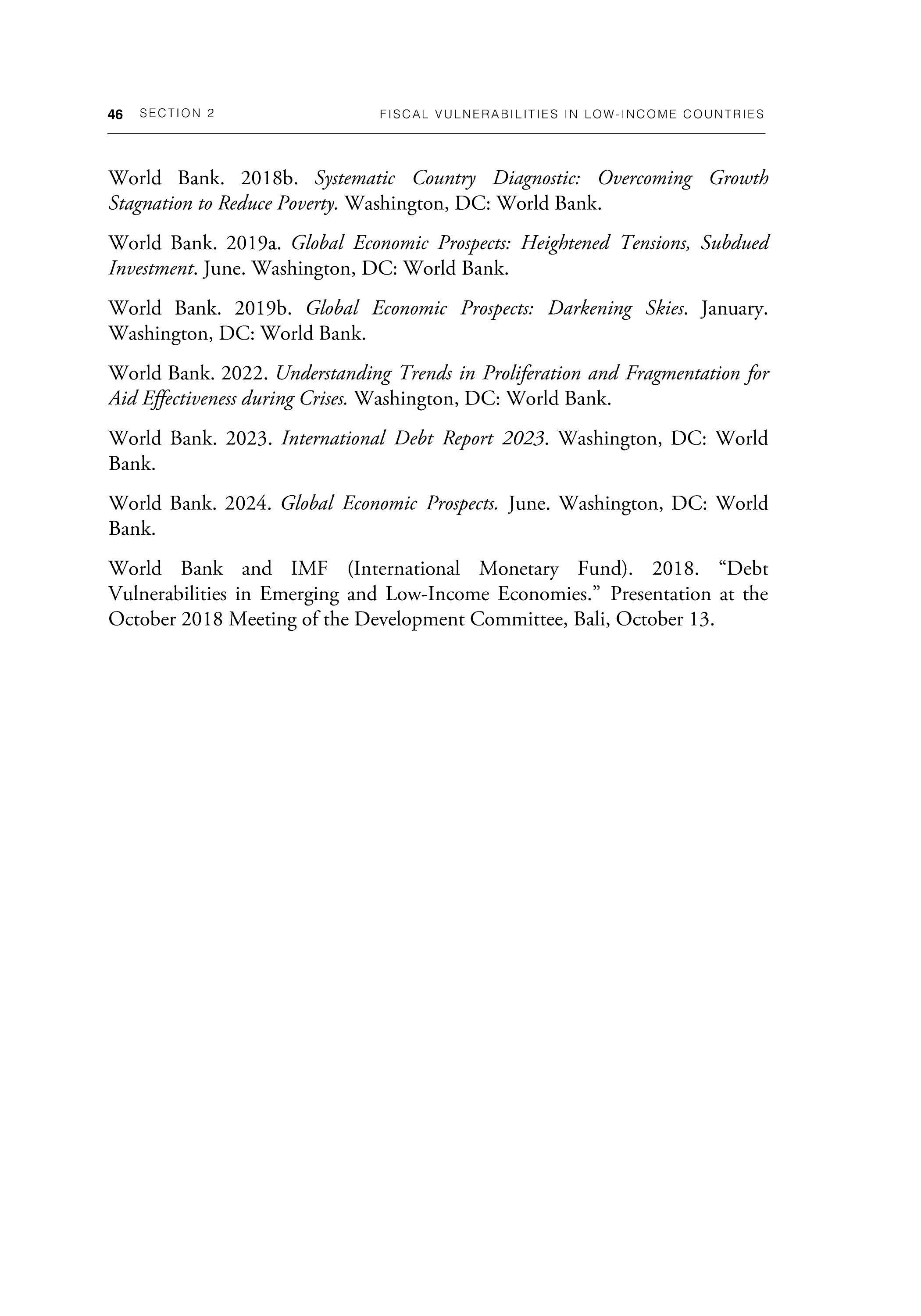
World Bank. 2018b . Systematic Country Diagnostic: Overcoming Growth Stagnation to Reduce Poverty. Washington, DC: World Bank.
World Bank. 2019a. Global Economic Prospects: Heightened Tensions, Subdued Investment. June. Washington, DC: World Bank.
World Bank. 2019b. Global Economic Prospects: Darkening Skies . January. Washington, DC: World Bank.
World Bank. 2022 . Understanding Trends in Proliferation and Fragmentation for Aid Effectiveness during Crises. Washington, DC: World Bank.
World Bank. 2023. International Debt Report 2023. Washington, DC: World Bank.
World Bank. 2024. Global Economic Prospects. June. Washington, DC: World Bank
World Bank and IMF (International Monetary Fund) 2018 "Debt Vulnerabilities in Emerging and Low-Income Economies." Presentation at the October 2018 Meeting of the Development Committee, Bali , October 13.

3. Fiscal Vulnerability to Shocks
The fiscal positions of low-income countries (LICs) are vulnerable to various types of shocks . LICs' high dependence on official development assistance and commodity exports, as well as their narrow export bases, make their fiscal positions vulnerable to global economic shocks, particularly recessions and large movements in commodity prices (IMF 2024). Political instability and armed conflict are relatively common in LICs, and they can substantially disrupt economic activity and increase defense spending, exacerbating countries' existing challenges. Many LICs are also highly vulnerable to extreme weather because of their geographic locations , their dependence on agriculture, constraints on their capacity, and their limited buffers. Climate change exacerbates this vulnerability by causing more frequent and intense natural disasters affecting larger populations and resulting in significant economic losses (Donatti et al. 2024). This study estimates the effects of these types of shocks on LICs' fiscal balances and debt positions using event studies (see appendix 3 for methodological details).
Global recessions. LICs' fiscal positions can weaken substantially during global recessions, with their primary balances and the ratios of their debt to gross domestic product (GDP) deteriorating for up to five years from the start of a recession (Kose et al. 2021). Reduced demand for commodity exports can lower both prices and export volumes, reducing fiscal revenues for commodityexporting countries. Receipts of remittances also tend to weaken, depressing consumer spending and consumption-based tax revenues. Increased needs for social spending to support vulnerable groups and lower levels of development assistance can further strain fiscal positions. Limited access to international financial markets can reduce the ability of LI Cs to conduct countercyclical fiscal policy. Coupled with more prolonged weakness in economic activity, the aftermath of global recessions may make it take longer for LICs to unwind fiscal deficits, resulting in more accumulation of debt in LICs than in other emerging market and developing economies (EMDEs) (World Bank 2023).
Domestic armed conflicts. Armed conflicts disrupt economic activity, destroy physical and human capital, reduce investment, and weaken institutions, resulting in contractions in actual and potential output in the affected countries
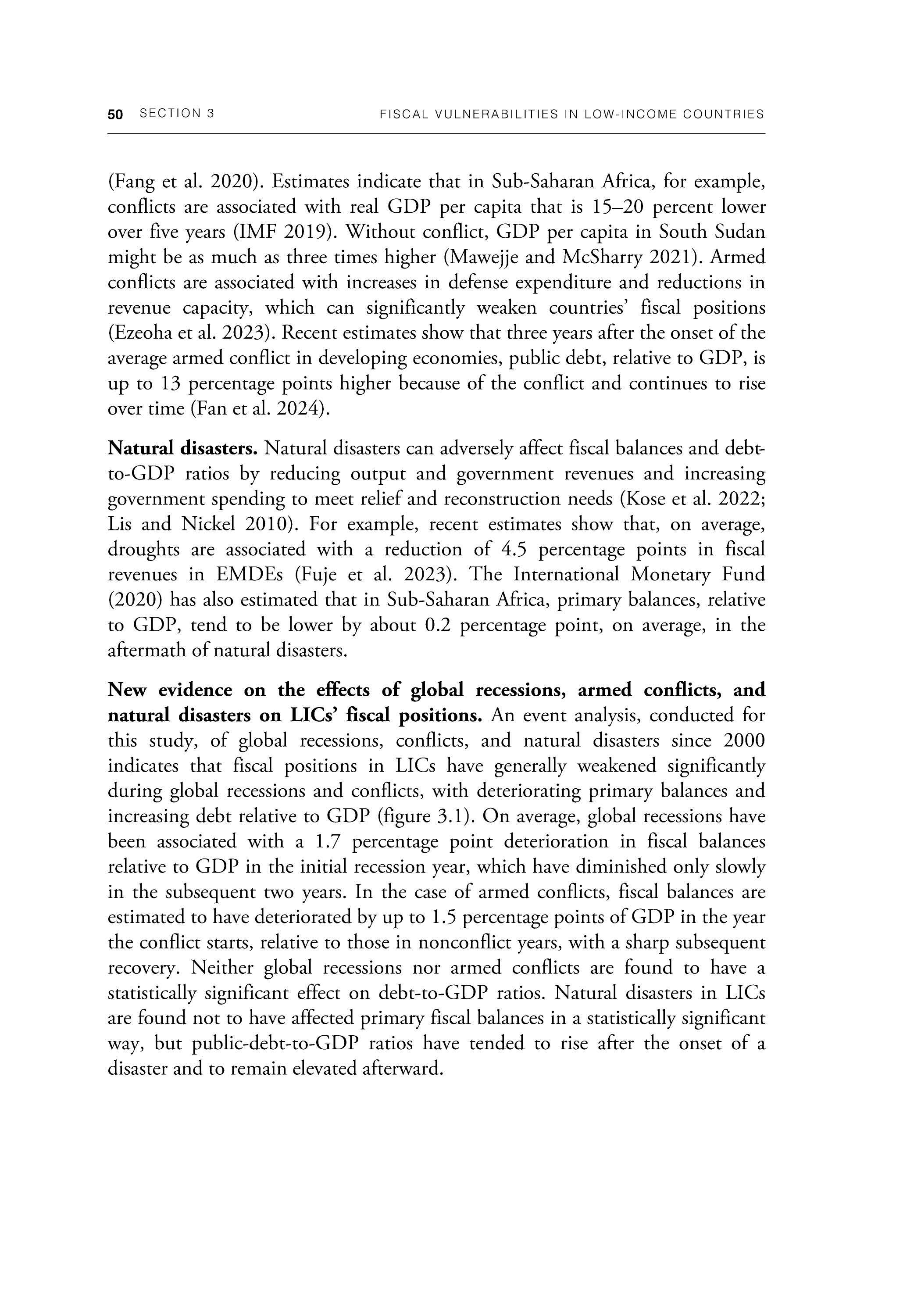
(Fang et al. 2020) . Estimates indicate that in Sub-Saharan Africa, for example, conflicts are associated with real GDP per capita that is 15-20 percent lower over five years (IMF 2019). Without conflict, GDP per capita in South Sudan might be as much as three times higher (Mawejje and McSharry 2021). Armed conflicts are associated with increases in defense expenditure and reductions in revenue capacity, which can significantly weaken countries' fiscal positions (Ezeoha et al. 2023). Recent estimates show that three years after the onset of the average armed conflict in developing economies, public debt, relative to GDP, is up to 13 percentage points higher because of the conflict and continues to rise over time (Fan et al. 2024).
Natural disasters. Natural disasters can adversely affect fiscal balances and debcto-GDP ratios by reducing output and government revenues and increasing government spending to meet relief and reconstruction needs (Kose et al. 2022; Lis and Nickel 2010). For example , recent estimates show that, on average , droughts are associated with a reduction of 4 .5 percentage points in fiscal revenues in EMDEs (Fuje et al. 2023) . The International Monetary Fund (2020) has also estimated chat in Sub-Saharan Africa, primary balances, relative to GDP, tend to be lower by about 0 2 percentage point, on average, in the aftermath of natural disasters.
New evidence on the effects of global recessions, armed conflicts, and natural disasters on LICs' fiscal positions. An event analysis, conducted for this study, of global recessions, conflicts, and natural disasters since 2000 indicates that fiscal positions in LICs have generally weakened significantly during global recessions and conflicts, with deteriorating primary balances and increasing debt relative to GDP (figure 3 1). On average, global recessions have been associated with a 1. 7 percentage point deterioration in fiscal balances relative to GDP in the initial recession year, which have diminished only slowly in the subsequent two years. In the case of armed conflicts, fiscal balances are estimated to have deteriorated by up to 1.5 percentage points of GDP in the year the conflict starts, relative to those in nonconflict years, with a sharp subsequent recovery. Neither global recessions nor armed conflicts are found to have a statistically significant effect on debt-to-GDP ratios . Natural disasters in LICs are found not to have affected primary fiscal balances in a statistically significant way, but public-debt-to-GDP ratios have tended to rise after the onset of a disaster and to remain elevated afterward.
FIGURE 3.1 Fiscal outcomes around major adverse events
Estimates for this study indicate that during 2000-23, fiscal balances and government debt in L/Cs weakened in a statistically significant way following global recessions and domestic conflict events. On average, global recessions were associated with deteriorations in fiscal balances averaging 1. 7 percentage points of GDP in the recession year, and intense conflict events were associated with deteriorations in fiscal balances averaging 1.5 percentage points of GDP in the following year.
A. Primary balances around global recessions B. Debt around global recessions
PercentofGDP
Primarybalance ConfidenceInterval
C Primary balances around conflicts
PercentofGDP
Changeingovernmentdebt Confidenceinterval
D. Debt around conflicts
PercentofGDP
Changeingovernmentdebt Confidenceinterval
E. Primary balances around natural disasters F. Debt around natural disasters
PercentofGDP
Changeingovernmentdebt Confidenceinterval
Sources: EM-DAT (database); UCDP Battle-Related Deaths Dataset (database); WEO (database); World Bank.
Note: Solid blue lines are the coefficients of estimations in which each fiscal indicator is regressed on a series of dummy variables for each adverse event in year t, based on data for LICs. Dotted red lines are 90 percent confidence intervals. The events include global recessions , intense conflicts, and natural disasters. The database for the estimations covered the period 2000-23. GDP= gross domestic product ; LICs = low-income countries ; WEO = World Economic Outlook
A.B. Changes in fiscal balances and debt-to-GDP ratios around global recessions. Based on data for 25 LICs in panel A and 24 LICs in panel B. Years of global recessions (2009 and 2020) are identified in Kase , Sugawara , and Terrones (2020).
G.D. Changes in fiscal balances and debt-to-GDP ratios around conflict events. Based on data for 25 LICs in panel C and 24 LICs in panel D The identification of conflict episodes is based on data for battle-related deaths in the UCDP Battle-Related Deaths Dataset, version 24.1 (Davies et al. 2024).
E.F. Changes in fiscal balances and debt-to-GDP ratios around natural disasters. Based on data for 25 LICs in panel E and 24 LICs in panel F
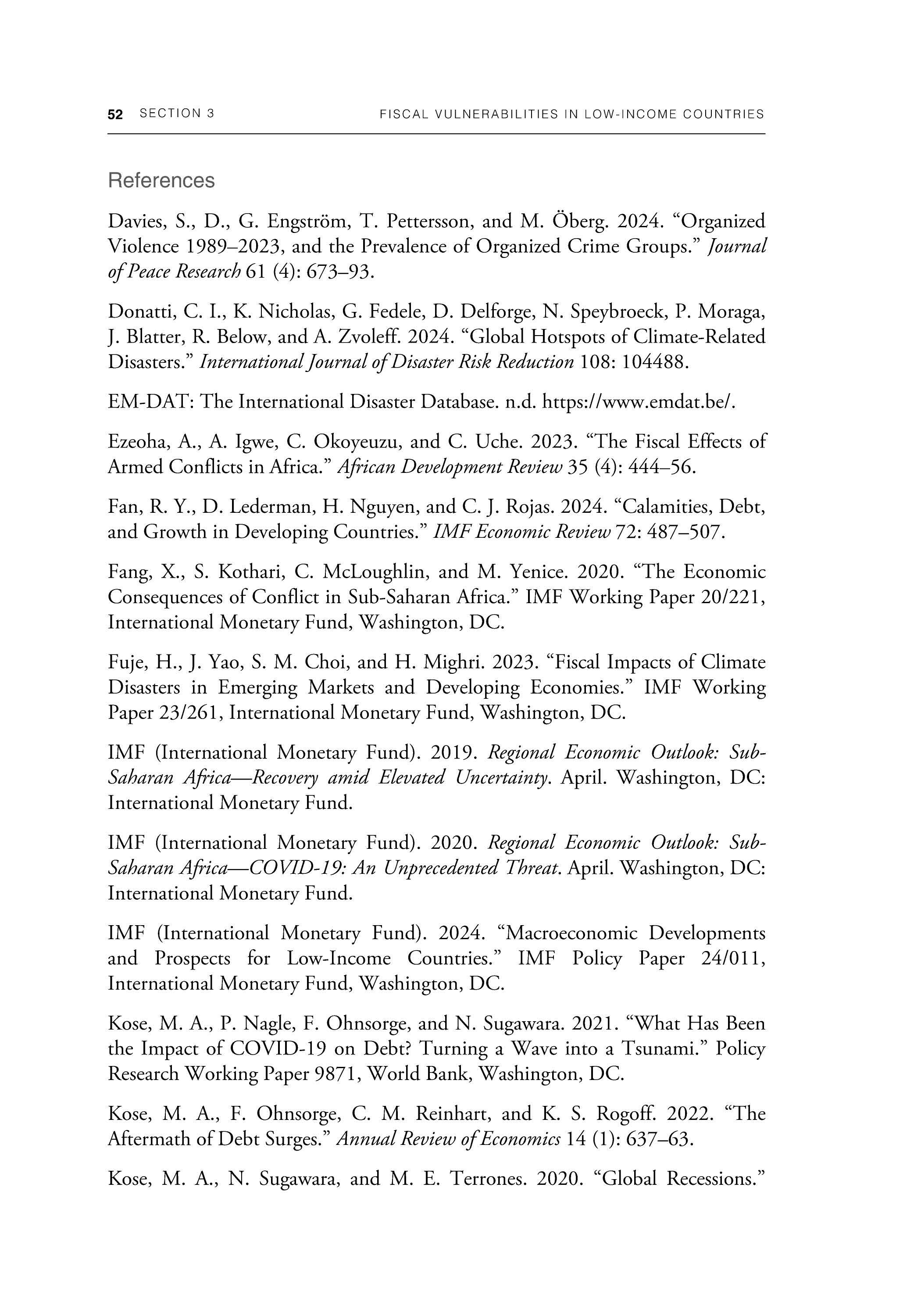
References
Davies, S , D., G Engstrom, T. Pettersson, and M. Oberg. 2024. "Organized Violence 1989-2023, and the Prevalence of Organized Crime Groups ." Journal ofPeace Research 61 (4) : 673-93 .
Donatti, C. I., K. Nicholas, G. Fedele, D. Delforge, N. Speybroeck, P . Moraga, J. Blatter, R. Below, and A. Zvoleff. 2024. "Global Hotspots of Climate-Related Disasters " International journal of Disaster Risk Reduction l 08 : 104488.
EM-DAT: The International Disaster Database. n.d. https:/ /www.emdat.be/.
Ezeoha, A., A. Igwe, C. Okoyeuzu, and C. Uche. 2023. "The Fiscal Effects of Armed Conflicts in Africa." African Development Review 35 (4): 444-56.
Fan, R. Y., D. Lederman, H. Nguyen, and C. J. Rojas. 2024. "Calamities, Debt, and Growth in Developing Countries." IMF Economic Review 72: 487-507.
Fang, X., S. Kothari, C. Mcloughlin, and M. Yenice . 2020. "The Economic Consequences of Conflict in Sub-Saharan Africa." IMF Working Paper 20/221, International Monetary Fund, Washington, DC.
Fuje, H . , J. Yao, S. M. Choi, and H. Mighri . 2023. "Fiscal Impacts of Climate Disasters in Emerging Markets and Developing Economies." IMF Working Paper 23/261, International Monetary Fund , Washington, DC.
IMF (International Monetary Fund). 2019. Regional Economic Outlook: SubSaharan Africa-Recovery amid Elevated Uncertainty. April. Washington, DC: International Monetary Fund.
IMF (International Monetary Fund) . 2020 . Regional Economic Outlook: SubSaharan Africa-COVID-19: An Unprecedented Threat. April. Washington, DC: International Monetary Fund.
IMF (International Monetary Fund). 2024 "Macroeconomic Developments and Prospects for Low-Income Countries." IMF Policy Paper 24/011, International Monetary Fund, Washington, DC.
Kose, M.A., P . Nagle, F. Ohnsorge, and N . Sugawara . 2021. "What Has Been the Impact of COVID-19 on Debt? Turning a Wave into a Tsunami " Policy Research Working Paper 9871, World Bank, Washington, DC.
Kose, M . A., F. Ohnsorge, C. M . Reinhart, and K. S. Rogoff. 2022. "The Aftermath of Debt Surges." Annual Review ofEconomics 14 (1): 637-63.
Kose, M. A., N. Sugawara, and M . E . Terrones. 2020. "Global Recessions."
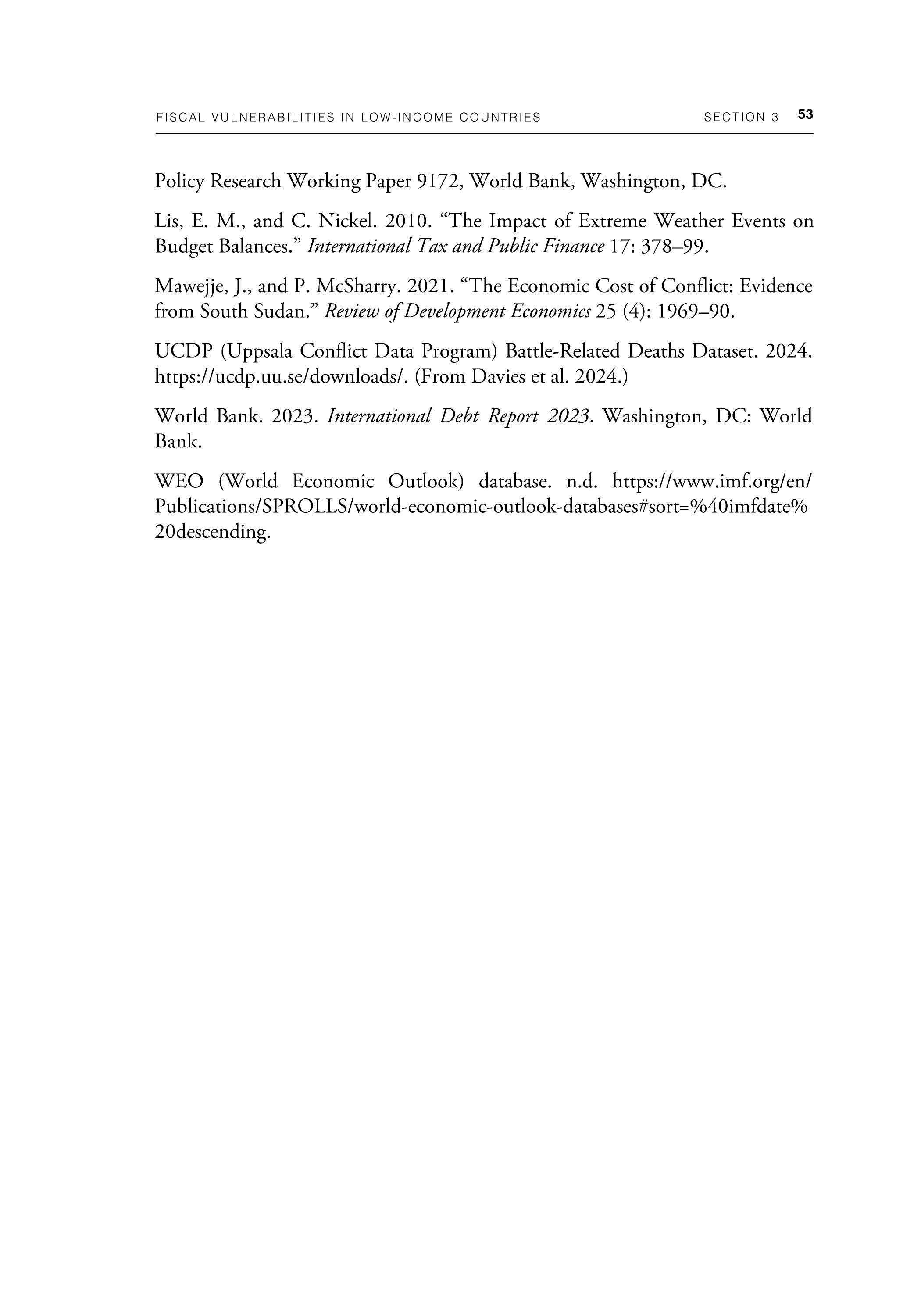
Policy Research Working Paper 9172, World Bank, Washington, DC.
Lis, E. M., and C. Nickel. 2010. "The Impact of Extreme Weather Events on Budget Balances." International Tax and Public Finance 17: 378-99.
Mawejje, J., and P. McSharry. 2021. 'The Economic Cost of Conflict : Evidence from South Sudan." Review of Development Economics 25 (4): 1969-90.
UCDP (Uppsala Conflict Data Program) Battle-Related Deaths Dataset. 2024. https ://ucdp.uu.se/downloads/. (From Davies et al. 2024 .)
World Bank. 2023 . International Debt Report 2023. Washington, DC: World Bank.
WEO (World Economic Outlook) database n d https ://www.imf.org/en/ Publications/SPROLLS/world-economic-outlook-databases#sort=%40imfdate% 20descending.

4. Fiscal Policy Options in Low-Income Countries
Revenue weakness constrains low-income country (LIC) governments' ability to provide public goods and services, invest in infrastructure, conduct countercyclical policies, service their debt, and effectively implement redistributive measures. The constraints are particularly challenging for LICs now, with an increase in conflicts, more frequent natural disasters, and other adverse events threatening to keep food insecurity and poverty at elevated levels (World Bank 2024a). The weakness in government revenues in LICs and the resulting spending constraints and accumulation of debt highlight three policy priorities for these countries: more effective domestic resource mobilization, greater spending efficiency, and sounder debt management . These priorities should help guide broad reform efforts to ease structural constraints, reduce informality, address market failures, strengthen institutions, and generate stronger and more broad-based economic growth (Newbery and Stern 1987; Stiglitz and Rosengard 2015). Meanwhile, LICs can gear aid in the form of grants or concessional lending particularly toward addressing critical emerging challenges, including the effects of climate change, fragility, and pandemics (Fardoust et al. 2023).
Domestic resource mobilization
LICs have wide scope to improve their revenue mobilization, despite their low levels of development. Recent estimates show that LICs have collected less than two-thirds of their potential tax revenue over the past decade (Mawejje and Sebudde 2019; McNabb, Danquah, and Tagem 2021). Thus, they can gain substantial revenues through measures such as broadening their tax bases, strengthening their tax administrations, and making their tax systems more equitable and efficient. If implemented progressively, tax reforms can also help LICs achieve their redistribution goals. LICs have lower income and consumption tax efficiencies than do other emerging market and developing economies (EMDEs), possibly reflecting widespread informality and, in some cases, corruption, but they have higher trade tax efficiency (figure 4.1). Comprehensive reforms of tax policy and revenue administration, including, for example, the introduction of arrangements to set aside windfalls from improvements in a
FIGURE 4.1 Domestic resource mobilization
L/Cs have lower income and consumption tax efficiencies than other EMDEs , possibly reflecting widespread informality, but higher trade tax efficiency
D Differences in fiscal indicators between EMDEs with above-median levels of informality and those with below-median levels
Sources : Dabla-Norris et al. (2012); International Monetary Fund; Ohnsorge and Yu (2022); Penn World Table 9.1; World Bank; World Economic Forum.
Note : Panels A-C show unweighted averages EMDEs = emerging market and developing economies; GDP= gross domestic product ; LICs = low-income countries; Other EMDEs = emerging market and developing economies excluding LICs
A. The ratio of personal income tax revenue to total labor compensation. Share of labor compensation in GDP and real GDP (2011 dollars) are from Penn World Table. Based on data for 66 EMDEs (excl. LICs) and 12 LICs.
B. The ratio of consumption tax revenue to consumption. Consumption tax revenue is the sum of revenues from goods and services , va lue added, and excise taxes. Data are from Penn World Table 9.1. Based on data for 81 EMDEs (excl. LICs), and 18 LICs.
C. The ratio of trade tax revenue to total trade , defined as the sum of imports and exports of goods and services (in local currency , from the International Monetary Fund 's International Financial Statistics). Based on data for 103 EMDEs (excl. LICs) and 24 LICs.
D Difference (in percentage points of GDP) between average fiscal indicators among EMDEs with above-median levels of informality and those w ith below-median levels , according to their shares of informal output in percent of official GDP (estimates based on dynamic general equilibrium models from Ohnsorge and Yu 2022). Vertical bars indicate 90 percent confidence intervals for the differences. Fiscal indicators and informality measures are 2000-18 ave rages. The sample includes 70 non-energy-exporting EMDEs w ith populations above 3 million people Blue bars show the unweighted averages, whiskers the interquartile ranges , unless otherwise specified. Based on data for 117 EMDEs, including 24 LICs.
country's terms of trade, have usually accompanied past successful efforts to increase tax revenue mobilization in LICs and other EMDEs (Akitoby et al. 2018). Global mechanisms for coordinating tax policy design and implementation and limiting illicit financial flows are needed to support such reforms.
Tax policy. Past tax policy reforms in LICs have generally involved measures to increase indirect tax rates and broaden bases for both direct and indirect taxation (Akitoby et al. 2018). Tax bases can be broadened by removing exemptions,
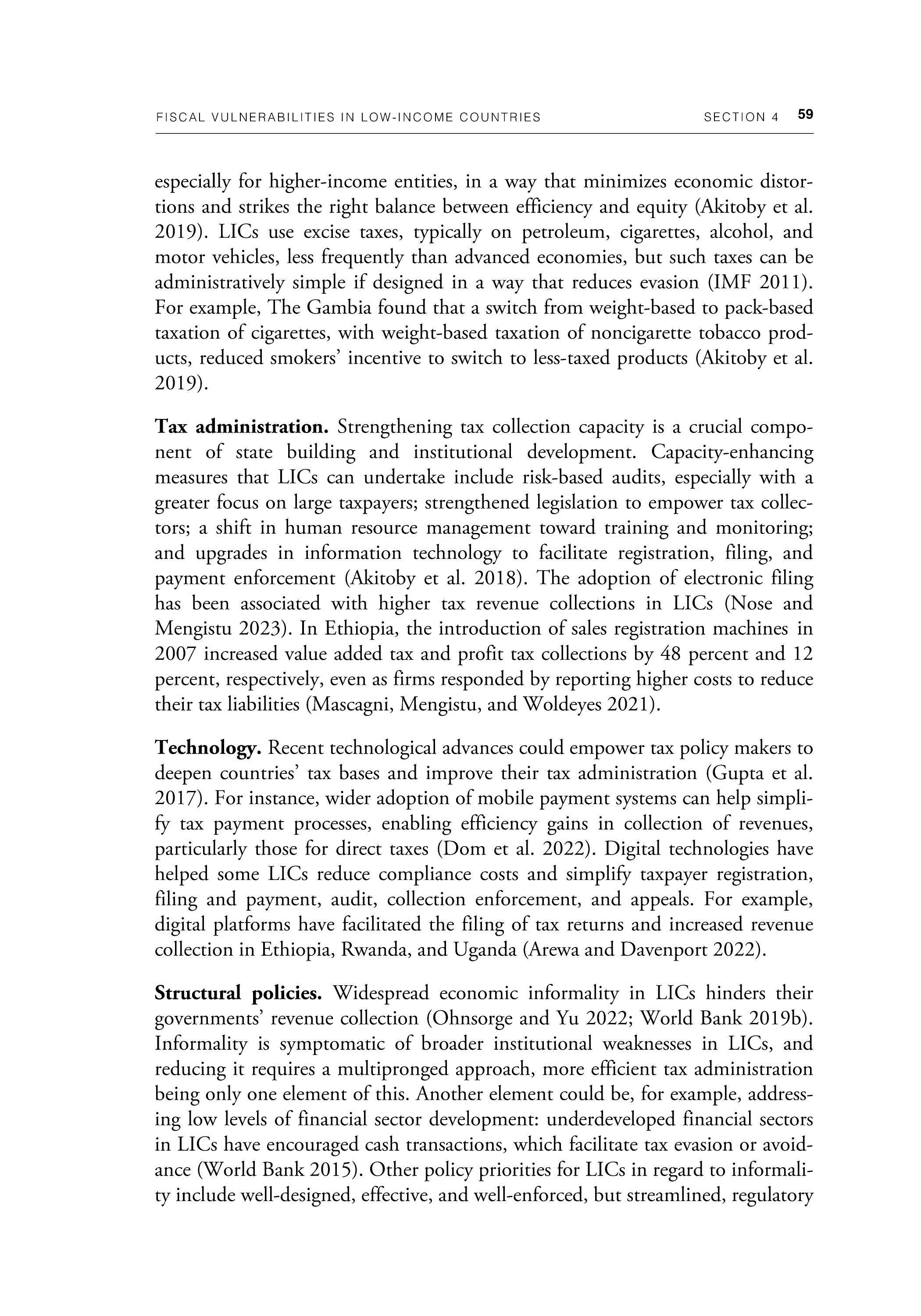
especially for higher-income entities, in a way that minimizes economic distortions and strikes the right balance between efficiency and equity (Akitoby et al. 2019) LICs use excise taxes, typically on petroleum, cigarettes, alcohol , and motor vehicles, less frequently than advanced economies, but such taxes can be administratively simple if designed in a way that reduces evasion (IMF 2011). For example, The Gambia found that a switch from weight-based to pack-based taxation of cigarettes, with weight-based taxation of noncigarette tobacco products, reduced smokers' incentive to switch to less-taxed products (Akitoby et al. 2019).
Tax administration. Strengthening tax collection capacity is a crucial component of state building and institutional development. Capacity-enhancing measures that LICs can undertake include risk-based audits, especially with a greater focus on large taxpayers; strengthened legislation to empower tax collectors; a shift in human resource management toward training and monitoring; and upgrades in information technology to facilitate registration, filing , and payment enforcement (Akitoby et al. 2018). The adoption of electronic filing has been associated with higher tax revenue collections in LICs (Nose and Mengistu 2023). In Ethiopia, the introduction of sales registration machines in 2007 increased value added tax and profit tax collections by 48 percent and 12 percent, respectively, even as firms responded by reporting higher costs to reduce their tax liabilities (Mascagni, Mengistu, and Woldeyes 2021).
Technology. Recent technological advances could empower tax policy makers to deepen countries ' tax bases and improve their tax administration (Gupta et al . 2017) . For instance , wider adoption of mobile payment systems can help simplify tax payment processes, enabling efficiency gains in collection of revenues, particularly those for direct taxes (Dom et al. 2022). Digital technologies have helped some LICs reduce compliance costs and simplify taxpayer registration, filing and payment, audit, collection enforcement, and appeals. For example, digital platforms have facilitated the filing of tax returns and increased revenue collection in Ethiopia , Rwanda, and Uganda (Arewa and Davenport 2022).
Structural policies. Widespread economic informality in LICs hinders their governments' revenue collection (Ohnsorge and Yu 2022; World Bank 2019b) . Informality is symptomatic of broader institutional weaknesses in LICs, and reducing it requires a multipronged approach, more efficient tax administration being only one element of chis . Another element could be, for example, addressing low levels of financial sector development: underdeveloped financial sectors in LICs have encouraged cash transactions, which facilitate tax evasion or avoidance (World Bank 2015). Other policy priorities for LICs in regard to informality include well-designed, effective, and well-enforced , but streamlined, regulatory
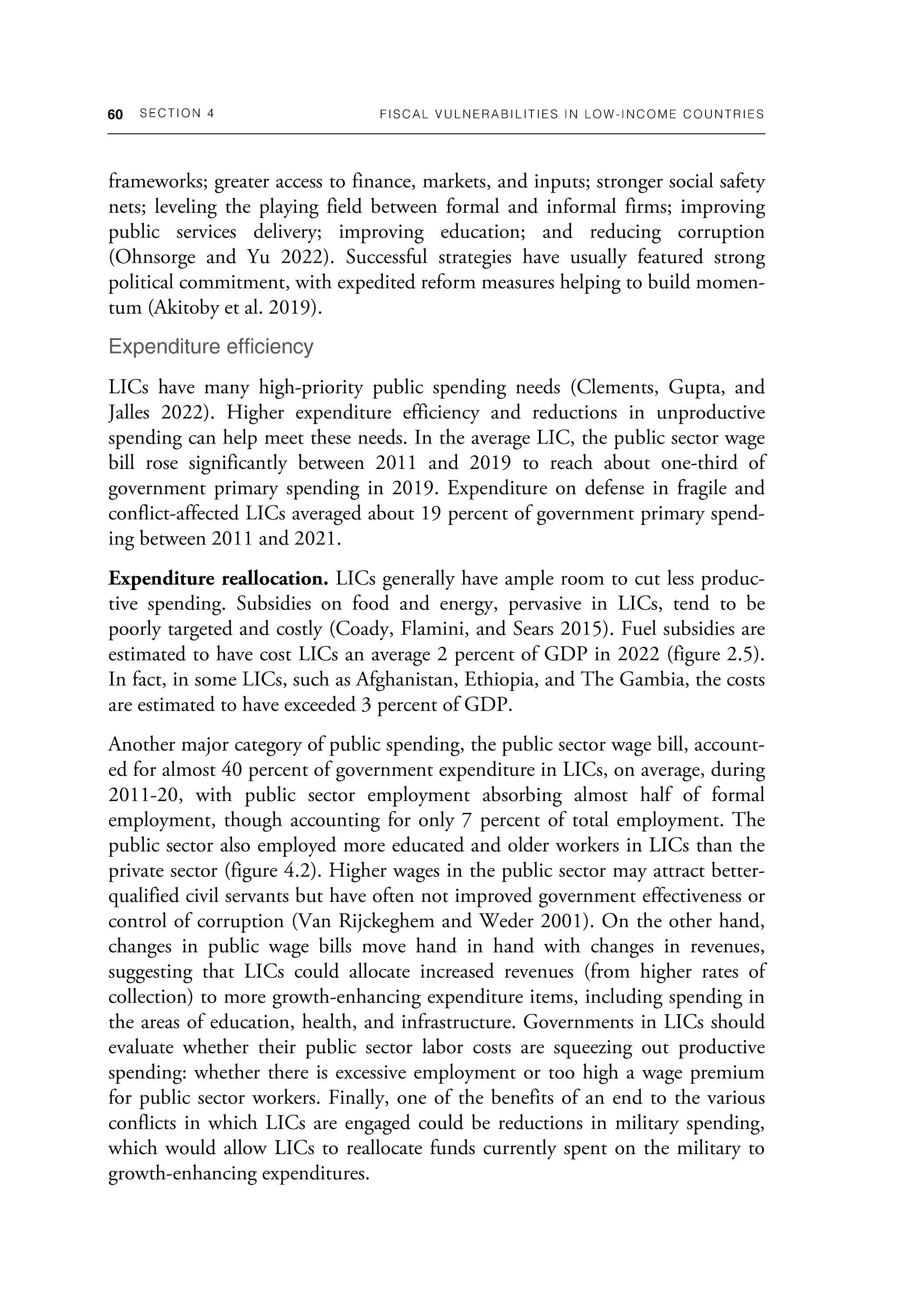
frameworks; greater access to finance, markets, and inputs; stronger social safety nets; leveling the playing field between formal and informal firms; improving public services delivery; improving education; and reducing corruption (Ohnsorge and Yu 2022). Successful strategies have usually featured strong political commitment, with expedited reform measures helping to build momentum (Akitoby et al. 2019).
Expenditure efficiency
LICs have many high-priority public spending needs (Clements, Gupta, and Jalles 2022). Higher expenditure efficiency and reductions in unproductive spending can help meet these needs. In the average UC, the public sector wage bill rose significantly between 2011 and 2019 to reach about one-third of government primary spending in 2019. Expenditure on defense in fragile and conflict-affected LICs averaged about 19 percent of government primary spending between 2011 and 2021.
Expenditure reallocation. LICs generally have ample room to cut less productive spending. Subsidies on food and energy, pervasive in LICs, tend to be poorly targeted and costly (Coady, Flamini , and Sears 2015) Fuel subsidies are estimated to have cost LICs an average 2 percent of GDP in 2022 (figure 2.5). In fact, in some LICs, such as Afghanistan, Ethiopia, and The Gambia, the costs are estimated to have exceeded 3 percent of GDP.
Another major category of public spending, the public sector wage bill, accounted for almost 40 percent of government expenditure in LICs, on average, during 2011-20, with public sector employment absorbing almost half of formal employment, though accounting for only 7 percent of total employment . The public sector also employed more educated and older workers in LICs than the private sector (figure 4.2). Higher wages in the public sector may attract betterqualified civil servants but have often not improved government effectiveness or control of corruption (Van Rijckeghem and Weder 2001). On the other hand, changes in public wage bills move hand in hand with changes in revenues, suggesting that LICs could allocate increased revenues (from higher rates of collection) to more growth-enhancing expenditure items, including spending in the areas of education, health, and infrastructure. Governments in LICs should evaluate whether their public sector labor costs are squeezing out productive spending: whether there is excessive employment or too high a wage premium for public sector workers. Finally, one of the benefits of an end to the various conflicts in which LICs are engaged could be reductions in military spending, which would allow LICs to reallocate funds currently spent on the military to growth-enhancing expenditures.
FIGURE 4.2 Expenditure efficiency
L/Cs can increase the efficiency of their government expenditure in part by reallocating spending to more growth-enhancing categories, including education. Within spending on education, resources could be redirected or augmented to boost learning
Sharewithtertiary education Meanage(RHS)
Sources: Dabla-Norris et al. (2012) ; International Monetary Fund (IMF); United Nations Educational , Scientific and Cultural Organization (UNESCO) Institute for Statistics; World Bank ; World Economic Forum.
Note: EMDEs = emerging market and developing economies ; excl. = excluding; LICs = low-income countries; Other EMDEs = emerging market and developing economies excluding LICs ; RHS = right-hand scale.
A.B. Unweighted averages over the period 2011-20 (that is , latest year available) Based on data for 18 LICs and 73 Other EMDEs
C. Based on data for 15 LICs and 95 Other EMDEs. Public wage bill is calculated using share of public sector employee compensation in percent of GDP from the IMF's Government Finance Statistics and the World Bank's Worldwide Bureaucracy Indicators. Government revenues are obtained from the IMF's World Economic Outlook Growth is calculated as the average growth over the period 2011-21 (that is , latest year available).
D. Test scores are conditional on initial GDP per capita and years of schooling ; years of schooling are conditional on the initial GDP per capita and test scores. See World Bank (2018) for details. Based on data for 46 countries.
Governments in LICs should seek to shift resources in a number of spending categories: capital development (education and health care), infrastructure investment, climate change adaptation, and effective social protection programs, among others. Spending that improves education and health outcomes has been associated with enhanced economic growth (World Bank 2018). Scaling up infrastructure investment can enhance countries' fiscal sustainability, by reducing ratios of debt to gross domestic product (GDP), when public investment quality is high, and it helps boost GDP growth (Adarov and Panizza 2024).
Investments to strengthen resilience to climate change may be costly, but inaction may have far greater costs (World Bank 2022a) For example, each dollar
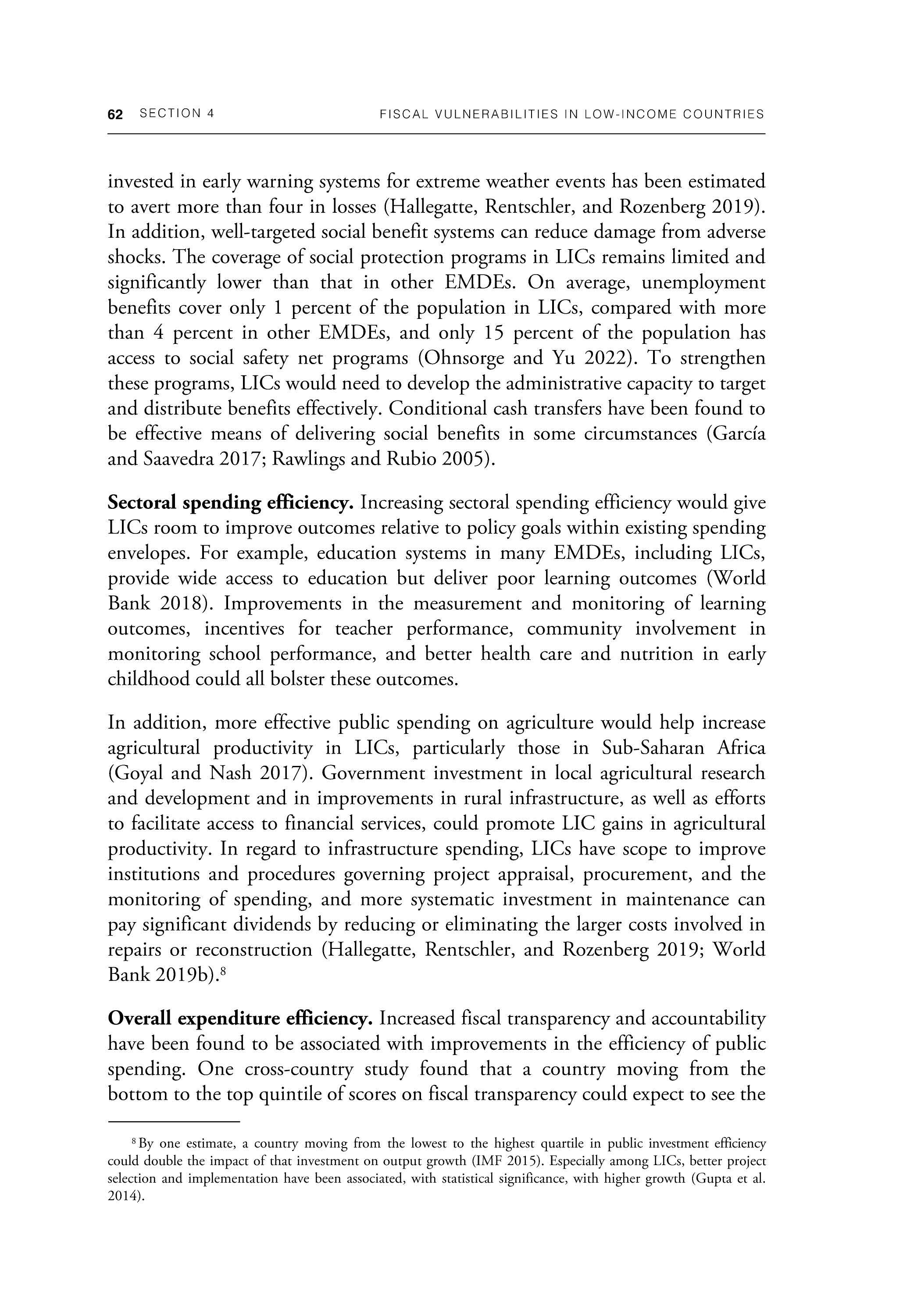
invested in early warning systems for extreme weather events has been estimated to avert more than four in losses (Hallegatte, Rentschler, and Rozenberg 2019). In addition, well-targeted social benefit systems can reduce damage from adverse shocks. The coverage of social protection programs in LICs remains limited and significantly lower than that in ocher EMDEs . On average, unemployment benefits cover only 1 percent of the population in LICs, compared with more than 4 percent in other EMDEs, and only 15 percent of the population has access to social safety net programs (Ohnsorge and Yu 2022). To s trengthen these programs, LICs would need to develop the administrative capacity to target and distribute benefits effectively. Conditional cash transfers have been found to be effective means of delivering social benefits in some circumstances (Garcia and Saavedra 2017; Rawlings and Rubio 2005).
Sectoral spending efficiency. Increasing sectoral spending efficiency would give LI Cs room to improve outcomes relative to policy goals within existing spending envelopes. For example, education systems in many EMDEs, including LICs, provide wide access to education but deliver poor learning outcomes (World Bank 2018) . Improvements in the measurement and monitoring of learning outcomes, incentives for teacher performance , community involvement in monitoring school performance , and better health care and nutrition in early childhood could all bolster these outcomes.
In addition, more effe ctive public spending on agriculture would help increase agricultural productivity in LICs, particularly those in Sub - Saharan Africa (Goyal and Nash 2017). Government investment in local agricultural research and development and in improvements in rural infrastructure, as well as efforts to facilitate access to financial services, could promote LIC gains in agricultural productivity In regard to infrastructure spending, LICs have scope to improve institutions and procedures governing project appraisal, procurement, and the monitoring of spending, and more systematic investment in maintenance can pay significant dividends by reducing or eliminating the larger costs involved in repairs or reconstruction (Hallegatte , Rentschler, and Rozenberg 2019; World Bank 2019b) . 8
Overall expenditure efficiency. Increased fiscal transparency and accountability have been found to be associated with improvements in the efficiency of public spending . One cross-country study found that a country moving from the bottom to the top quintile of scores on fiscal transparency could expect to see the
8 By on e es tim ate , a count ry mo vin g from th e lo wes t co the hi gh es t qu artil e in publi c in vestment effici en cy could doubl e th e impact of ch at in ves tm ent o n o utput growth (IMF 2015) Especi all y amon g L! Cs , be tter proj ec t sel ec tion and im plem ent ati o n h ave bee n asso ci ated , with stati stical signifi can ce , with hi gh er gro wth (G upta et al 201 4 )
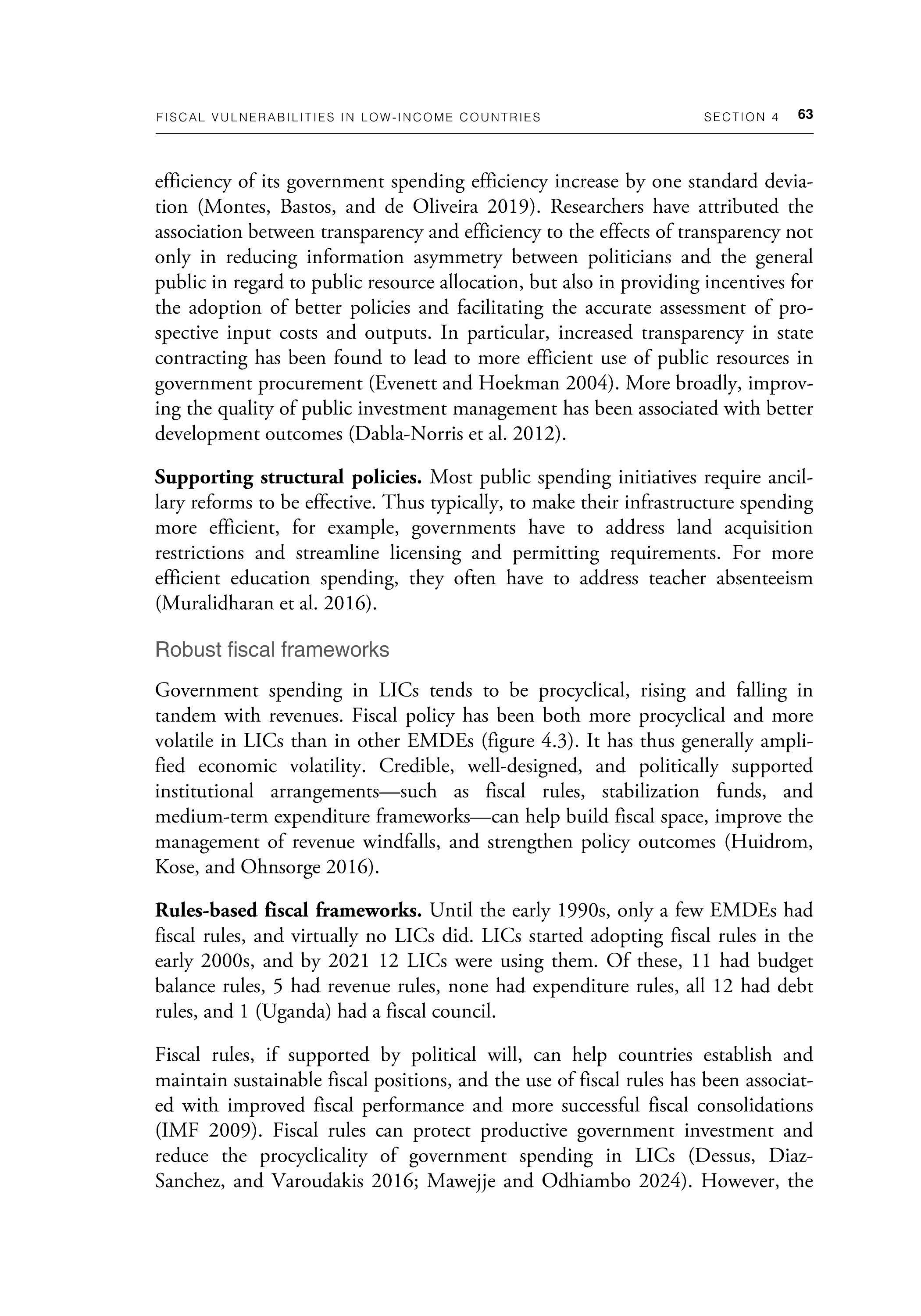
efficiency of its government spending efficiency increase by one standard deviation (Montes, Bastos, and de Oliveira 2019). Researchers have attributed the association between transparency and efficiency to the effects of transparency not only in reducing information asymmetry between politicians and the general public in regard to public resource allocation, but also in providing incentives for the adoption of better policies and facilitating the accurate assessment of prospective input coses and outputs. In particular, increased transparency in scare contracting has been found co lead co more efficient use of public resources in government procurement (Evenett and Hoekman 2004). More broadly, improving the quality of public investment management has been associated with better development outcomes (Dabla-Norris et al. 2012).
Supporting structural policies. Mose public spending initiatives require ancillary reforms to be effective. Thus typically , to make their infrastructure spending more efficient, for example, governments have to address land acquisition restrictions and streamline licensing and permitting requirements For more efficient education spending, they often have to address teacher absenteeism (Muralidharan et al. 2016) .
Robust fiscal frameworks
Government spending in LICs tends to be procydical, rising and falling in tandem with revenues . Fiscal policy has been both more procydical and more volatile in LICs than in other EMDEs (figure 4.3). It has thus generally amplified economic volatility. Credible, well-designed, and politically supported institutional arrangements-such as fiscal rules, stabilization funds, and medium-term expenditure frameworks-can help build fiscal space, improve the management of revenue windfalls, and strengthen policy outcomes (Huidrom , Kase , and Ohnsorge 2016) .
Rules-based fiscal frameworks. Until the early 1990s, only a few EMDEs had fiscal rules, and virtually no LICs did . LICs started adopting fiscal rules in the early 2000s, and by 2021 12 LICs were using them. Of these, 11 had budget balance rules, 5 had revenue rules, none had expenditure rules, all 12 had debt rules, and 1 (Uganda) had a fiscal council.
Fiscal rules, if supported by political will, can help countries establish and maintain sustainable fiscal positions , and the use of fiscal rules has been associated with improved fiscal performance and more successful fiscal consolidations (IMF 2009). Fiscal rules can protect productive government investment and reduce the procydicality of government spending in LICs (Dessus, DiazSanchez, and Varoudakis 2016 ; Mawejje and Odhiambo 2024) . However, the
FIGURE 4.3 Fiscal policy procyclicality and volatility, and fiscal frameworks
Spending growth in L/Cs generally moves in tandem with revenue growth. Fiscal policy is both more procyclical and more volatile in L/Cs than in other EMDEs. L/Cs rank significantly lower than other EMDEs on budget transparency. A growing number of L/Cs have implemented fiscal rules and sovereign wealth funds (SWFs), in part to stabilize spending growth
A Revenue and expenditure growth
C Fiscal policy volatility, 1990-2021
B Procyclicality of government spending, 19802020
Sources: Arroyo Marioli, Fatas, and Vasishtha (2023); Arroyo Marioli and Vegh (2023); Global SWF Data Plattorm (database); International Monetary Fund; World Bank
Note: EMDEs = emerging market and developing economies; LICs = low-income countries; Other EMDEs = emerging market and developing economies excluding LICs
A. Computed as the annual percentage growth of real revenue and expenditure (in constant 2015 dollars). Based on data for 25 LICs.
B. Bars show the median correlation between the cyclical components of real GDP and real government spending Orange whiskers show the interquartile range. The sample period is 1980-2020. The sample includes 25 LICs and 127 other EMDEs.
C. Bars show the medians of the standard deviation of the residuals obtained from regressing two dependent variables- real primary expenditure growth and real revenue growth-on real GDP growth. Orange whiskers show the interquartile range. The sample period is 1990-2021. The sample includes 22 LICs and 124 other EMDEs.
D. Bars show the share of LICs and other EMDEs with fiscal rules. Based on data for up to 71 EMDEs , including 12 LICs
E. Share of LICs and other EMDEs with at least one SWF Based on data for up to 84 EMDEs, including 6 LICs
F Bars show the unweighted period averages. Based on data for up to 120 EMDEs, including 21 LICs. The Open Budget Index ranges from Oto 100 and is based on various dimensions of the availability , timeliness , and quality of central government budget documents
E. SWFs in LICs and other EMDEs
D Fiscal rules in LICs and other EMDEs
F. Open Budget Index : LICs and other EMDEs
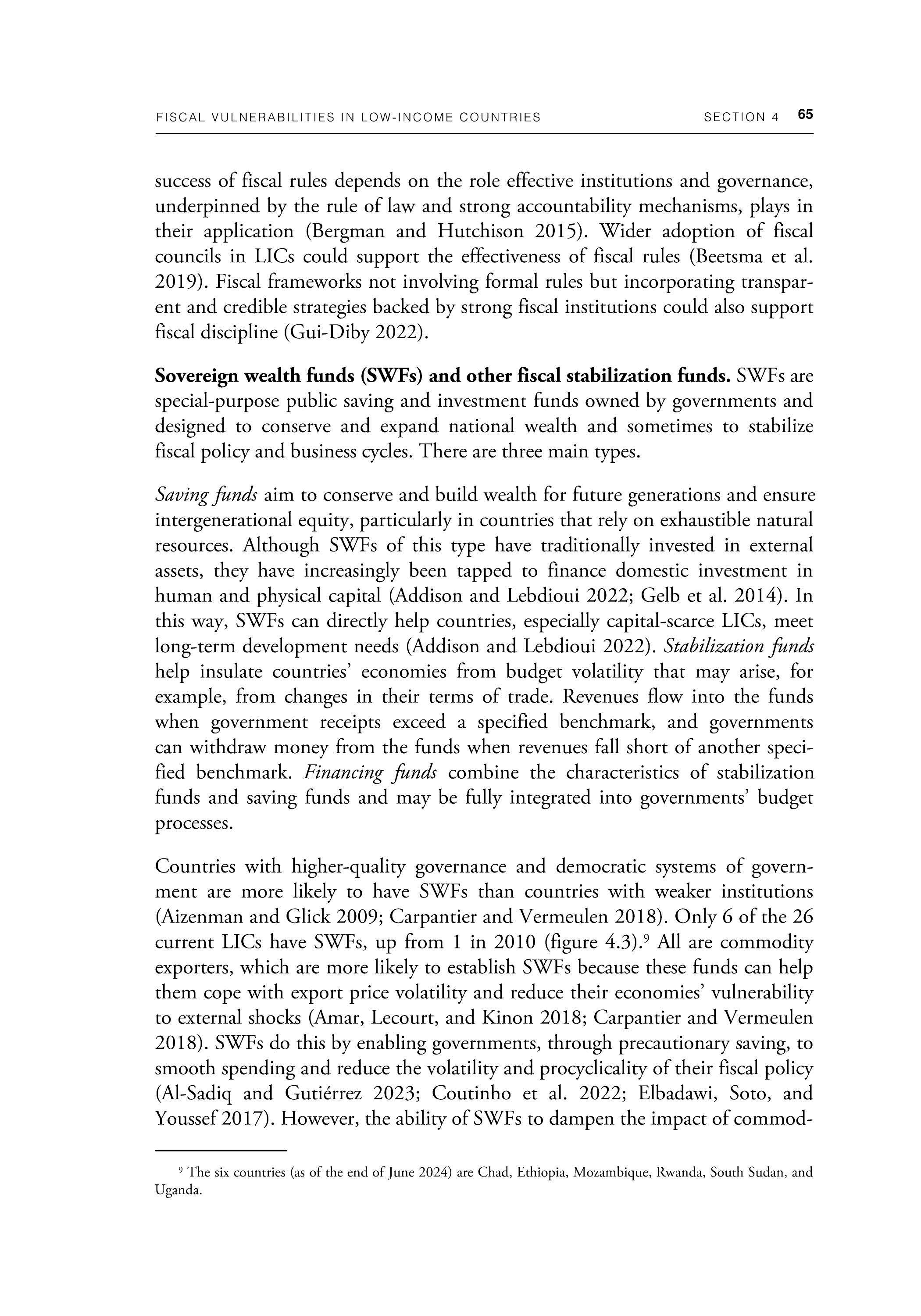
success of fiscal rules depends on the role effective institutions and governance, underpinned by the rule of law and strong accountability mechanisms, plays in their application (Bergman and Hutchison 2015). Wider adoption of fiscal councils in LICs could support the effectiveness of fiscal rules (Beetsma et al. 2019). Fiscal frameworks not involving formal rules but incorporating transparent and credible strategies backed by strong fiscal institutions could also support fiscal discipline (Gui-Diby 2022).
Sovereign wealth funds (SWFs) and other fiscal stabilization funds. SWFs are special-purpose public saving and investment funds owned by governments and designed to conserve and expand national wealth and sometimes to stabilize fiscal policy and business cycles. There are three main types.
Saving funds aim to conserve and build wealth for future generations and ensure intergenerational equity, particularly in countries that rely on exhaustible natural resources. Although SWFs of this type have traditionally invested in external assets, they have increasingly been tapped to finance domestic investment in human and physical capital (Addison and Lebdioui 2022; Gelb et al. 2014). In chis way, SWFs can directly help countries, especially capital-scarce LICs, meet long-term development needs (Addison and Lebdioui 2022). Stabilization funds help insulate countries' economies from budget volatility chat may arise, for example, from changes in their terms of trade. Revenues flow into the funds when government receipts exceed a specified benchmark, and governments can withdraw money from the funds when revenues fall short of another specified benchmark. Financing funds combine the characteristics of stabilization funds and saving funds and may be fully integrated into governments' budget processes.
Countries with higher-quality governance and democratic systems of government are more likely to have SWFs than countries with weaker institutions (Aizenman and Glick 2009; Carpantier and Vermeulen 2018). Only 6 of the 26 current LICs have SWFs , up from 1 in 2010 (figure 4.3). 9 All are commodity exporters, which are more likely to establish SWFs because these funds can help chem cope with export price volatility and reduce their economies ' vulnerability to external shocks (Amar, Lecourt, and Kinon 2018; Carpantier and Vermeulen 2018). SWFs do chis by enabling governments, through precautionary saving, to smooth spending and reduce the volatility and procyclicality of their fiscal policy (Al-Sadiq and Gutierrez 2023 ; Coutinho et al. 2022; Elbadawi, Soto, and Youssef 2017). However, the ability of SWFs to dampen the impact of commod-
9 Th e six co untri es (as of the e nd of Jun e 2024) are C had , Ethiopi a, Mozambiq u e, Rwand a, So uth Suda n , a nd U ga nd a.
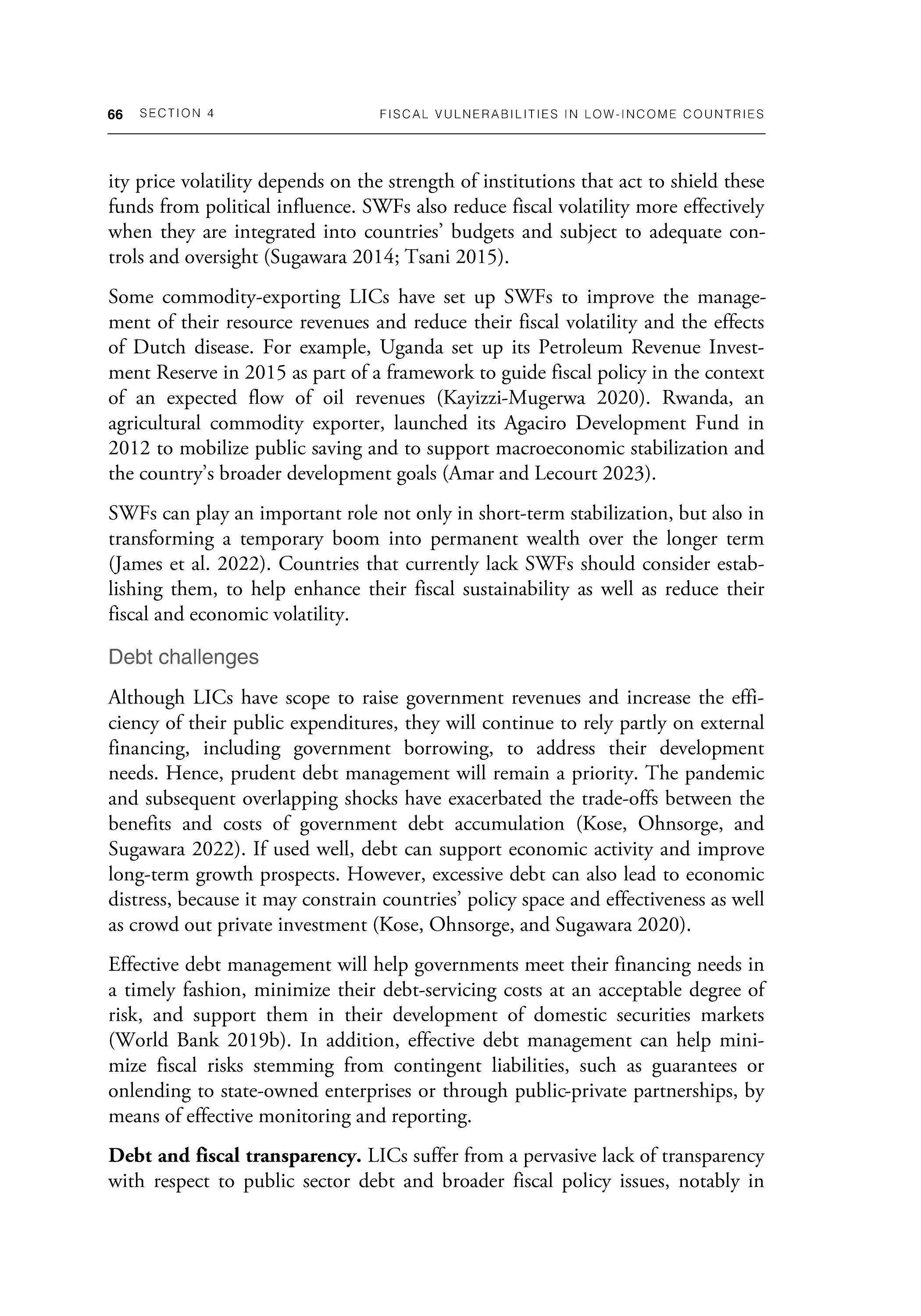
ity price volatility depends on the strength of institutions that act to shield these funds from political influence. SWFs also reduce fiscal volatility more effectively when they are integrated into countries' budgets and subject to adequate controls and oversight (Sugawara 2014; Tsani 2015).
Some commodity-exporting LICs have set up SWFs to improve the management of their resource revenues and reduce their fiscal volatility and the effects of Dutch disease. For example, Uganda set up its Petroleum Revenue Investment Reserve in 2015 as part of a framework to guide fiscal policy in the context of an expected flow of oil revenues (Kayizzi-Mugerwa 2020). Rwanda, an agricultural commodity exporter, launched its Agaciro Development Fund in 2012 to mobilize public saving and to support macroeconomic stabilization and the country's broader development goals (Amar and Lecourt 2023) .
SWFs can play an important role not only in short-term stabilization, but also in transforming a temporary boom into permanent wealth over the longer term Qames et al. 2022) . Countries that currently lack SWFs should consider establishing them, to help enhance their fiscal sustainability as well as reduce their fiscal and economic volatility.
Debt challenges
Although LICs have scope to raise government revenues and increase the efficiency of their public expenditures, they will continue to rely partly on external financing , including government borrowing, to address their development needs. Hence , prudent debt management will remain a priority. The pandemic and subsequent overlapping shocks have exacerbated the trade-offs between the benefits and costs of government debt accumulation (Kose, Ohnsorge, and Sugawara 2022). If used well, debt can support economic activity and improve long-term growth prospects . However, excessive debt can also lead to economic distress, because it may constrain countries' policy space and effectiveness as well as crowd out private investment (Kose, Ohnsorge, and Sugawara 2020).
Effective debt management will help governments meet their financing needs in a timely fashion , minimize their debt-servicing costs at an acceptable degree of risk, and support them in their development of domestic securities markets (World Bank 2019b) . In addition, effective debt management can help minimize fiscal risks stemming from contingent liabilities, such as guarantees or onlending to state-owned enterprises or through public-private partnerships, by means of effective monitoring and reporting.
Debt and fiscal transparency. LI Cs suffer from a pervasive lack of transparency with respect to public sector debt and broader fiscal policy issues, notably in
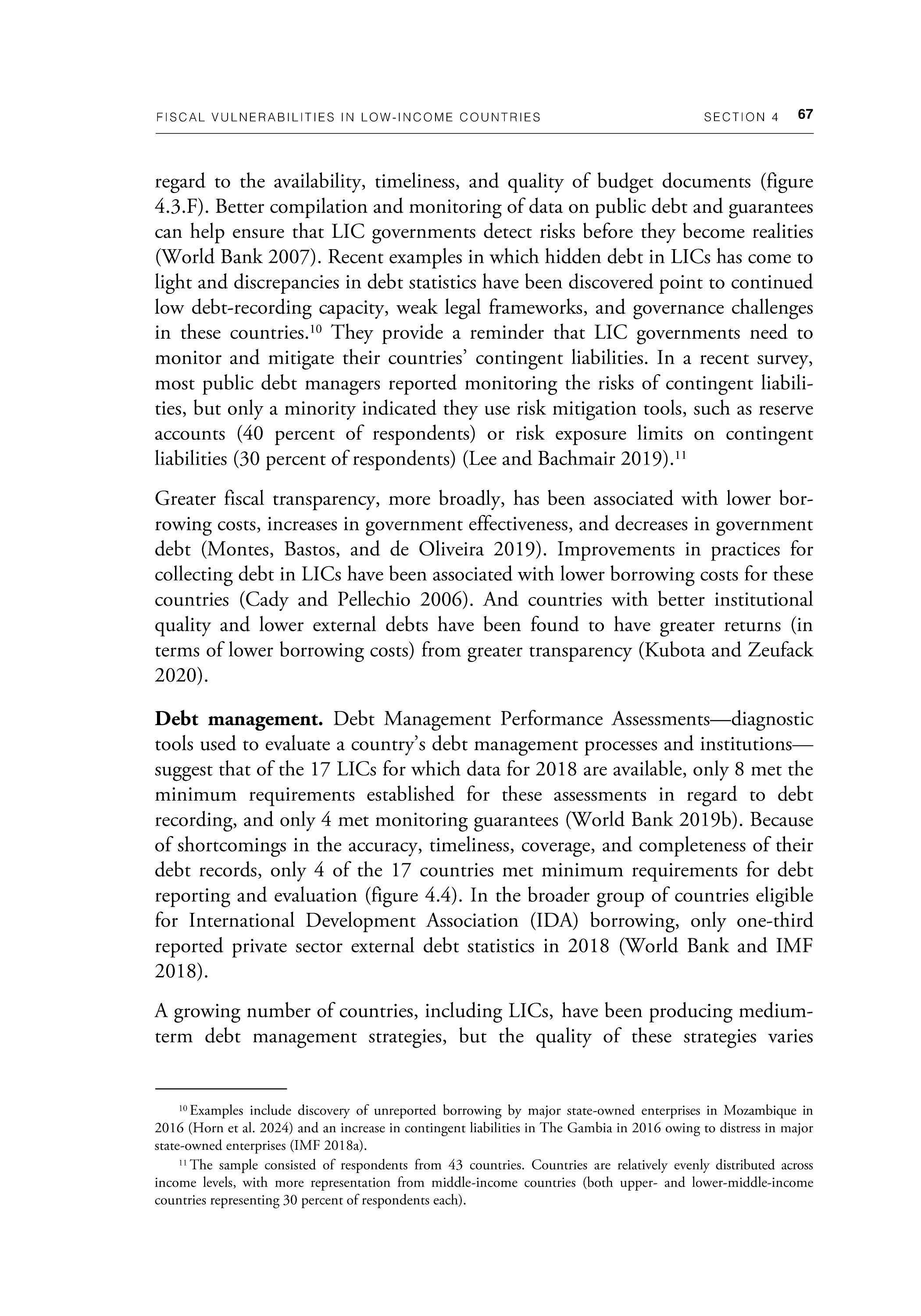
regard to the availability, timeliness, and quality of budget documents (figure 4.3 F). Better compilation and monitoring of data on public debt and guarantees can help ensure that LIC governments detect risks before they become realities (World Bank 2007). Recent examples in which hidden debt in LICs has come to light and discrepancies in debt statistics have been discovered point to continued low debt-recording capacity, weak legal frameworks, and governance challenges in these countries. 10 They provide a reminder that LIC governments need to monitor and mitigate their countries' contingent liabilities. In a recent survey, most public debt managers reported monitoring the risks of contingent liabilities, but only a minority indicated they use risk mitigation tools, such as reserve accounts (40 percent of respondents) or risk exposure limits on contingent liabilities (30 percent of respondents) (Lee and Bachmair 2019). 11
Greater fiscal transparency, more broadly, has been associated with lower borrowing costs, increases in government effectiveness, and decreases in government debt (Montes, Bastos, and de Oliveira 2019). Improvements in practices for collecting debt in LI Cs have been associated with lower borrowing costs for these countries (Cady and Pellechio 2006). And countries with better institutional quality and lower external debts have been found to have greater returns (in terms of lower borrowing costs) from greater transparency (Kubota and Zeufack 2020).
Debt management. Debt Management Performance Assessments-diagnostic tools used to evaluate a country's debt management processes and institutionssuggest that of the 17 LI Cs for which data for 2018 are available, only 8 met the minimum requirements established for these assessments in regard to debt recording, and only 4 met monitoring guarantees (World Bank 2019b). Because of shortcomings in the accuracy, timeliness, coverage, and completeness of their debt records, only 4 of the 17 countries met minimum requirements for debt reporting and evaluation (figure 4.4) . In the broader group of countries eligible for International Development Association (IDA) borrowing, only one-third reported private sector external debt statistics in 2018 (World Bank and IMF 2018).
A growing number of countries, including LICs, have been producing mediumterm debt management strategies, but the quality of these strategies varies
10 Examples include di scovery of unre ported borrowing by major state-ow ned enterp ri ses in Mozambique in 2016 (Horn et al. 2024) and an increas e in contingent liabiliti es in Th e Gambia in 2016 owing to di stress in major state-ow n ed enterprises (IMF 20 I Sa).
11 T he sample consisted of respondents from 43 countries. Countries are relatively evenly distributed across income levels, with more representation from middle-income countries (bo t h upper- an d lower-middle-income countries representing 30 percent of respondents each)
FIGURE 4.4 Debt management and institutional quality
Weaknesses in debt transparency, notably in the areas of monitoring and reporting, remain pervasive in L/Cs. Few of these countries meet the minimum requirements set by Debt Management Performance Assessments for selected categories
A Countries meeting DeMPA minimum requirements, select categories
Countries meeting DeMPA minimum requirements, other categories
Sources : Debt Management Performance Assessments (DeMPAs) ; World Bank (2019a).
Note: Sample covers 17 low-income countries. BCP = business continuity planning ; CBM = cash balance management; CFF = cash flow forecasting; DA= debt administration; DMS = debt management strategy ; DS = data security ; FP = fiscal policy; LGLD = loan guarantees on lending derivatives; LICs = low-income countries; MP= monetary policy; SC= staff capacity ; SD= segregation of duties. Sample covers 17 low-income countries.
significantly, and implementation of them often lags (World Bank 2019b) . Few of the countries align their strategies with their budget processes. Weak capacity, inadequate legal frameworks, lack of coordination between fiscal and monetary policy, inefficient management of cash and fiscal risks, and poor audit and risk control procedures often weaken countries' debt management
International support
The international community needs to take a more active role in helping LICs address the recent deterioration in their fiscal positions. Given their unique vulnerabilities-including weak institutional capacities, narrow tax bases, fragility and conflict, increasing exposure to climate-change-related natural disasters, and limited access to private finance-LICs will need continued access to wellcoordinated and tailored financial and technical assistance to strengthen their fiscal positions, bolster their institutional frameworks, and address their reform needs.
Concessional :6nancing. Restoring fiscal sustainability will require many LICs to reduce their reliance on commercial sources of financing. However, to make this possible, the global community will need to step up concessional financing, which has declined precipitously (as a percentage of LI Cs' incomes) since 2020 despite a substantial increase in IDA resources allocated to LICs (figure 4.5). Grants and concessional financing are imperative to ensure LICs have access to steady, predictable, and low-cost financial flows. Between 2020 and 2022, total
FIGURE 4.5 Global support
Grants to L/Cs have decreased, even though /DA financing has increased. Capital flows have also been falling in L/Cs, with sharper declines since 2020. To achieve resilient and green growth paths and meet the costs of adaptation to climate change in L/Cs will require substantial amounts of investment All these factors heighten the urgency for increased global support for these countries.
A Grants received by LICs
C . Investment needs to enable countries to achieve a resilient and low carbon growth path
Sources: IDS (database); Rozenberg and Fay (2019) ; UNEP (2023) ; WDI (database) ; World Bank.
Note : FOi = foreign direct investment; GDP= gross domestic product ; GNI = gross national income; IDA= International Development Association ; LICs = low-income countries; ODA= official development assistance ; RHS = right-hand scale.
A Grants are defined as legally binding commitments allocating specific funds for disbursement without any requirement for repayment. Data are on a disbursement basis and exclude debt forgiveness grants. "IDA grants" are net disbursements of grants from IDA.
B. Net ODA consists of disbursements with a grant element of at least 25 percent (calculated at a rate of discount of 1O percent)
C. Estimates of the annual investment needs to enable countries to build resilience to climate change and put them on track to reduce em issions by 70 percent by 2050. Depending on data a v ailability, estimates include in v estment needs in the areas of energy, industry , landscape , transport , urban adaptations , and water.
D. Undiscounted annual costs of adaptation for the period up to 2030. Estimates are based on modeled estimates for agriculture ; coastal zones ; early warning and social protection ; fisheries , aquaculture , and marine ecosystems ; health ; infrastructure; river floods ; and terrestrial biodiversity and ecosystem services. Qualitative assessment for cooling demand and labor productivity. Business and industry, capacity building , and socially contingent effects are a lso considered
grants to LI Cs declined by 5 percentage points of GDP to 7 percent, the lowest level since 2010.
IDA grants have increased significantly over the past decade and more than doubled between 2015 and 2022 to 1.2 percent of countries' gross national income. The IDA offers grants (that is, financing requiring no repayment) to the poorest countries and to countries in or at high risk of debt distress, thereby providing them with implicit debt relief before the fact (World Bank 2023,
B. Net financial flows in LICs
D. Climate change adaption costs
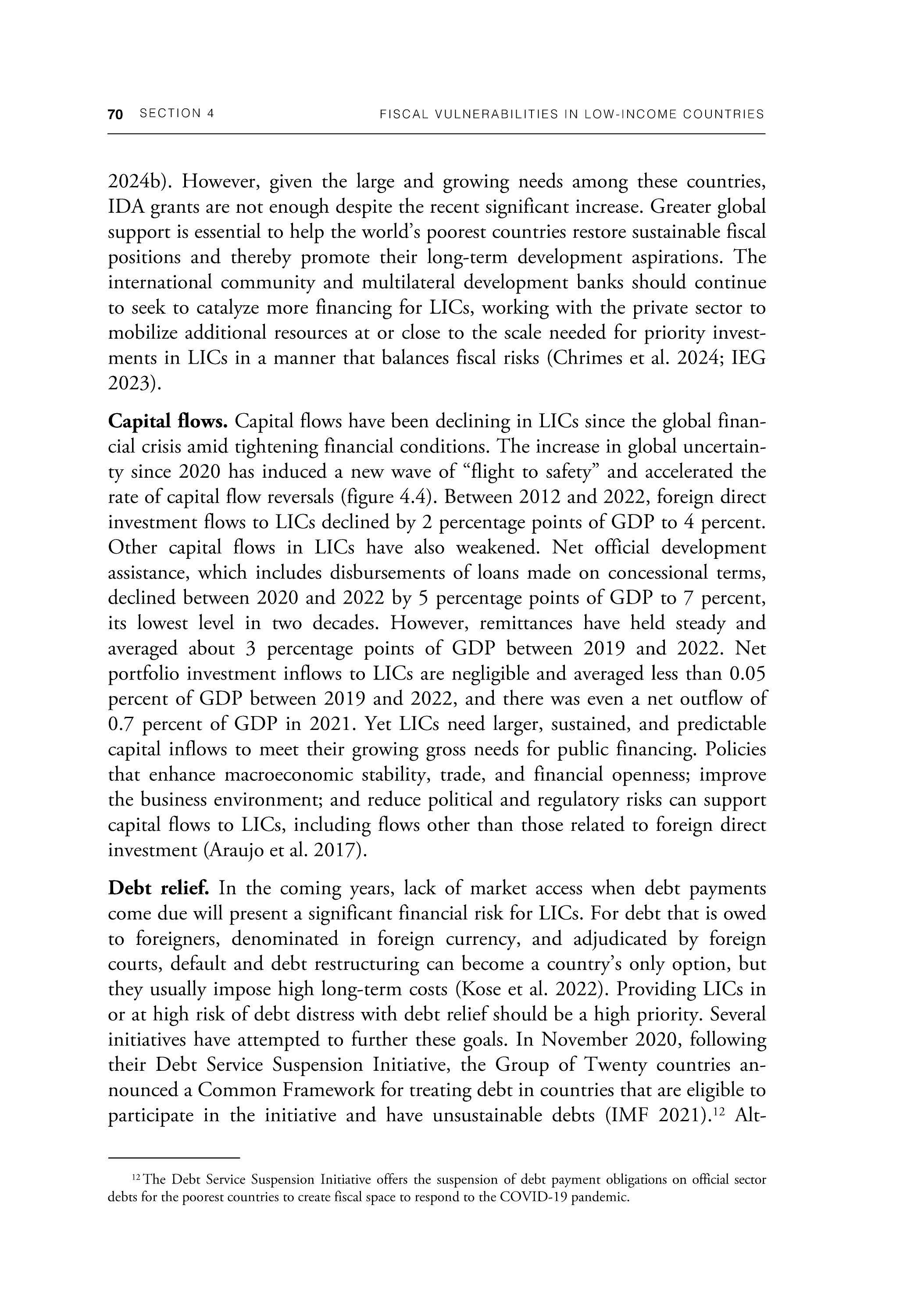
20246). However, given the large and growing needs among these countries, IDA grants are not enough despite the recent significant increase. Greater global support is essential to help the world ' s poorest countries restore sustainable fiscal positions and thereby promote their long-term development aspirations. The international community and multilateral development banks should continue to seek to catalyze more financing for LICs, working with the private sector to mobilize additional resources at or close to the scale needed for priority investments in LICs in a manner that balances fiscal risks (Chrimes et al. 2024; IEG 2023).
Capital flows. Capital flows have been declining in LICs since the global financial crisis amid tightening financial conditions. The increase in global uncertainty since 2020 has induced a new wave of "flight to safety" and accelerated the rate of capital flow reversals (figure 4.4). Between 2012 and 2022, foreign direct investment flows to LI Cs declined by 2 percentage points of GDP to 4 percent Other capital flows in LICs have also weakened. Net official development assistance, which includes disbursements of loans made on concessional terms, declined between 2020 and 2022 by 5 percentage points of GDP to 7 percent, its lowest level in two decades. However, remittances have held steady and averaged about 3 percentage points of GDP between 2019 and 2022. Net portfolio investment inflows to LICs are negligible and averaged less than 0 05 percent of GDP between 2019 and 2022, and there was even a net outflow of 0 7 percent of GDP in 2021. Yet LICs need larger , sustained , and predictable capital inflows to meet their growing gross needs for public financing. Policies that enhance macroeconomic stability, trade , and financial openness; improve the business environment; and reduce political and regulatory risks can support capital flows to LICs, including flows other than those related to foreign direct investment (Araujo et al. 2017).
Debt relief. In the coming years, lack of market access when debt payments come due will present a significant financial risk for LICs. For debt that is owed to foreigners, denominated in foreign currency, and adjudicated by foreign courts, default and debt restructuring can become a country's only option, but they usually impose high long-term costs (Kase et al. 2022). Providing LICs in or at high risk of debt distress with debt relief should be a high priority. Several initiatives have attempted to further these goals. In November 2020, following their Debt Service Suspension Initiative, the Group of Twenty countri es announced a Common Framework for treating debt in countries that are eligible to participate in the initiative and have unsustainable debts (IMF 2021). 12 Alt-
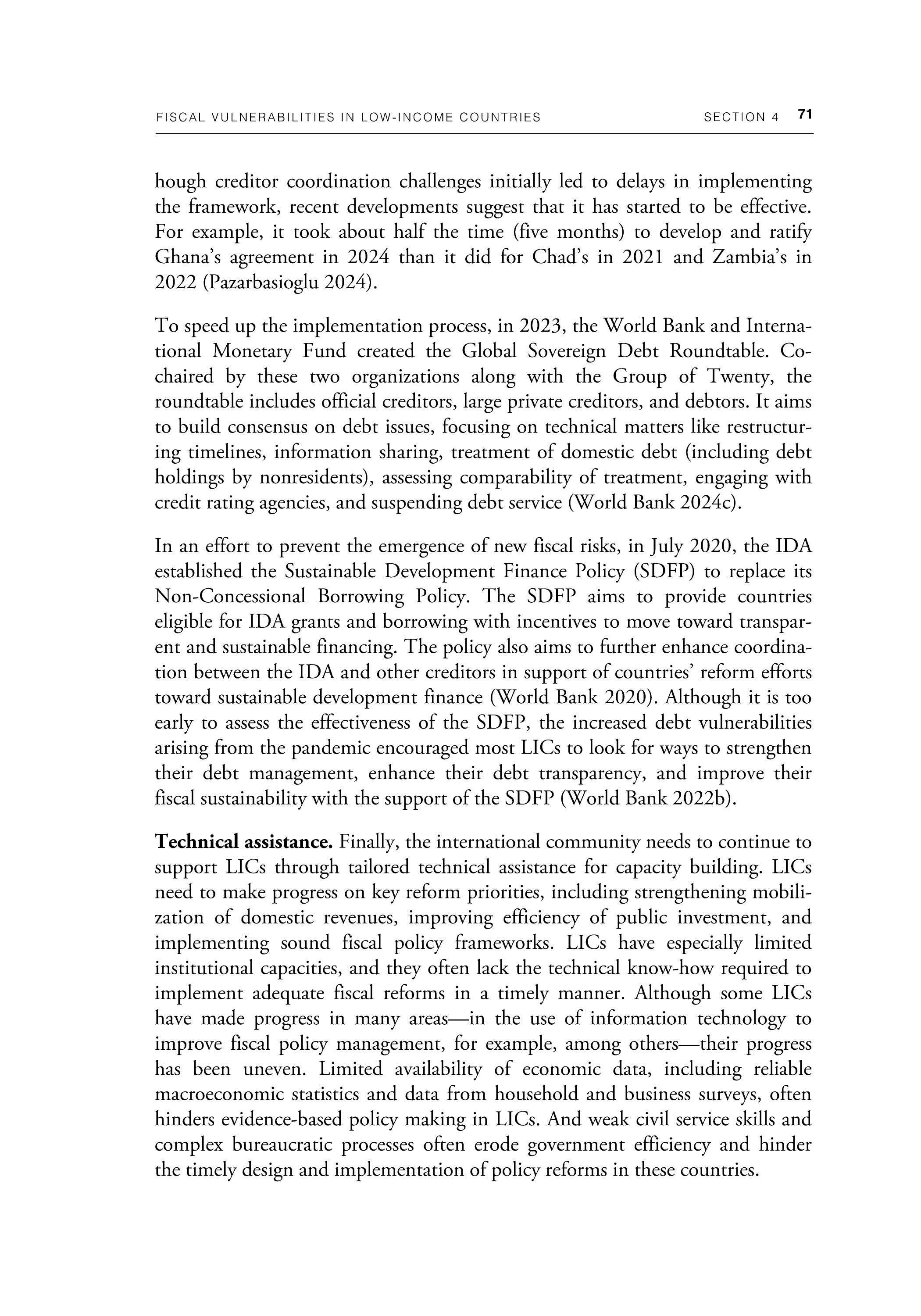
hough creditor coordination challenges initially led to delays in implementing the framework , recent developments suggest that it has started to be effective. For example, it took about half the time (five months) to develop and ratify Ghana's agreement in 2024 than it did for Chad's in 2021 and Zambia's in 2022 (Pazarbasioglu 2024) .
To speed up the implementation process, in 2023 , the World Bank and International Monetary Fund created the Global Sovereign Debt Roundtable . Cochaired by these two organizations along with the Group of Twenty, the roundtable includes official creditors, large private creditors, and debtors. It aims to build consensus on debt issues, focusing on technical matters like restructuring timelines , information sharing, treatment of domestic debt (including debt holdings by nonresidents), assessing comparability of treatment, engaging with credit rating agencies, and suspending debt service (World Bank 2024c)
In an effort to prevent the emergence of new fiscal risks, in July 2020, the IDA established the Sustainable Development Finance Policy (SDFP) to replace its Non-Concessional Borrowing Policy The SDFP aims to provide countries eligible for IDA grants and borrowing with incentives to move toward transparent and sustainable financing. The policy also aims to further enhance coordination between the IDA and other creditors in support of countries' reform efforts toward sustainable development finance (World Bank 2020). Although it is too early to assess the e ffectiveness of the SDFP, the increased debt vulnerabilities arising from the pandemic encouraged most LICs to look for ways to strengthen their debt management, enhance their debt transparency, and improve their fiscal sustainability with the support of the SDFP (World Bank 2022b).
Technical assistance. Finally, the international community needs to continue to support LICs through tailored technical assistance for capacity building. LICs need to make progress on key reform priorities , including strengthening mobilization of domestic revenues, improving efficiency of public investment, and implementing sound fiscal policy frameworks. LICs have especially limited institutional capacities , and they often lack the technical know- how required to implement adequate fiscal reforms in a timely manner. Although some LICs have made progress in many areas-in the use of information technology to improve fiscal policy management, for example, among others-their progress has been uneven. Limited availability of economic data, including reliable macroeconomic statistics and data from household and business surveys, often hinders evidence-based policy making in LICs . And weak civil service skills and complex bureaucratic processes often erode government efficiency and hinder the timely design and implementation of policy reforms in these countries.
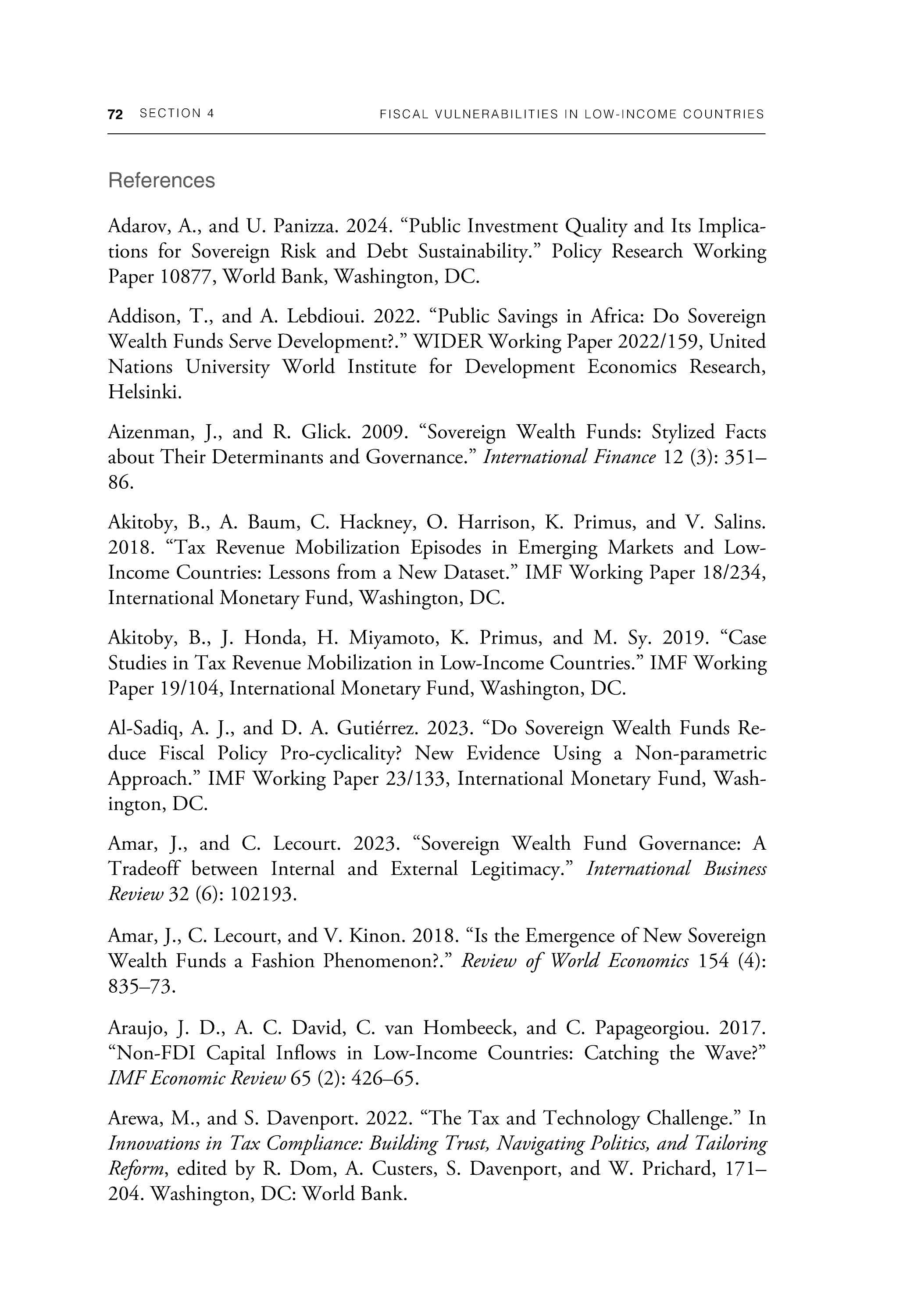
References
Adarov, A., and U . Panizza. 2024 . "Public Investment Quality and Its Implications for Sovereign Risk and Debt Sustainability " Policy Research Working Paper 10877, World Bank, Washington, DC.
Addison, T., and A. Lebdioui. 2022. "Public Savings in Africa: Do Sovereign Wealth Funds Serve Development?." WIDER Working Paper 2022/159 , United Nations University World Institute for Development Economics Research, Helsinki.
Aizenman, J , and R. Glick. 2009. "Sovereign Wealth Funds: Stylized Facts about Their Determinants and Governance." International Finance 12 (3): 35186.
Akitoby, B. , A. Baum , C. Hackney, 0. Harrison , K. Primus, and V. Salins. 2018 "Tax Revenue Mobilization Episodes in Emerging Markets and LowIncome Countries: Lessons from a New Dataset " IMF Working Paper 18/234, International Monetary Fund, Washington, DC.
Akitoby, B., J. Honda, H. Miyamoto, K. Primus, and M. Sy. 2019. "Case Studies in Tax Revenue Mobilization in Low-Income Countries." IMF Working Paper 19/104, International Monetary Fund, Washington, DC.
Al-Sadiq, A. J., and D. A. Gutierrez. 2023. "Do Sovereign Wealth Funds Reduce Fiscal Policy Pro-cyclicality? New Evidence Using a Non-parametric Approach." IMF Working Paper 23/133, International Mon e tary Fund, Washington, DC.
Amar, J., and C. Lecourt. 2023. "Sovereign Wealth Fund Governance: A Tradeoff between Internal and External Legitimacy." International Business Review 32 (6) : 102193.
Amar, J , C. Lecourt, and V . Kinon . 2018 . "Is the Emergence of New Sovereign Wealth Funds a Fashion Phenomenon?." Review of World Economics 154 (4): 835-73.
Araujo, J. D . , A . C. David, C. van Hombeeck, and C. Papageorgiou . 2017. "Non-FDI Capital Inflows in Low-Income Countries: Catching the Wave?" IMF Economic Review 65 (2) : 426-65.
Arewa, M ., and S. Davenport . 2022 . "The Tax and Technology Challenge ." In Innovations in Tax Compliance: Building Trust, Navigating Politics, and Tailoring Reform, edited by R. Dom, A. Custers, S. Davenport, and W. Prichard, 171204. Washington, DC: World Bank.
Arroyo Marioli, F ., A. Fatas, and G. Vasishtha . 2023. "Fiscal Policy Volatility and Growth in Emerging Markets and Developing Economies." Policy Research Working Paper 10409, World Bank, Washington, DC.
Arroyo Marioli, F., and C. A. Vegh. 2023. "Fiscal Procyclicality in Commodity Exporting Countries: How Much Does It Pour and Why?" Policy Research Working Paper 10428, World Bank, Washington, DC.
Beetsma, R., X. Debrun, X. Fang, Y. Kim, V. Lled6, S. Mbaye, and X. Zhang. 2019. "Independent Fiscal Councils: Recent Trends and Performance." European journal ofPolitical Economy 57 (March) : 53-69.
Bergman, U . M., and M . Hutchison. 2015. "Economic Stabilization in the Postcrisis World: Are Fiscal Rules the Answer?." Journal of International Money and Finance 52: 82-101.
Cady, J., and A. Pellechio. 2006. "Sovereign Borrowing Cost and the IMF's Data Standards Initiatives." IMF Working Paper 06/78, International Monetary Fund, Washington, DC.
Carpantier , J F., and W. N. Vermeulen. 2018 "Emergence of Sovereign Wealth Funds." Journal of Commodity Markets 11 (September): 1-21.
Chrimes, T ., B. Gootjes, M . A. Kose, and C. Wheeler. 2024. The Great ReversaLProspects, Risks, and Policies in International Development Association (IDA) Countries. Washington, DC : World Bank.
Clements, B., S Gupta, and J. T. Jalles. 2022. "Fiscal Policy for Inclusive Growth in Asia." Working Paper 611, Center for Global Development, Washington, DC.
Coady, D., V. Flamini , and L. Sears. 2015. "The Unequal Benefits of Fuel Subsidies Revisited : Evidence for Developing Countries . " IMF Working Paper 15/250 , International Monetary Fund , Washington, DC.
Coutinho, L., D. Georgiou, M. Heracleous, A. Michaelides, and S. Tsani. 2022. "Limiting Fiscal Procyclicality: Evidence from Resource-Dependent Countries." Economic Modelling 106 (January): 105700 .
Dabla-Norris, E., J. Brumby, A. Kyobe , Z Mills, and C. Papageorgiou. 2012. "Investing in Public Investment: An Index of Public Investment Efficiency " fournal ofEconomic Growth 17: 235-66.
Dessus, S., J . L. Diaz-Sanchez, and A. Varoudakis . 2016. "Fiscal Rules and the Pro-cyclicality of Public Investment in the West African Economic and Monetary Union." f ournal ofInternational Development 28 (6): 887-901.
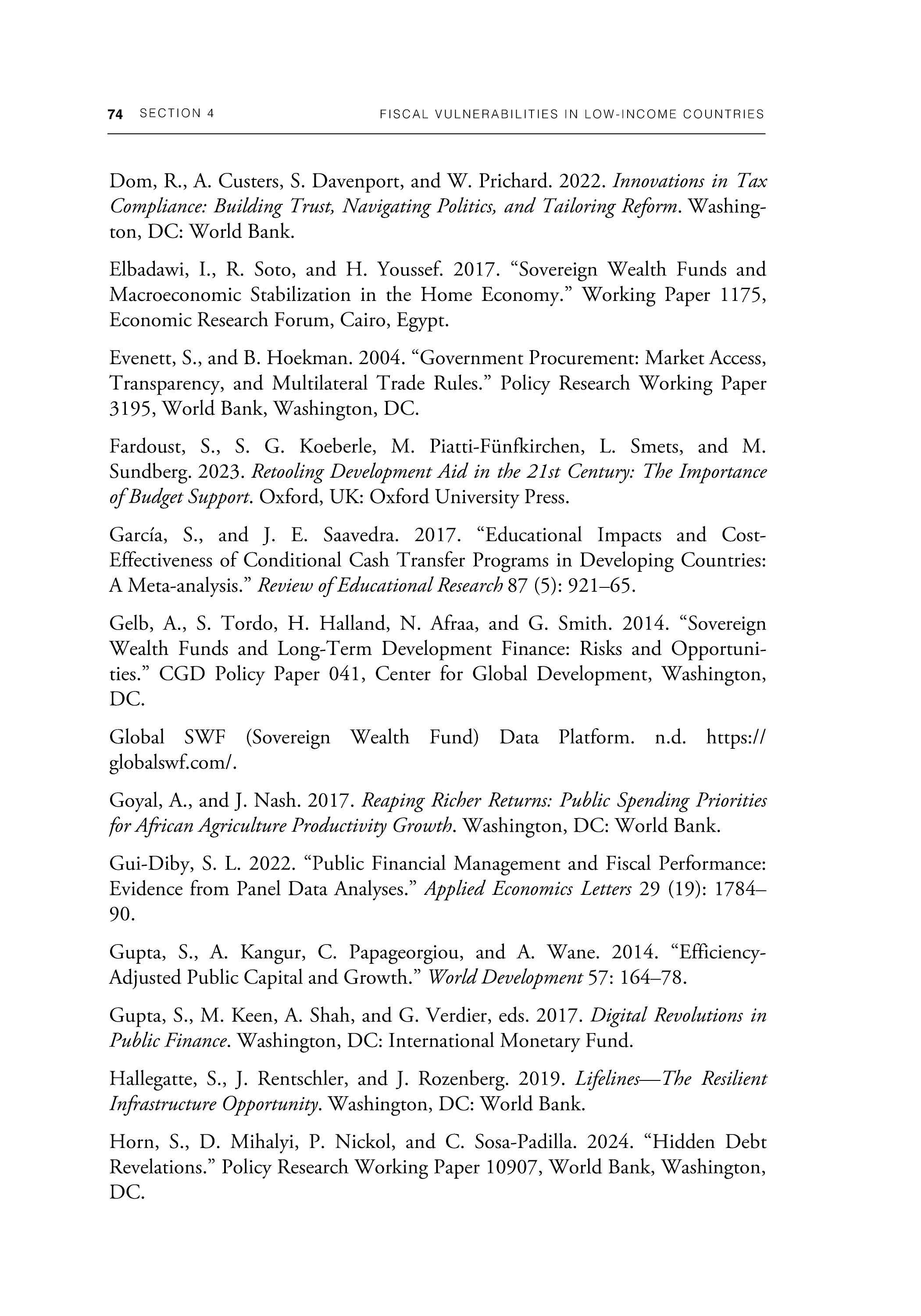
Dom, R . , A. Custers, S. Davenport, and W. Prichard. 2022. Innovations in Tax Compliance: Building Trust, Navigating Politics, and Tailoring Reform. Washington, DC : World Bank.
Elbadawi , I., R . Soto, and H. Youssef. 2017. "Sovereign Wealth Funds and Macroeconomic Stabilization in the Home Economy." Working Paper 1175, Economic Research Forum, Cairo, Egypt
Evenett, S., and B. Hoekman. 2004. "Government Procurement : Market Access, Transparency, and Multilateral Trade Rules." Policy Research Working Paper 3195, World Bank, Washington, DC.
Fardoust, S., S. G. Koeberle, M. Piatti-Fiinfkirchen, L. Smets, and M. Sundberg . 2023. Retooling Development Aid in the 21st Century: The Importance of Budget Support. Oxford, UK: Oxford University Press.
Garcia, S., and J. E. Saavedra. 2017. "Educational Impacts and CostEffectiveness of Conditional Cash Transfer Programs in Developing Countries : A Meta-analysis." Review ofEducational Research 87 (5): 921-65
Gelb, A., S. Tordo, H . Halland, N. Afraa, and G. Smith. 2014. "Sovereign Wealth Funds and Long-Term Development Finance: Risks and Opportunities." CGD Policy Paper 041, Center for Global Development, Washington, DC.
Global SWF (Sovereign Wealth Fund) Data Platform. n.d. https:// globalswf.corn/.
Goyal, A., and J. Nash. 2017. Reaping Richer Returns: Public Spending Priorities for African Agriculture Productivity Growth. Washington, DC: World Bank.
Gui-Diby, S. L. 2022. "Public Financial Management and Fiscal Performance: Evidence from Panel Data Analyses." Applied Economics Letters 29 (19): 178490.
Gupta, S., A. Kangur, C. Papageorgiou, and A. Wane . 2014. "EfficiencyAdjusted Public Capital and Growth." World Development 57 : 164-78.
Gupta, S. , M . Keen, A. Shah, and G. Verdier , eds . 2017. Digital Revolutions in Public Finance. Washington, DC: International Monetary Fund.
Hallegatte, S , J. Rentschler, and J. Rozenberg 2019. Lifelines-The Resilient Infrastructure Opportunity Washington, DC: World Bank.
Horn, S., D. Mihalyi , P . Nickol, and C. Sosa-Padilla . 2024 . "Hidden Debt Revelations." Policy Research Working Paper 10907, World Bank, Washington, DC.
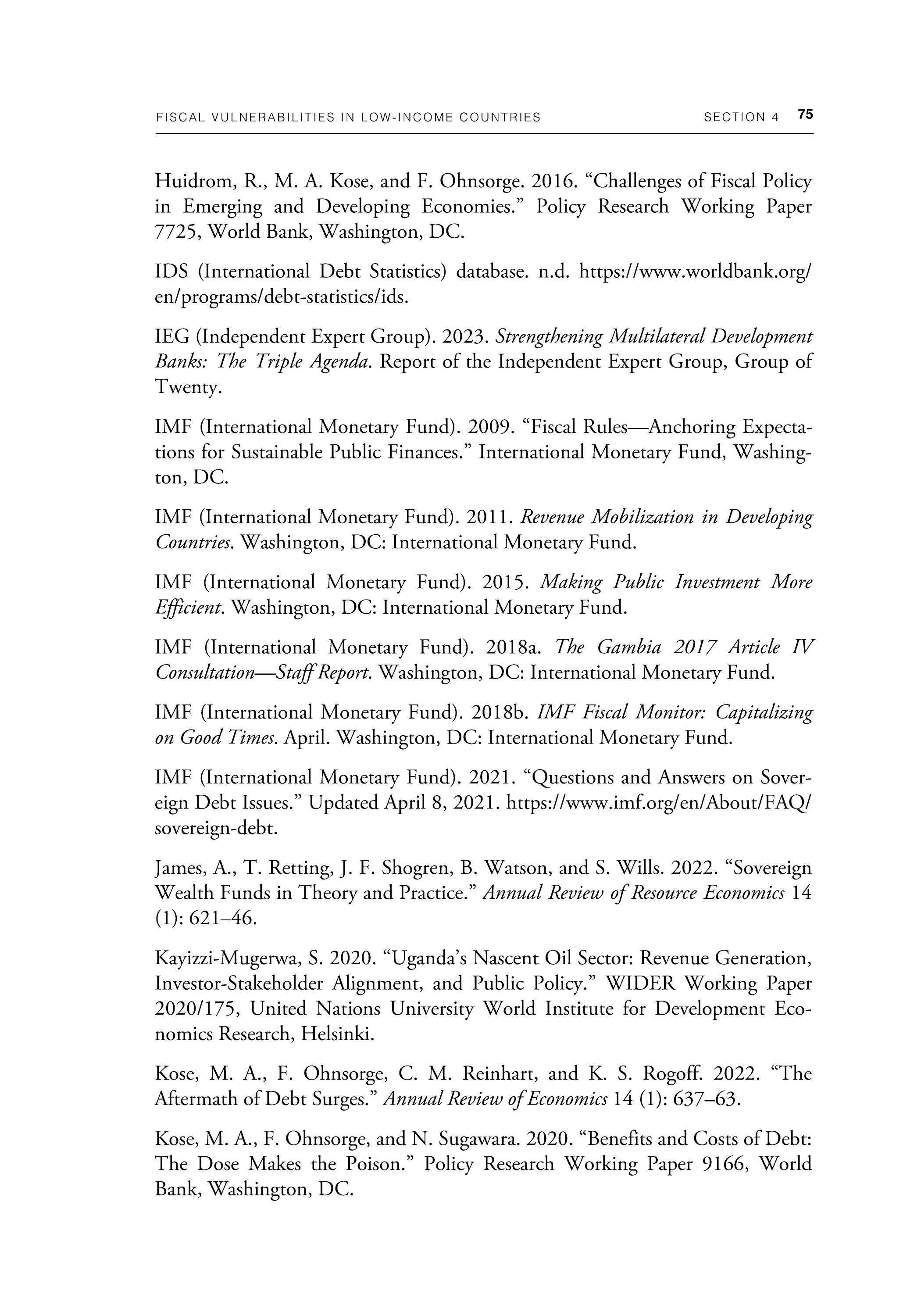
Huidrom, R., M.A. Kose, and F . Ohnsorge. 2016. "Challenges of Fiscal Policy in Emerging and Developing Economies." Policy Research Working Paper 7725, World Bank, Washington, DC.
IDS (International Debt Statistics) database . n.d. https:/ /www.worldbank.org/ en/ programs/ debt-statistics/ids .
IEG (Independent Expert Group). 2023 . Strengthening Multilateral Development Banks: The Triple Agenda Report of the Independent Expert Group, Group of Twenty.
IMF (International Monetary Fund). 2009. "Fiscal Rules-Anchoring Expectations for Sustainable Public Finances." International Monetary Fund, Washington, DC.
IMF (International Monetary Fund). 2011. Revenue Mobilization in Developing Countries. Washington, DC : International Monetary Fund
IMF (International Monetary Fund) . 2015. Making Public Investment More Efficient Washington, DC: International Monetary Fund.
IMF (International Monetary Fund). 2018a. The Gambia 2017 Article IV Consultation-Sta.If Report. Washington, DC: International Monetary Fund.
IMF (International Monetary Fund). 2018b. IMF Fiscal Monitor: Capitalizing on Good Times. April. Washington, DC: International Monetary Fund.
IMF (International Monetary Fund) . 2021. "Questions and Answers on Sovereign Debt Issues." Updated April 8, 2021. https:/ /www.imf.org/ en/About/FAQ/ sovereign-debt.
James, A ., T . Retting , J . F. Shogren , B. Watson, and S. Wills. 2022. "Sovereign Wealth Funds in Theory and Practice . " Annual Review of Resource Economics 14 (1): 621-46.
Kayizzi-Mugerwa , S 2020 "Uganda' s Nascent Oil Sector: Revenue Generation , Investor-Stakeholder Alignment, and Public Policy." WIDER Working Paper 2020/175, United Nations University World Institute for Development Economics Research, Helsinki.
Kose, M . A. , F. Ohnsorge, C. M. Reinhart, and K. S. Rogoff. 2022. "The Aftermath of Debt Surges." Annual Review ofEconomics 14 (1) : 637-63.
Kose, M.A., F. Ohnsorge, and N. Sugawara. 2020. "Benefits and Costs of Debt: The Dose Makes the Poison." Policy Research Working Paper 9166, World Bank, Washington, DC.
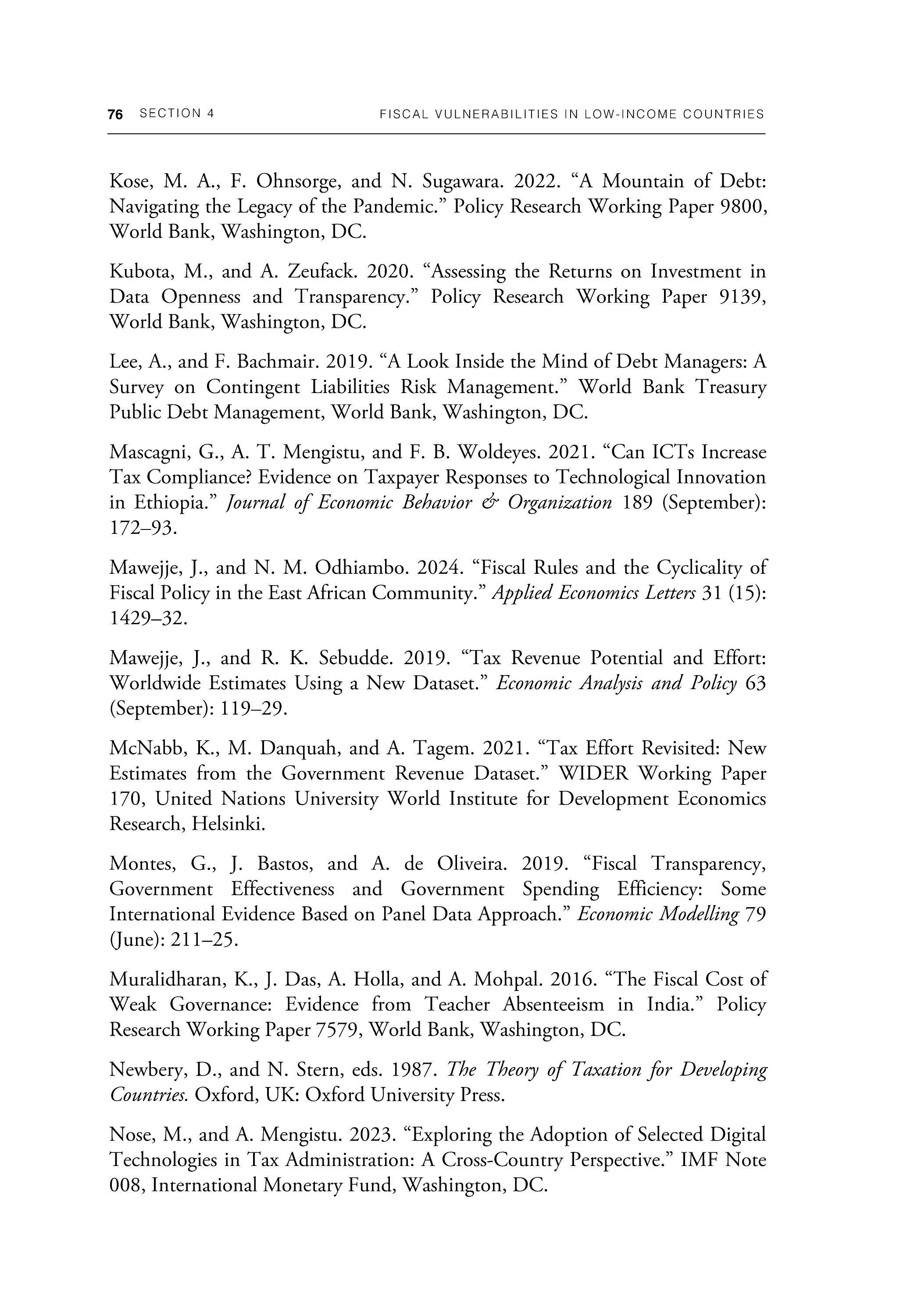
Kose, M. A., F. Ohnsorge, and N. Sugawara. 2022. "A Mountain of Debt: Navigating the Legacy of the Pandemic." Policy Research Working Paper 9800, World Bank, Washington, DC.
Kubota, M., and A. Zeufack. 2020. "Assessing the Returns on Investment in Data Openness and Transparency." Policy Research Working Paper 9139, World Bank, Washington, DC.
Lee, A ., and F. Bachmair. 2019 . "A Look Inside the Mind of Debt Managers : A Survey on Contingent Liabilities Risk Management " World Bank Treasury Public Debt Management, World Bank, Washington, DC.
Mascagni, G., A. T. Mengistu, and F. B. Woldeyes. 2021. "Can ICTs Increase Tax Compliance? Evidence on Taxpayer Responses to Technological Innovation in Ethiopia." Journal of Economic Behavior & Organization 189 (September) : 172-93.
Mawejje, J., and N. M. Odhiambo. 2024. "Fiscal Rules and the Cyclicality of Fiscal Policy in the East African Community." Applied Economics Letters 31 (15): 1429-32 .
Mawejje, J., and R. K. Sebudde. 2019. "Tax Revenue Potential and Effort: Worldwide Estimates Using a New Dataset." Economic Analysis and Policy 63 (September): 119-29.
McNabb, K. , M . Danquah, and A. Tagem . 2021. "Tax Effort Revisited: New Estimates from the Government Revenue Dataset." WIDER Working Paper 170, United Nations University World Institute for Development Economics Research , Helsinki.
Montes, G., J. Bastos, and A. de Oliveira. 2019. "Fiscal Transparency, Government Effectiveness and Government Spending Efficiency: Some International Evidence Based on Panel Data Approach." Economic Modelling 79 Qune) : 211-25.
Muralidharan, K., J. Das, A. Holla, and A. Mohpal. 2016. "The Fiscal Cost of Weak Governance: Evidence from Teacher Absenteeism in India." Policy Research Working Paper 7579, World Bank, Washington, DC.
Newbery , D , and N. Stern, eds. 1987. The Theory of Taxation for Developing Countries. Oxford, UK: Oxford University Press
Nose, M . , and A. Mengistu. 2023. "Exploring the Adoption of Selected Digital Technologies in Tax Administration : A Cross-Country Perspective ." IMF Note 008, International Monetary Fund, Washington, DC.
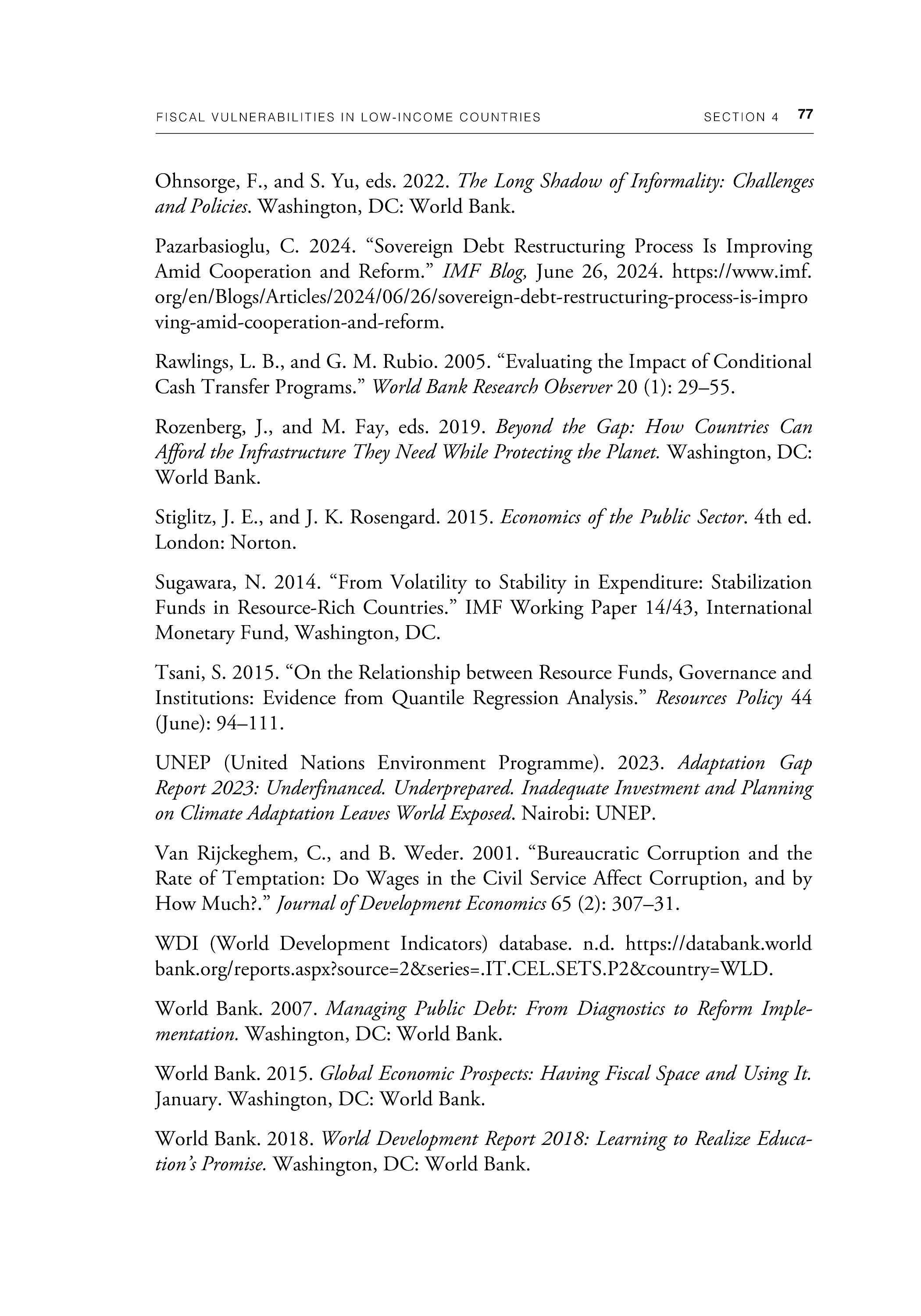
Ohnsorge , F., and S Yu, eds 2022 The Long Shadow of Informality: Challenges and Policies Washington, DC: World Bank.
Pazarbasioglu, C. 2024. "Sovereign Debt Restructuring Process Is Improving Amid Cooperation and Reform." IMF Blog, June 26, 2024. https ://www.imf. org/en/Blogs/Articles/2024/06/26/sovereign-debt-restructuring-process-is-impro ving-amid-cooperation-and-reform
Rawlings, L. B., and G. M. Rubio. 2005. "Evaluating the Impact of Conditional Cash Transfer Programs." Wo rld Bank Research Observer 20 (1): 29-55.
Rozenberg, J., and M . Fay, eds. 2019. Beyond the Gap: How Countries Can Afford the Infrastructure They Need While Protecting the Planet. Washington, DC: World Bank.
Stiglitz, J E , and J K. Rosengard 2015. Economics of the Public Sector 4th ed. London: Norton.
Sugawara, N. 2014. "From Volatility to Stability in Expenditure: Stabilization Funds in Resource-Rich Countries . " IMF Working Paper 14/43, International Monetary Fund, Washington, DC.
Tsani, S. 2015 "On the Relationship between Resource Funds, Governance and Institutions : Evidence from Quantile Regression Analysis . " Resources Policy 44 Qune): 94-111.
UNEP (United Nations Environment Programme). 2023 . Adaptation Gap Report 2023 : Underfinanced. Underprepared. Inadequate Investment and Planning on Climate Adaptation Leaves World Exposed. Nairobi: UNEP.
Van Rijckeghem , C., and B. Weder. 2001. "Bureaucratic Corruption and the Rate of Temptation: Do Wages in the Civil Service Affect Corruption, and by How Much?." fournal ofDevelopment Economics 65 (2) : 307-31.
WDI (World Development Indicators) database. n .d . https://databank.world bank.org/reports.aspx?source=2&series=.IT.CEL.SETS.P2&country=WLD.
World Bank. 2007. Managing Public Debt: From Diagnostics to Reform Implementation Washington, DC: World Bank.
World Bank. 2015 Global Economic Prospects: Having Fiscal Space and Using It. January. Washington, DC: World Bank.
World Bank . 2018. World Development Repo rt 2018: Learning to Realize Education's Promise. Washington, DC: World Bank.
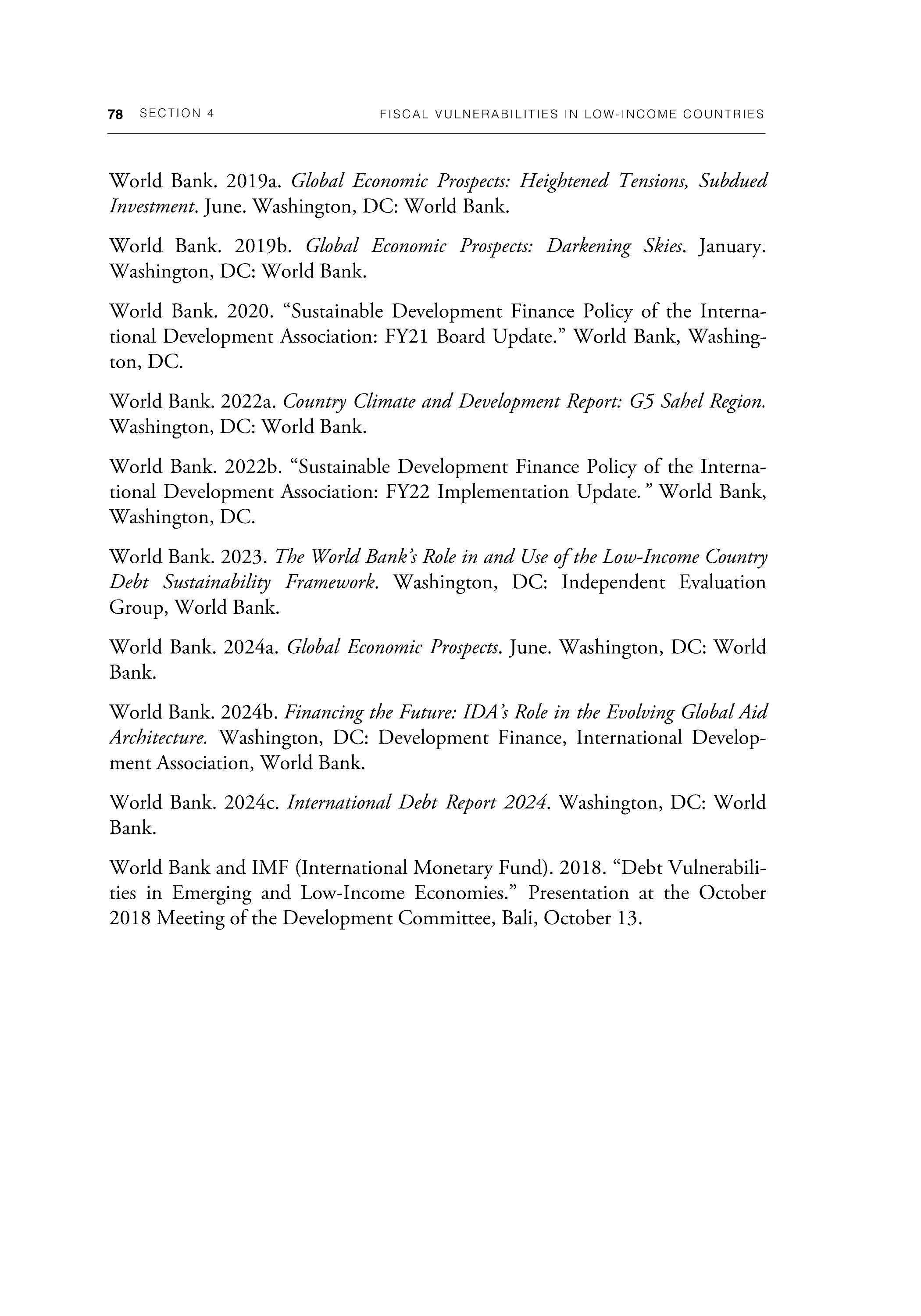
World Bank. 2019a. Global Economic Prospects: Heightened Tensions, Subdued Investment June. Washington, DC: World Bank.
World Bank. 20196 Global Economic Prospects: Darkening Skies. January. Washington, DC: World Bank.
World Bank. 2020. "Sustainable Development Finance Policy of the International Development Association : FY21 Board Update ." World Bank, Washington, DC.
World Bank 2022a. Country Climate and Development Report: G5 Sahel Region Washington, DC: World Bank.
World Bank. 2022b. "Sustainable Development Finance Policy of the International Development Association : FY22 Implementation Update." World Bank, Washington, DC.
World Bank. 2023. The World Bank's Role in and Use of the Low-Income Country Debt Sustainability Framework . Washington, DC: Independent Evaluation Group, World Bank.
World Bank. 2024a. Global Economic Prospects. June. Washington, DC: World Bank.
World Bank. 2024b . Financing the Future: IDA 's Role in the Evolving Global Aid Architecture. Washington, DC: Development Finance, International Development Association, World Bank.
World Bank. 2024c. International Debt Report 2024. Washington, DC: World Bank.
World Bank and IMF (International Monetary Fund) . 2018. "Debt Vulnerabilities in Emerging and Low-Income Economies." Presentation at the October 2018 Meeting of the Development Committee, Bali, October 13 .

5. Conclusion
Low-income countries (LICs) face formidable development challenges, which the pandemic, subsequent global shocks, and more frequent climate-changerelated natural disasters have exacerbated. Meanwhile, their fiscal resources are increasingly constrained. Between 2011 and 2023, ratios of government debt to gross domestic product (GDP) in LICs increased, on average, by 36 percentage points, to 72 percent-much more than the 16 percentage point rise, to 57 percent, in other emerging market and developing economies. Against this backdrop , 12 out of the 26 current LICs were assessed as being in or at high risk of debt distress at the end of April 2024. Vulnerability to global shocks, domestic armed conflicts, and natural disasters worsen LICs' fiscal policy challenges
Significant and widening fiscal deficits, which have outweighed nominal GDP growth, have driven the increase in LIC government debt relative to GDP. The COVID-19 pandemic, which sharply increased LICs' spending needs, elevated primary deficits in 2020 to 3.4 percent of GDP from 1.2 percent of GDP in 2019. Despite a post-pandemic growth rebound, LICs have been unable to unwind their fiscal deficits since 2020 because of subsequent shocks, including the rise in global interest rates and ensuing currency depreciations amid declining levels of official development assistance. The increase in primary expenditures in LI Cs of 1.7 percentage points of GDP between 2011 and 2023 was double the increase in their revenues over the same period. On average, LICs had government revenues of about 18 percent of GDP during 2011-23, 11 percentage points less than other emerging market and developing economies. Some LICs have recently spent more on interest payments than on such priority sectors as health services.
The deterioration in LICs' fiscal positions and their substantial public financing needs call for a renewed effort to mobilize their domestic revenues, increase the efficiency of their public spending, improve their debt management , and institute reforms to improve their long-term growth prospects. LICs need to establish and maintain robust fiscal frameworks to reduce and manage their fiscal risks over the longer term . Financial assistance from the international
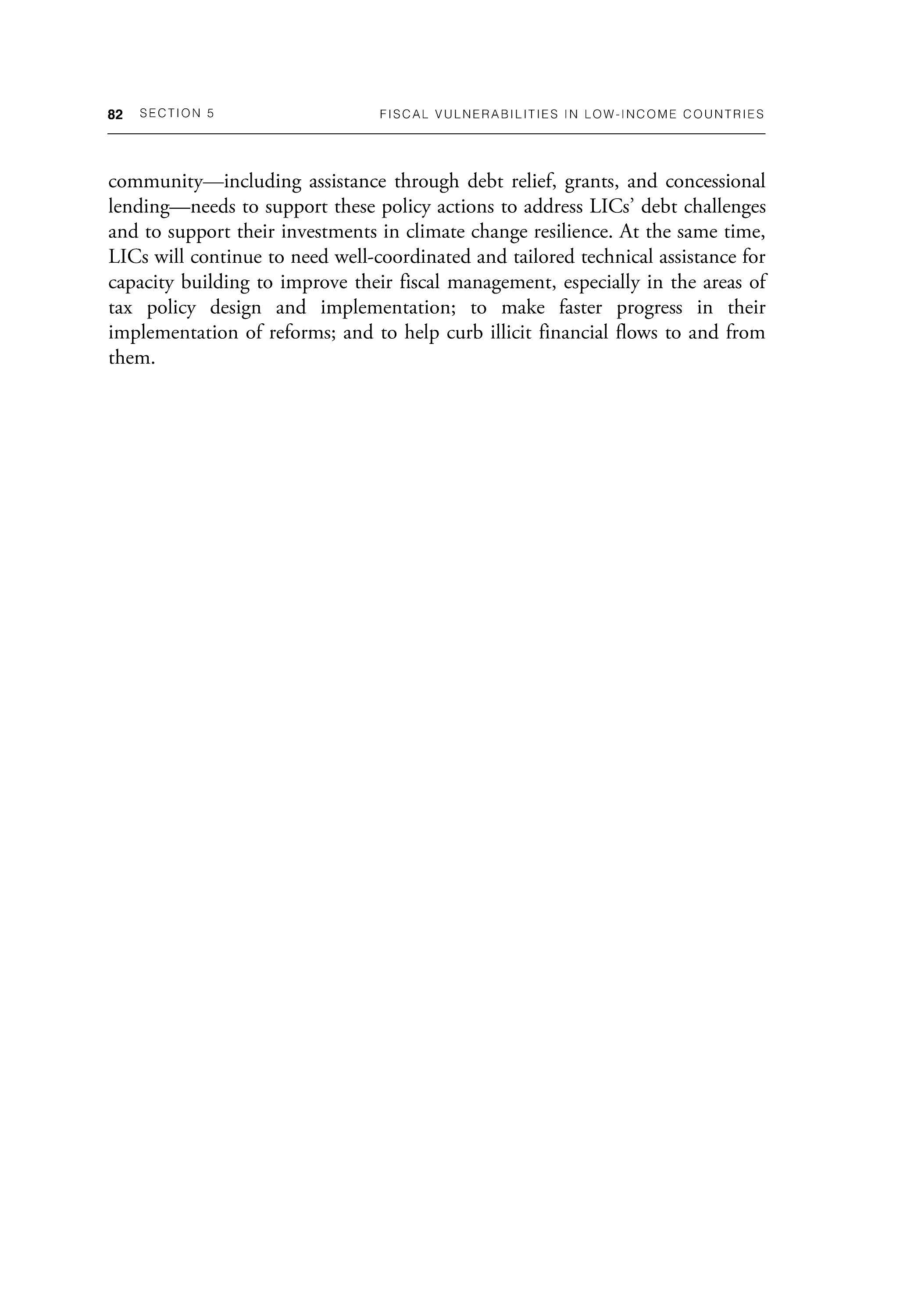
community-including assistance through debt relief, grants, and concessional lending-needs to support these policy actions to address LICs' debt challenges and to support their investments in climate change resilience. At the same time, LICs will continue to need well-coordinated and tailored technical assistance for capacity building to improve their fiscal management, especially in the areas of tax policy design and implementation; to make faster progress in their implementation of reforms; and to help curb illicit financial flows to and from them .
FISCA L V ULNERA B ILITIE S I N LOW-I N COME CO UNTRI ES
APPENDIX 1 Decomposition of debt
Changes in ratios of public debt to gross domestic product (GDP) [denoted by d in equation (Al .1)] can be decomposed into a number of explanatory factors (World Bank 2024). Specifically, changes in debt over time can be decomposed into contributions from primary fiscal balances (the difference between revenues and noninterest expenditures), output growth, interest rates, inflation, and other factors . 13 In a highly stylized version, this accounting decomposition is the following :
In equation (Al .1), government debt d, and the primary balance pb , are scaled by GDP Real output growth is g, , inflation (defined as growth in the GDP deflator) is n,, and the weighted average of foreign and domestic nominal interest rates is i ,. The term other factors includes factors such as exchange rate depreciation, privatization proceeds, and the materialization of contingent liabilities or other ad hoc changes to debt stocks. Equation (Al. 1) can be reorganized to identify the contributions to changes in the debt-to-GDP ratio from key components in additive form as follows:
in which
Equation (Al .2) is used as the basis for decomposing the change in the debt-toGDP ratio into its attributable components : (1) the primary fiscal balance, (2) interest costs, (3) inflation, and (4) real GDP growth. Because of data limitations for the countries of interest, notably in regard to data on ad hoc debt stock adjustments and the currency composition of debt, the contributions from other factors are calculated as the difference between changes in the debt-to-GDP ratio and the sum of components (1) to (4). The decomposition includes all lowincome countries (LICs) for which data are available for all terms in equation (Al.2) for the period 2011 to 2023, as detailed in table ALB .
Reference
World Bank. 2024. Global Economic Prospects. June. Washington, DC: World Bank.
13 Th e d eta il ed decomposition req uires d ata on fore ign- curren cy- de nominated shares of gove rnm ent debt Th ese data are ava il abl e only fo r 2018 and only for 2 U Cs (D emo cratic Repub lic of Congo, U gand a) an d 89 emergin g m ar ket and d evelo ping eco no mi es (EMDEs). Foreign-currency-denominated shares of gove rnm ent debt in 2019 are assumed to remain constant at 2018 values and, for U Cs a nd non-U C EMDE s for which d ata are missing, are assumed to be the same as th e average fo r U Cs or that for non -UC EMO Es, respectively
(Al.I)
(Al .2)
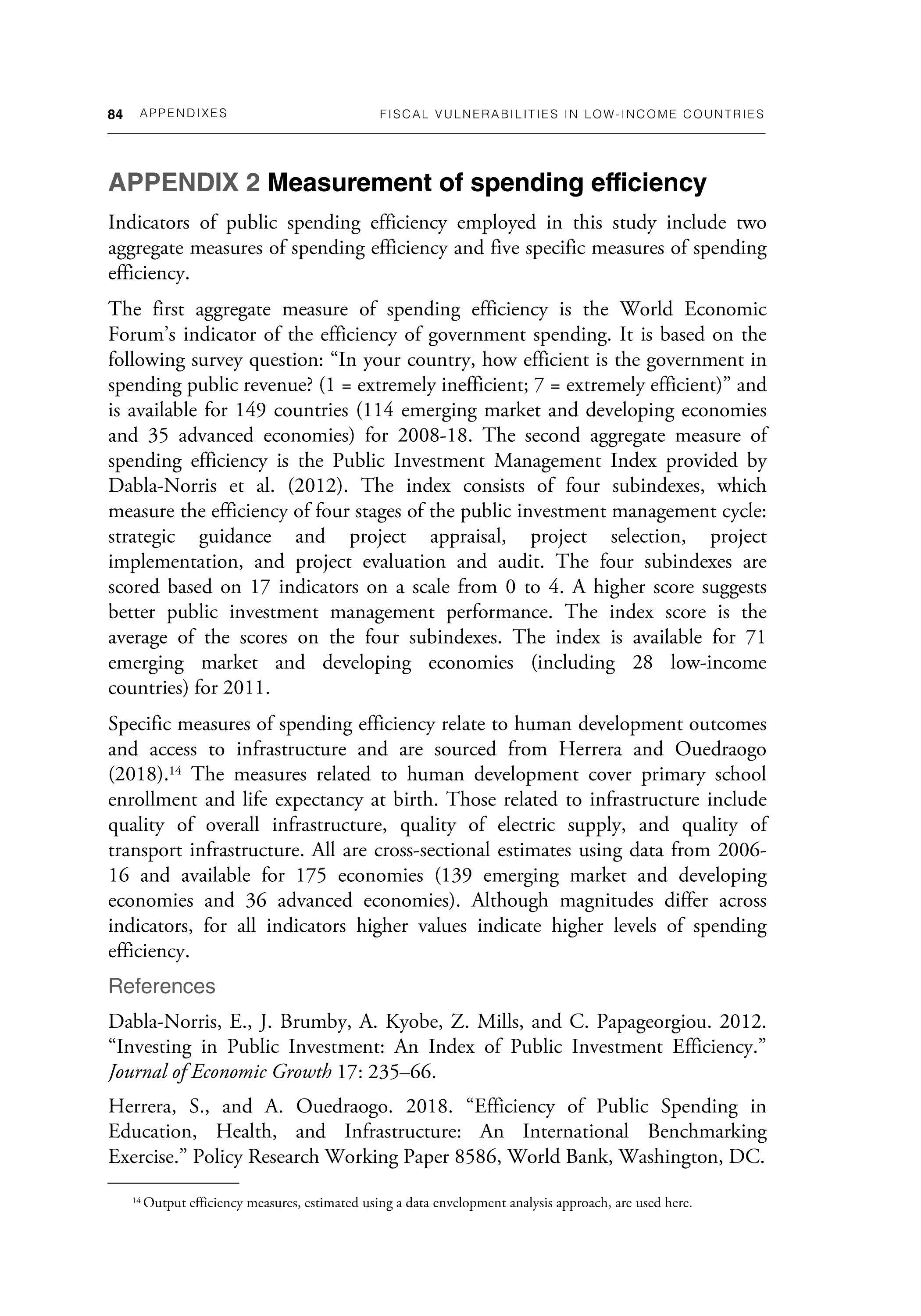
APPENDIX 2 Measurement of spending efficiency
Indicators of public spending efficiency employed in this study include two aggregate measures of spending efficiency and five specific measures of spending efficiency.
The first aggregate measure of spending efficiency is the World Economic Forum's indicator of the efficiency of government spending. It is based on the following survey question : "In your country, how efficient is the government in spending public revenue? (1 = extremely inefficient; 7 = extremely efficient)" and is available for 149 countries (114 emerging market and developing economies and 35 advanced economies) for 2008-18. The second aggregate measure of spending efficiency is the Public Investment Management Index provided by Dabla-Norris et al. (2012). The index consists of four subindexes, which measure the efficiency of four stages of the public investment management cycle: strategic guidance and project appraisal, project selection, project implementation, and project evaluation and audit . The four subindexes are scored based on 17 indicators on a scale from 0 to 4. A higher score suggests better public investment management performance. The index score is the average of the scores on the four subindexes. The index is available for 71 emerging market and developing economies (including 28 low-income countries) for 2011.
Specific measures of spending efficiency relate to human development outcomes and access to infrastructure and are sourced from Herrera and Ouedraogo (2018). 14 The measures related to human development cover primary school enrollment and life expectancy at birth. Those related to infrastructure include quality of overall infrastructure, quality of electric supply, and quality of transport infrastructure. All are cross-sectional estimates using data from 200616 and available for 175 economies (139 emerging market and developing economies and 36 advanced economies). Although magnitudes differ across indicators, for all indicators higher values indicate higher levels of spending efficiency.
References
Dabla-Norris, E., J. Brumby, A. Kyobe, Z. Mills, and C. Papageorgiou. 2012. "Investing in Public Investment: An Index of Public Investment Efficiency." Journal ofEconomic Growth 17: 235-66.
Herrera, S., and A. Ouedraogo . 2018. "Efficiency of Public Spending in Education, Health, and Infrastructure: An International Benchmarking Exercise." Policy Research Working Paper 8586, World Bank, Washington, DC.
14 Output efficiency measures , estimated using a data envelopment analysis approach , are used here
APPENDIX 3 Event studies
The event study analysis considered in this study follows earlier work by Kose et al. (2022), who examined the evolution of fiscal space around a set of defined adverse events The following regression model is estimated: (A3.1)
in which measures each of the fiscal policy outcomes (primary balance and debt) in country and year and is the country fixed effect. The variable refers to each of three adverse events (global recessions, intense conflict, and natural disasters) and is defined as a dummy taking the value of one if an event occurs in country and year are time effects included to control for global factors, and is an error term
A series of coefficients show the effects of adverse events over (2 + 1) years, relative to other nonevent (normal) years, in which p is the number of pre-event and postevent years included in equation (A3.1). In line with Kose et al. (2022), this study uses = 2. This econometric exercise is not intended to uncover any causal relationships. Instead, the objective is to describe how fiscal policy variables evolve during specific events.
Identification ofevents
Global recessions. Years of global recessions since 2000 (2009 and 2020) are identified in Kose, Sugawara, and Terrones (2020). Global recessions are associated with contractions in annual real per capita global gross domestic product and broad-based weaknesses in other key indicators of global economic activity.
Intense conflicts. Intense conflicts are identified based on battle-related deaths in the Uppsala Conflict Data Program (UCDP) Battle-Related Deaths Dataset, version 24.1 (Davies et al. 2024). The analysis is restricted to conflicts with more than 100 hundred deaths (as best estimates) per 1 million population . If several conflicts are identified within five years, the one associated with the largest number of deaths per million people is selected . In total, 141 intense conflicts are identified in 25 low-income countries during 2000-23.
Natural disasters. Natural disasters are identified using data from EM-DAT: The International Disaster Database, which is managed by the Centre for Research on the Epidemiology of Disasters. As identified in this study, natural disasters include droughts, earthquakes, extreme temperatures, floods, storms, volcanic activity, and wildfires. The analysis is restricted to events that are associated with estimated losses of at least one-half of a percentage point of gross
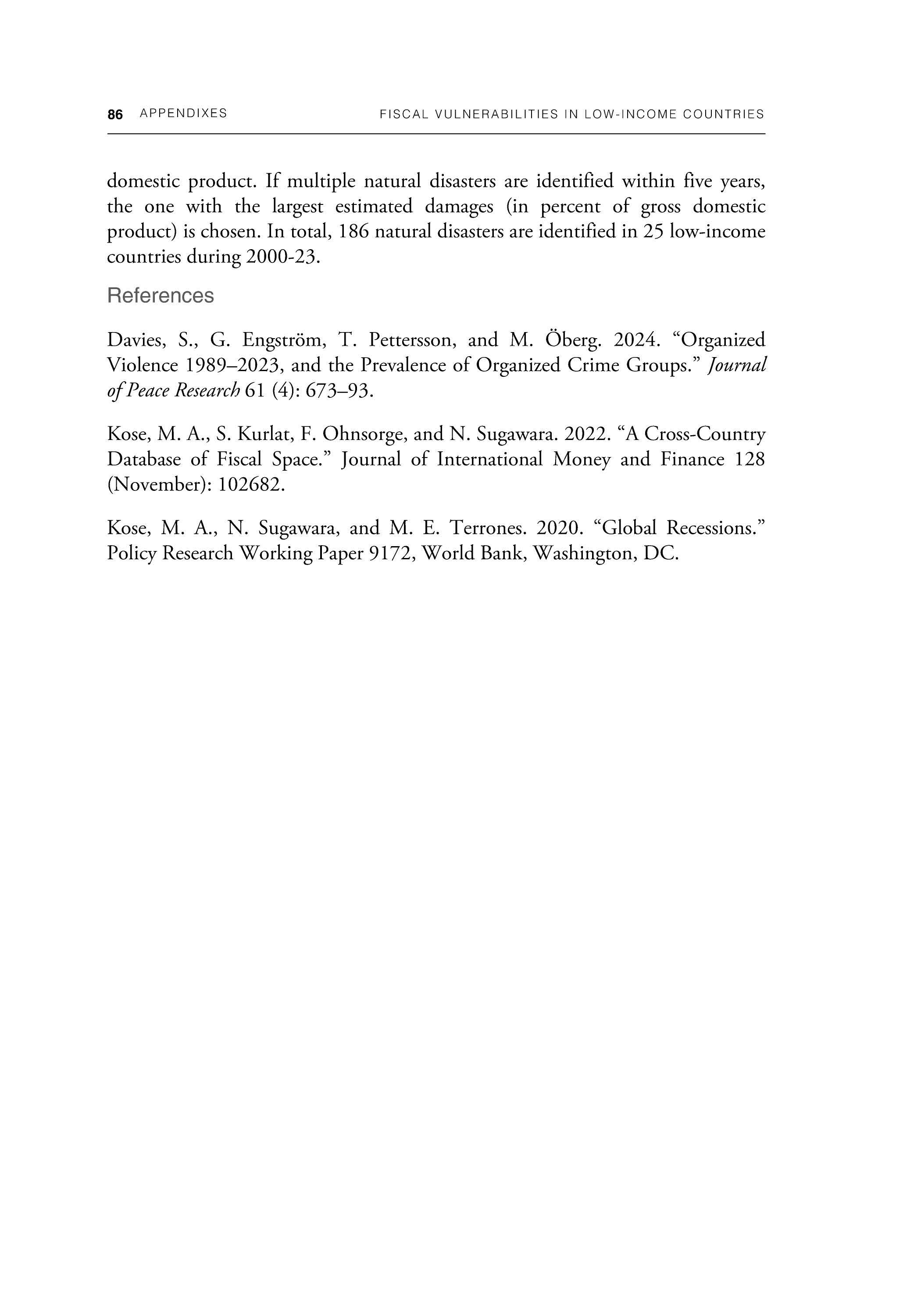
domestic product . If multiple natural disasters are identified within five years, the one with the largest estimated damages (in percent of gross domestic product) is chosen. In total, 186 natural disasters are identified in 25 low-income countries during 2000-23.
References
Davies , S., G. Engstrom, T . Pett ersson, and M. Ob erg. 2024. "Organized Violence 1989-2023, and the Prevalence of Organized Crime Groups." Journal ofPeace Research 61 (4) : 673-93 .
Ko se, M . A. , S. Kurlat , F . Ohnsorge, and N . Sugawara . 2022. " A Cross-Country Database of Fiscal Space." Journal of International Money and Finance 128 (November): 102682.
Kose, M. A. , N. Sugawara , and M E Terrones. 2020. " Global Recessions." Policy Re search Working Paper 9172, World Bank, Washington, DC.
TABLE A 1 List of low-income countries
List of all LICs included
Afghanistan
Burundi
Burkina Faso
Central African Republic
Chad
Congo , Dem. Rep.
Eritrea
Ethiopia
Gambia , The
Guinea-Bissau
Korea , Dem People ' s Rep
Liberia
Madagascar
Mali
Mozambique
Malawi
Niger
Rwanda
Sudan
Sierra Leone
Somalia
South Sudan
Syrian Arab Republic
Togo
Uganda
Yemen , Rep
Afghanistan
Burundi
Burkina Faso
Central African Republic
Chad
Congo , Dem Rep
Eritrea
Ethiopia
Source: World Bank
Gambia , The
Guinea-Bissau
Liberia
Madagascar
Mali
Mozambique
Malawi
Niger
Rwanda
Sudan
Sierra Leone
Togo
Uganda
Yemen , Rep .
ECO-AUDIT
Environmental Benefits Statement
The World Bank Group is committed to reducing its environmental footprint. In support of this commitment, we leverage electronic publishing options and print-on-demand technology, which is located in regional hubs worldwide. Together, these initiatives enable print runs to be lowered and shipping distances decreased, resulting in reduced paper consumption, chemical use, greenhouse gas emissions, and waste.
We follow the recommended standards for paper use set by the Green Press Initiative. The majority of our books are printed on Forest Stewardship Council (FSC)-certifled paper, with nearly all have PCW recycled content. The recycled fiber in our book paper is either unbleached or bleached using totally chlorinefree (TCF), processed chlorine-free (PCF), or enhanced elemental chlorine-free (EECF) processes.
More information about the Bank's environmental philosophy can be found at http://www.worldbank.org/ corporateresponsibili ty.

